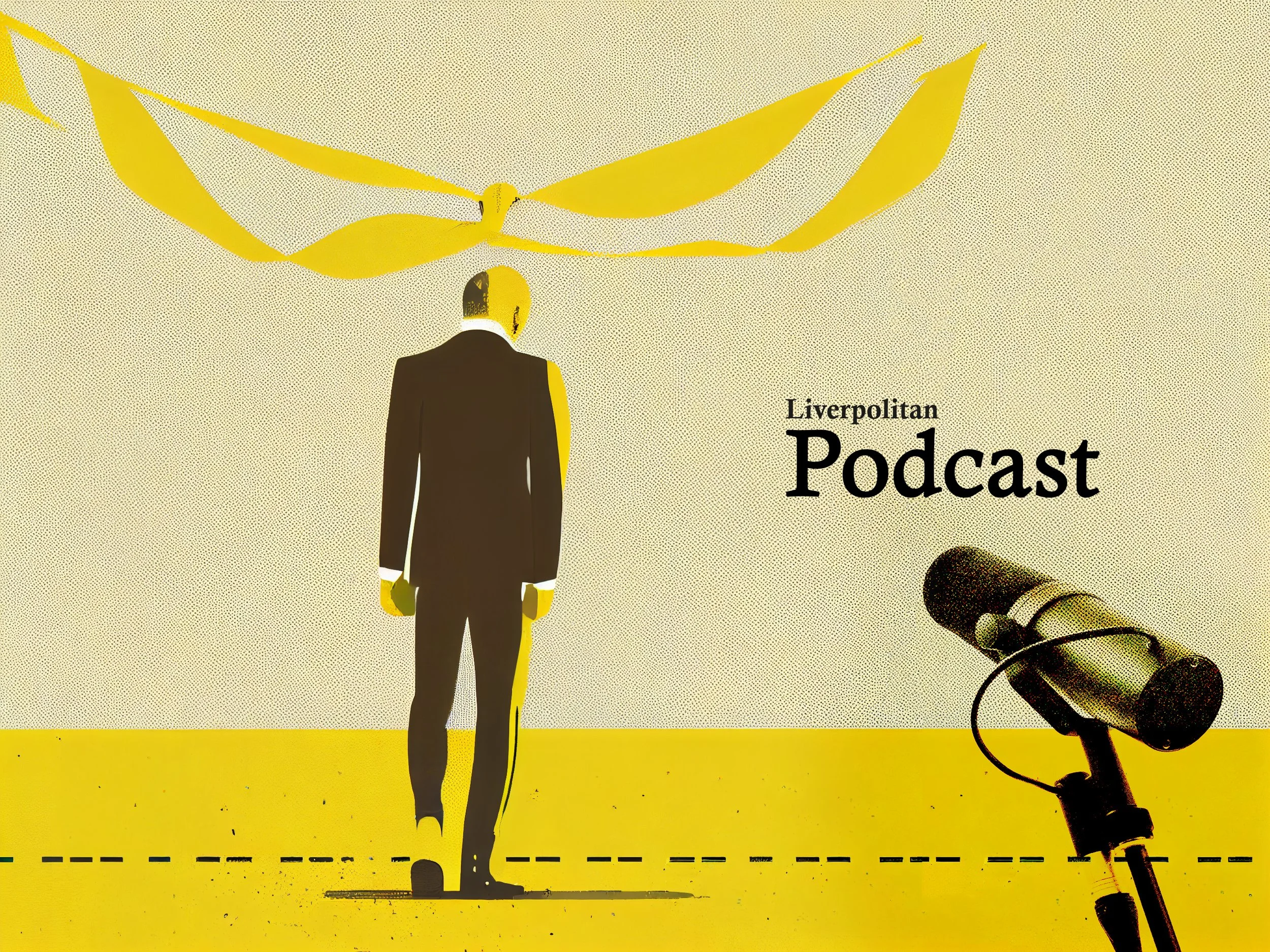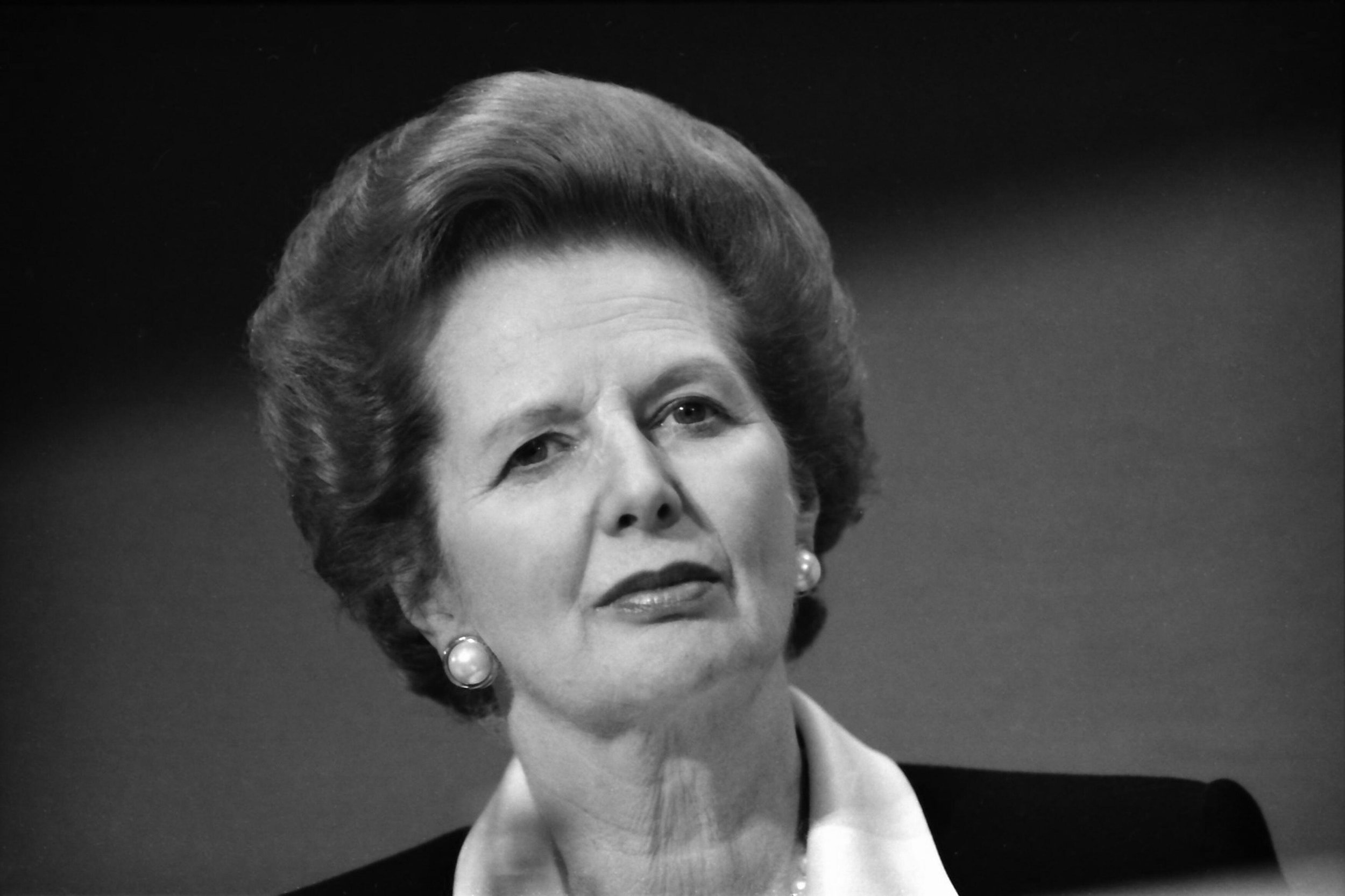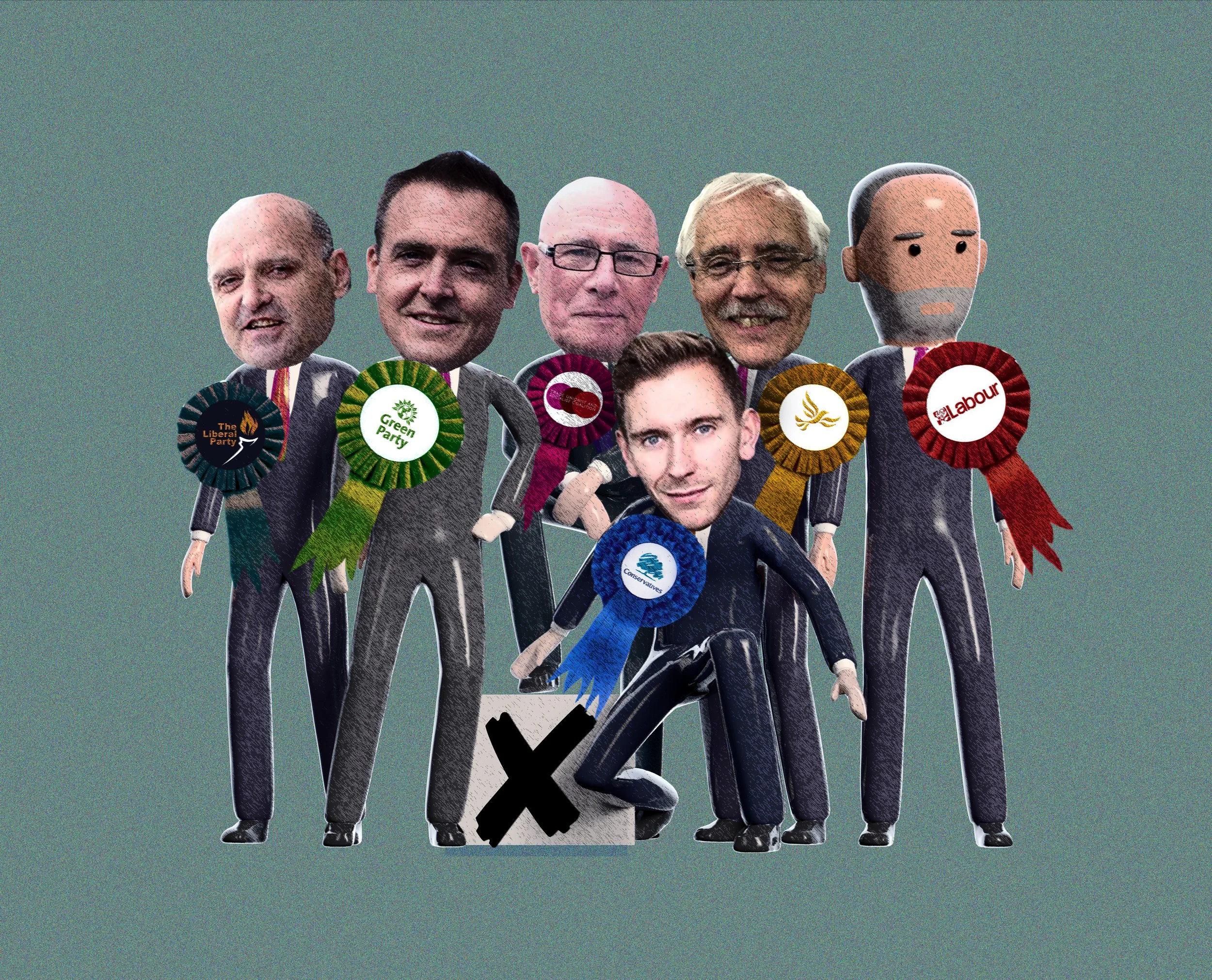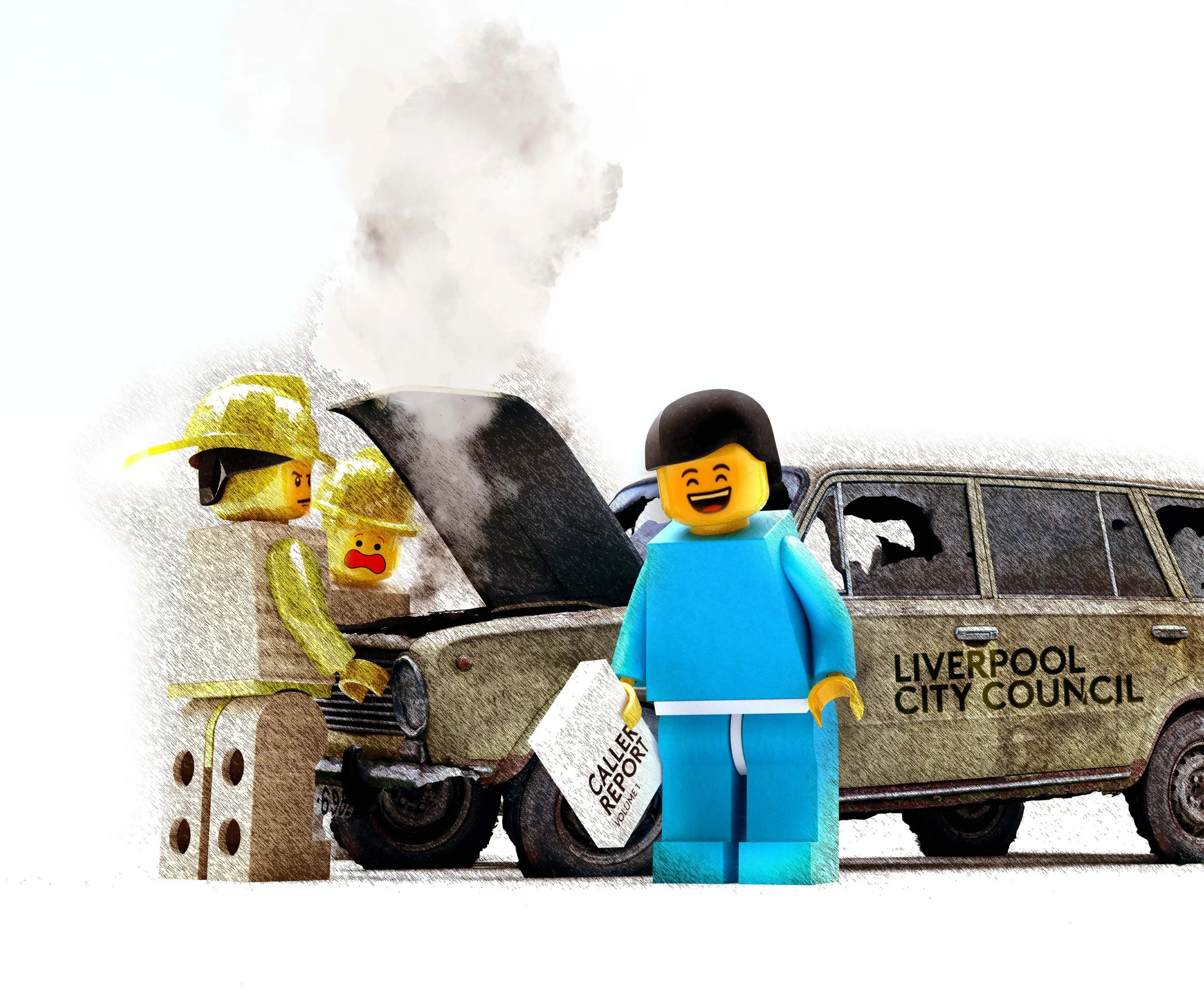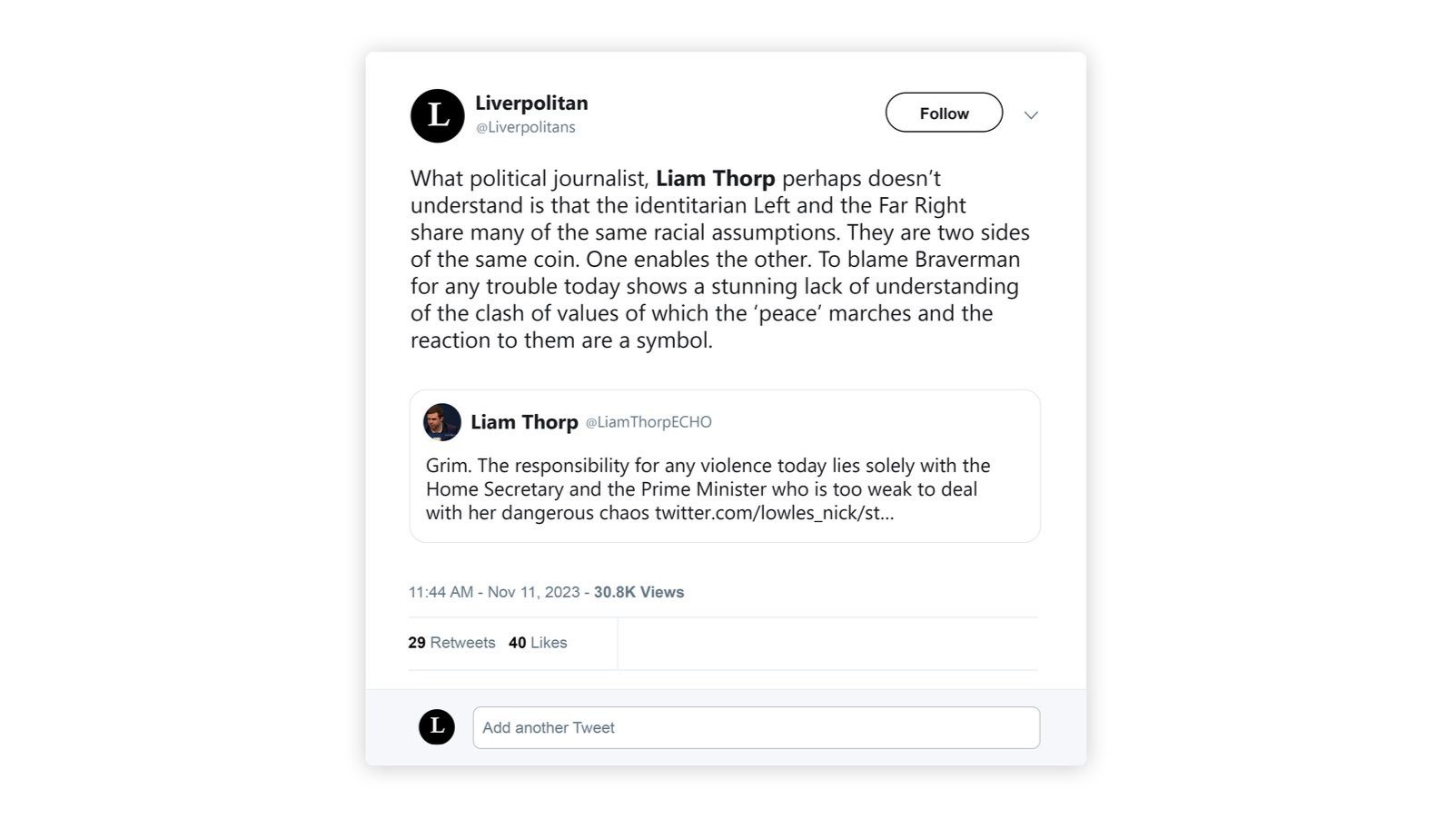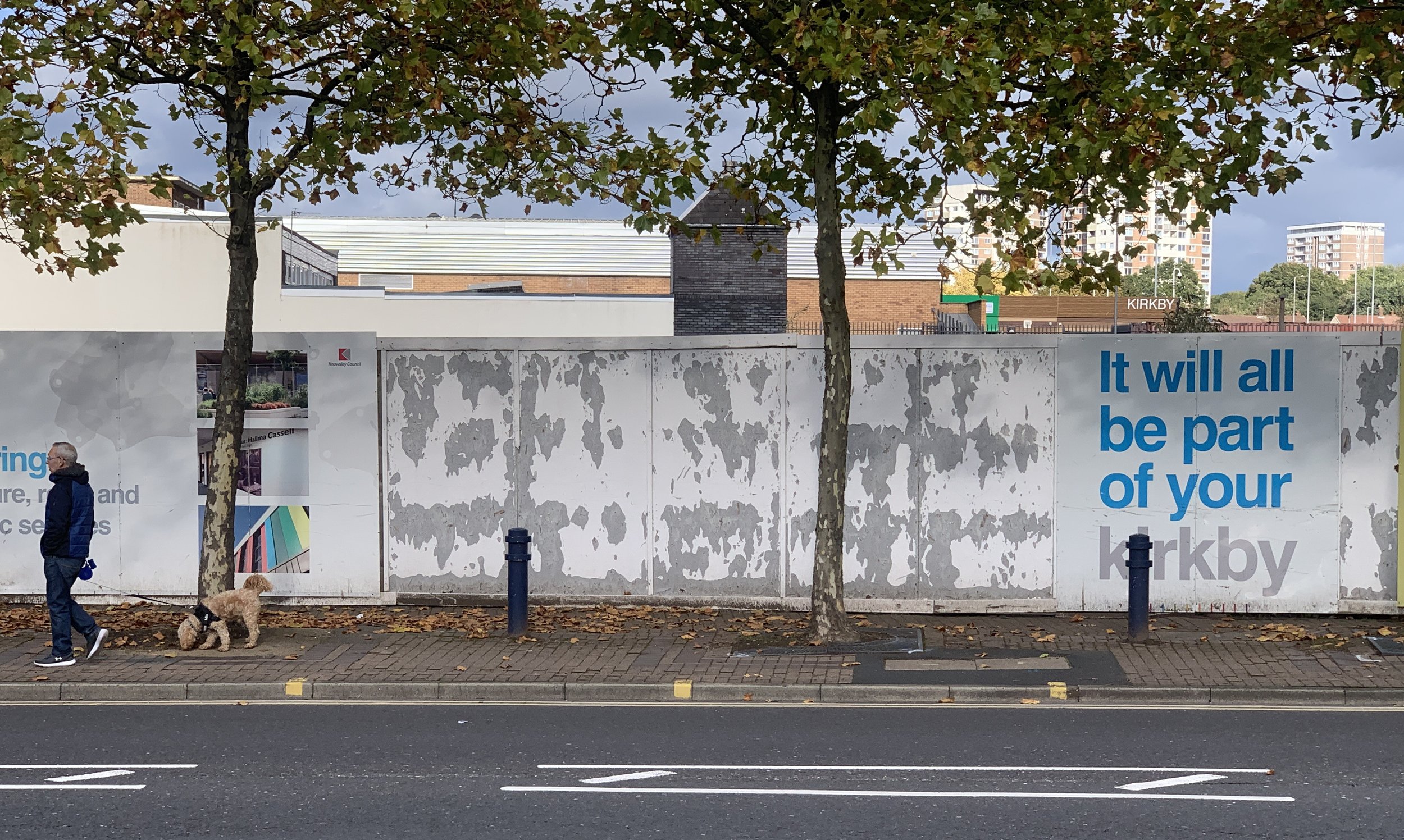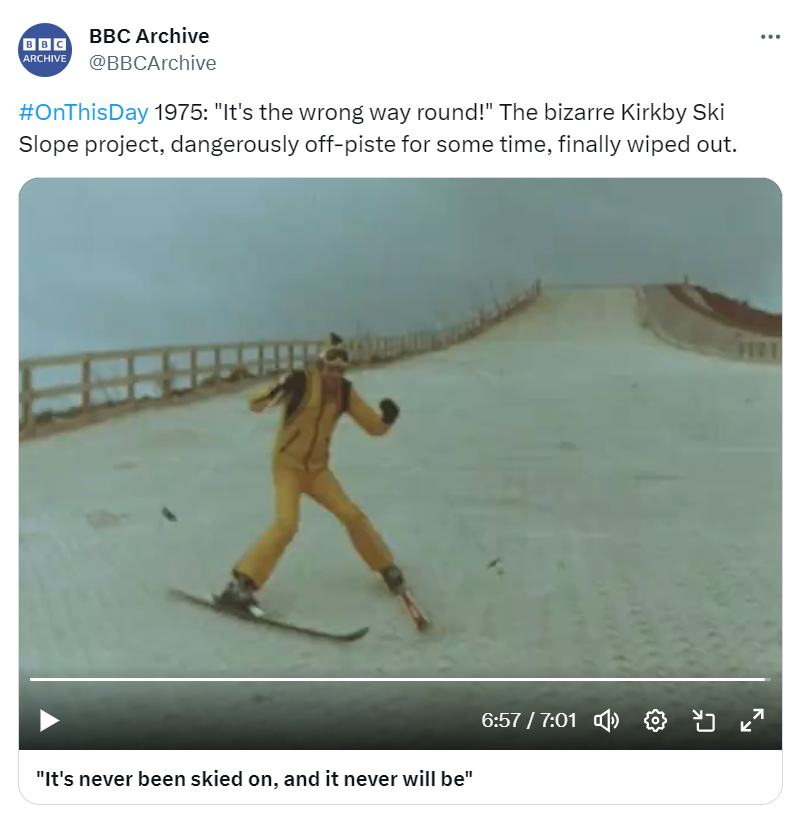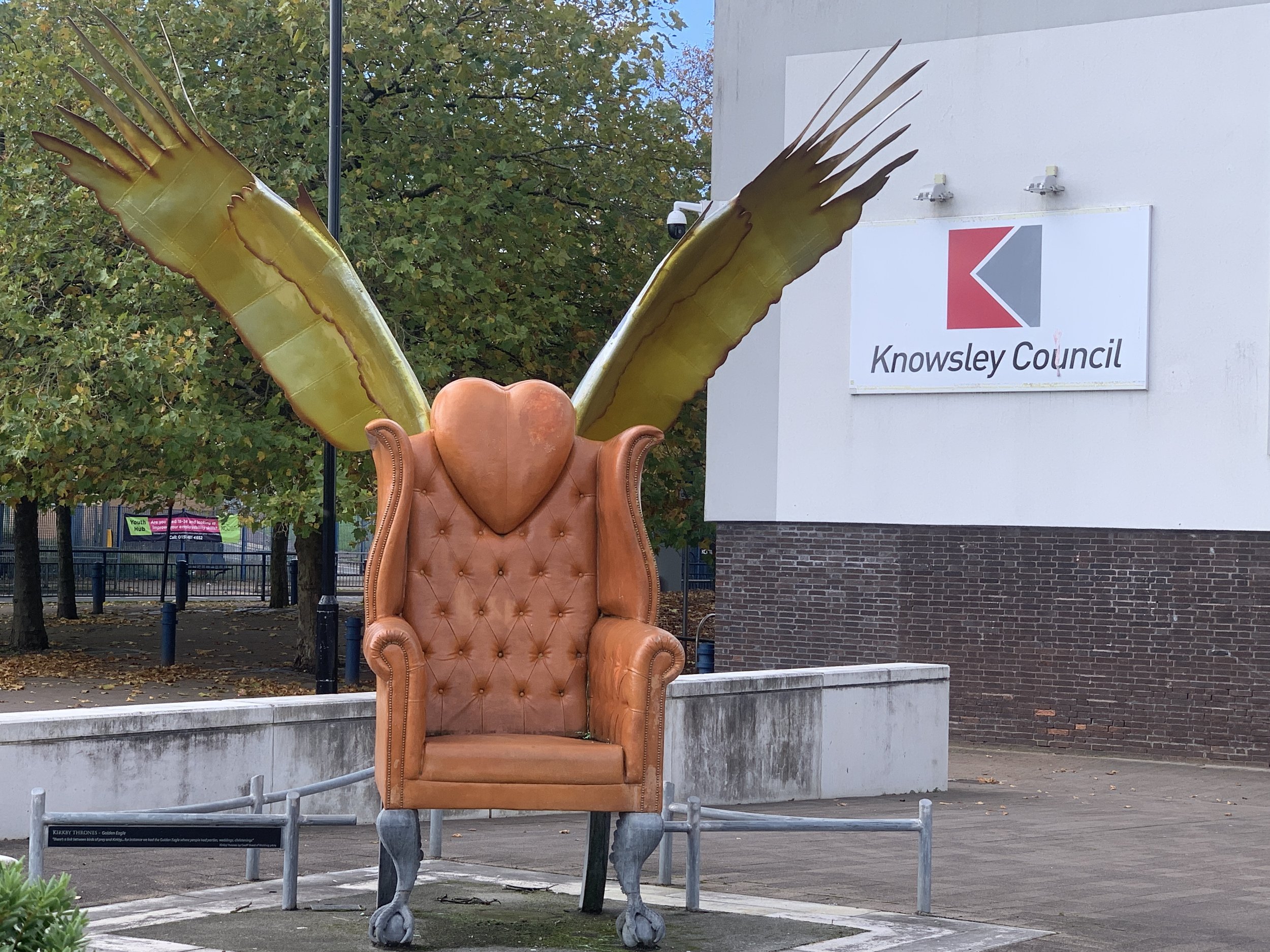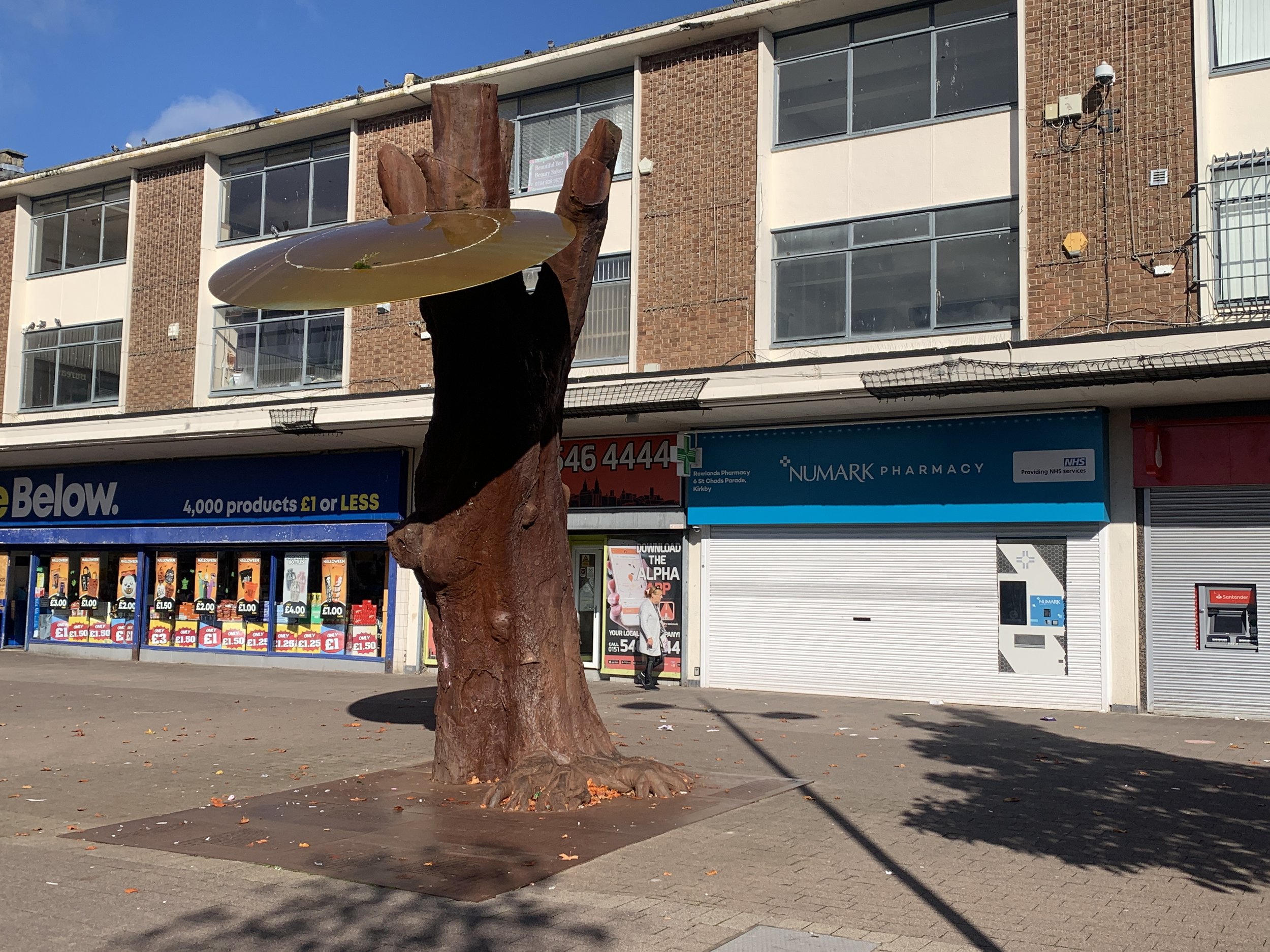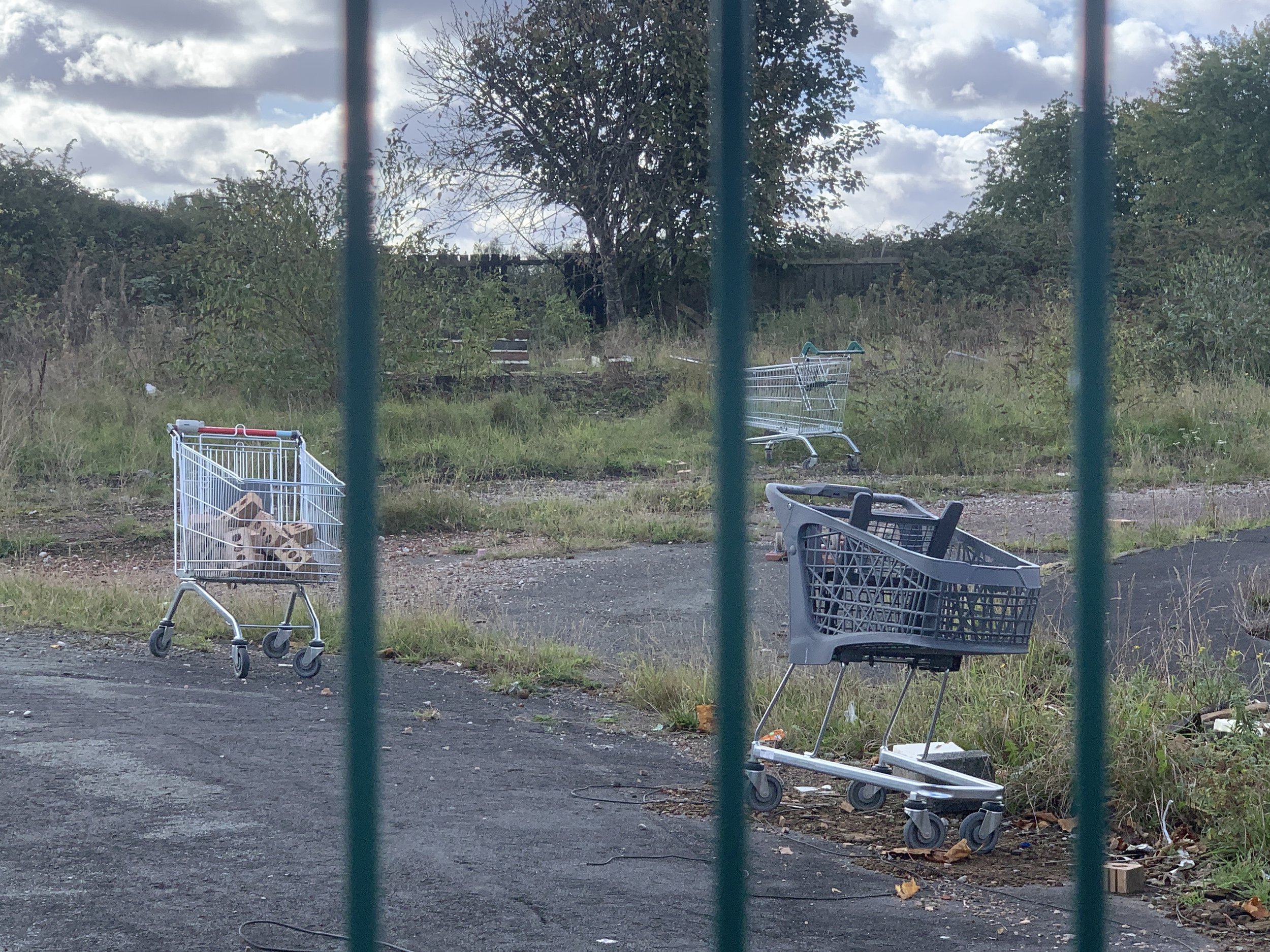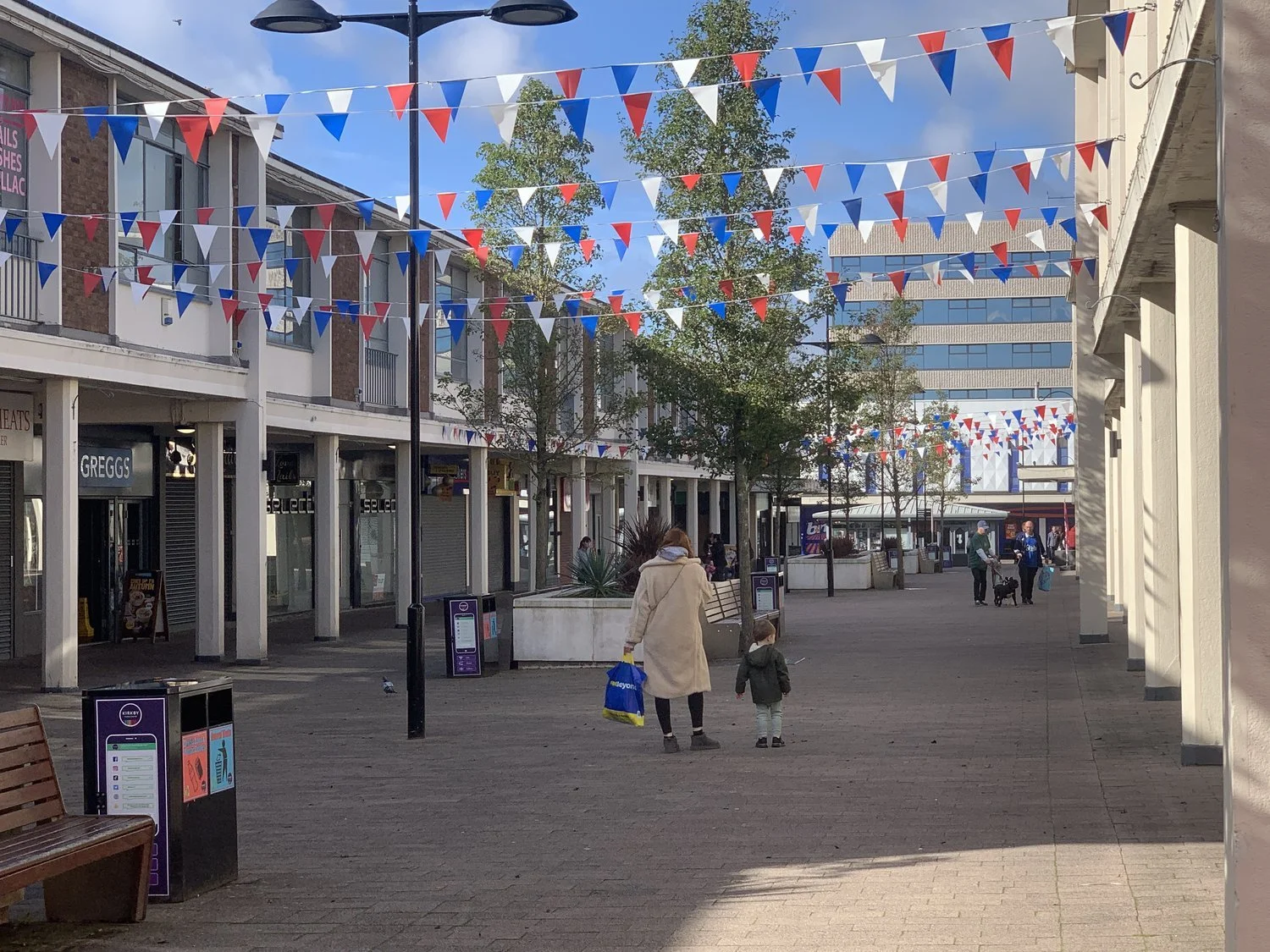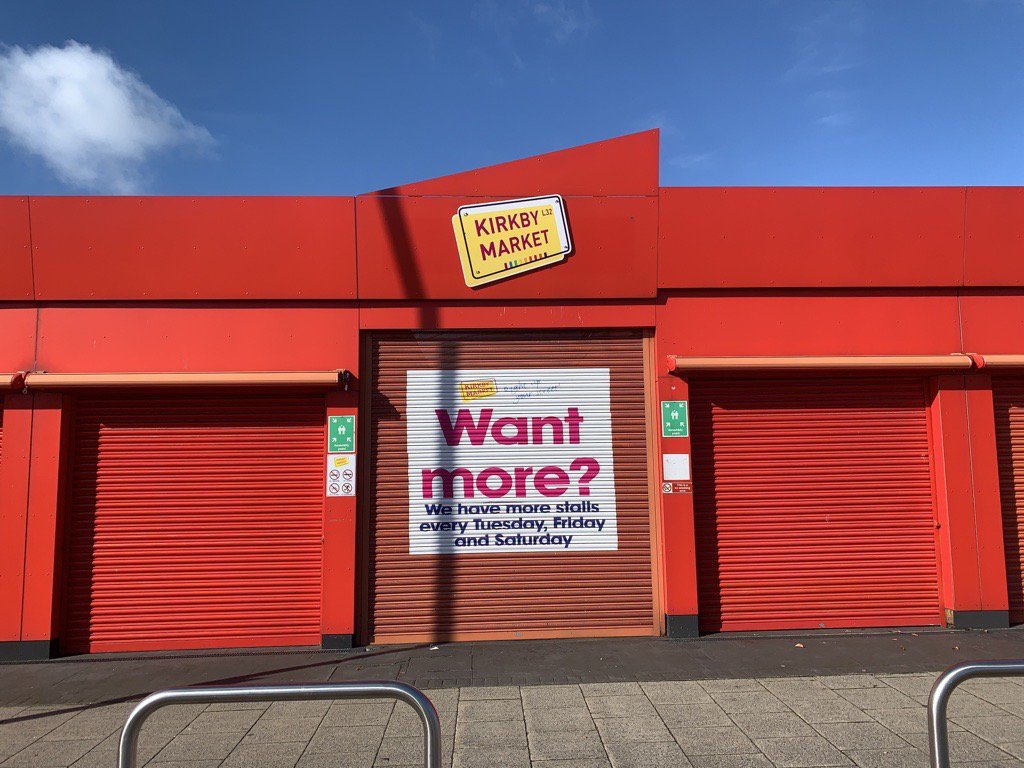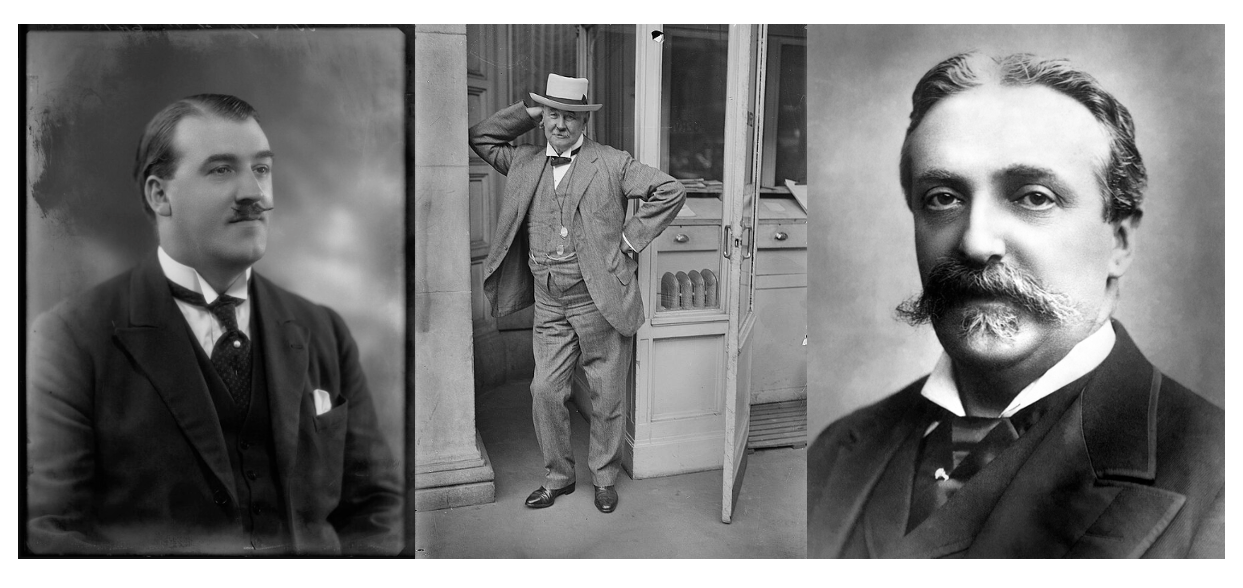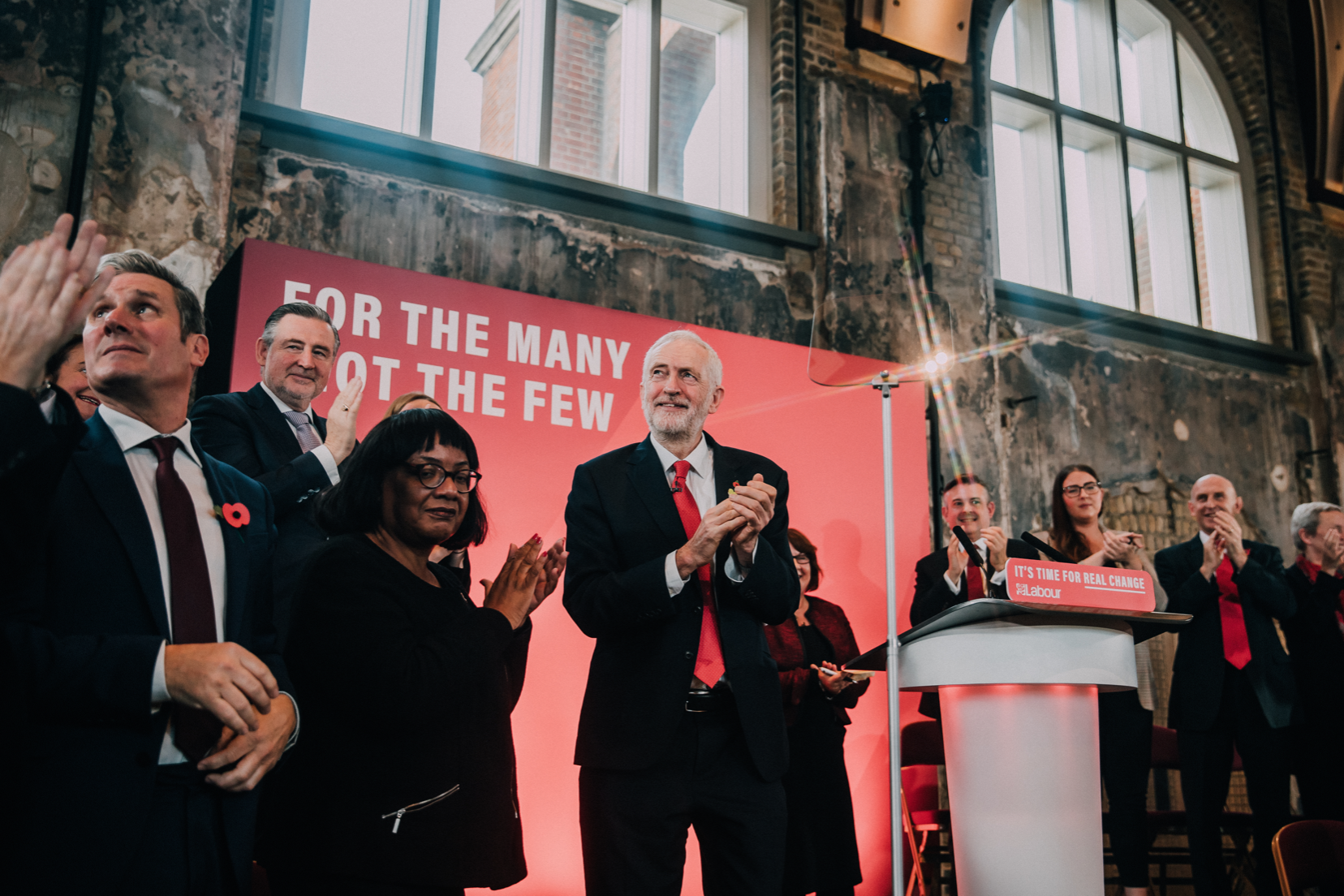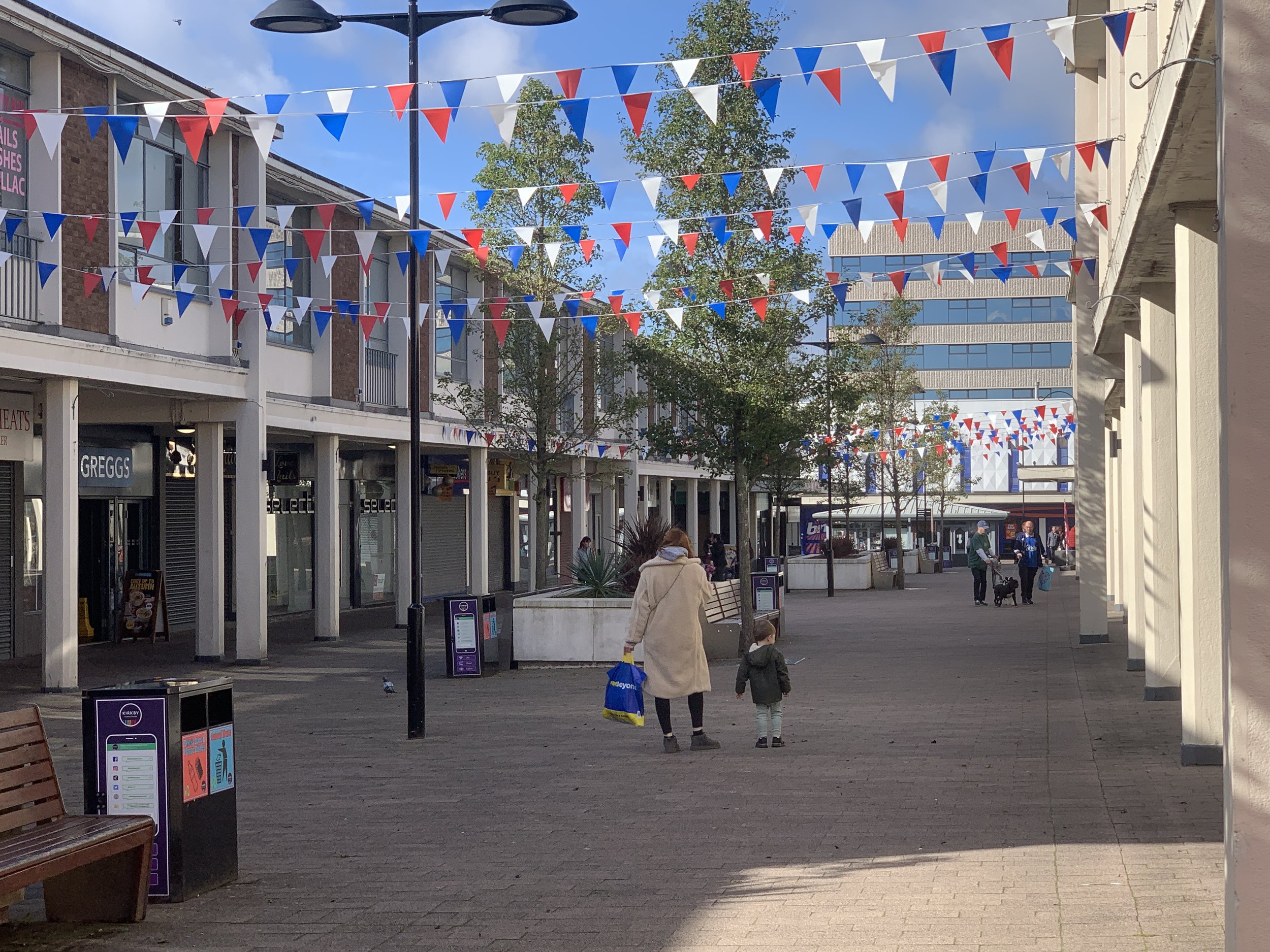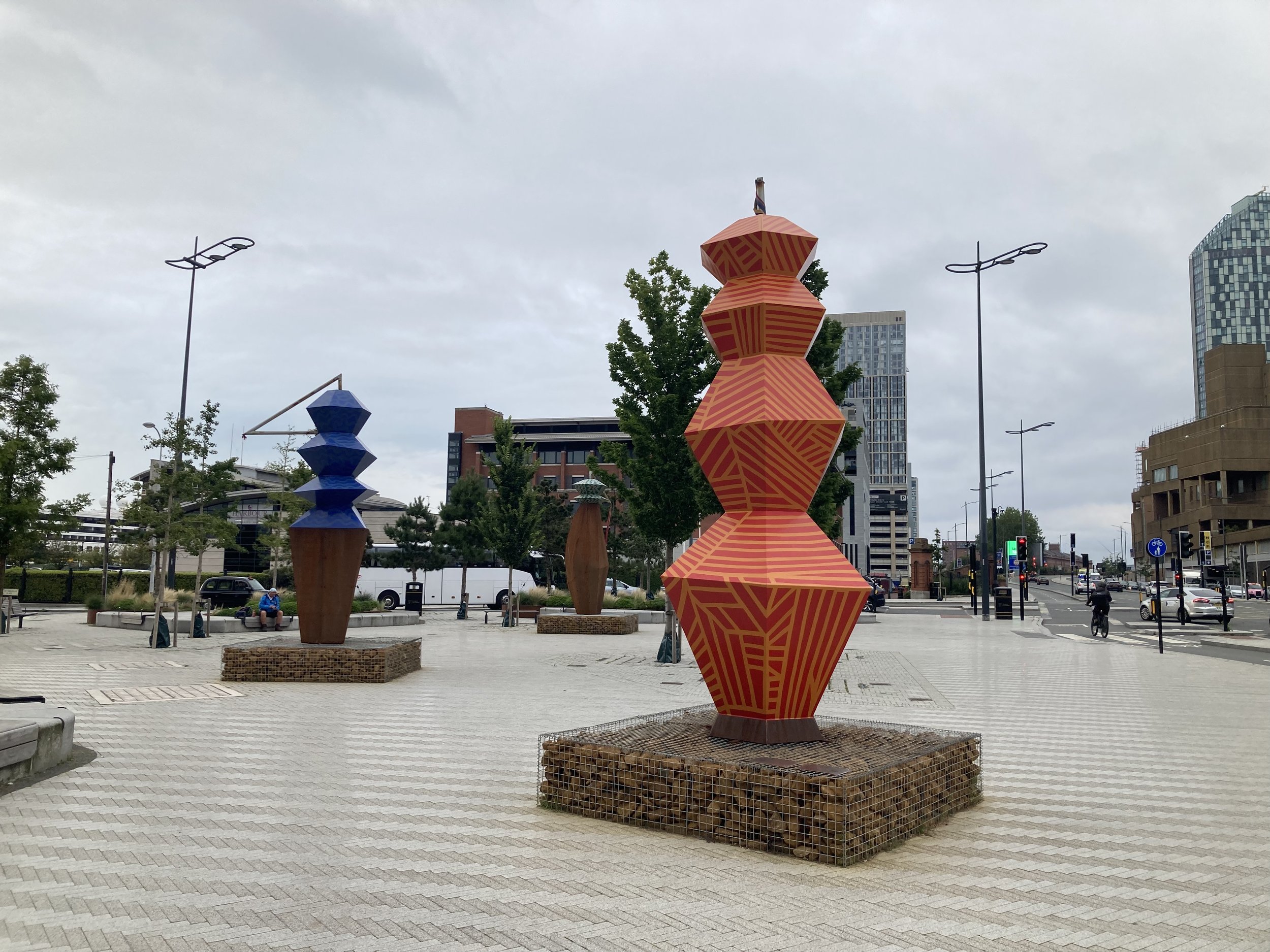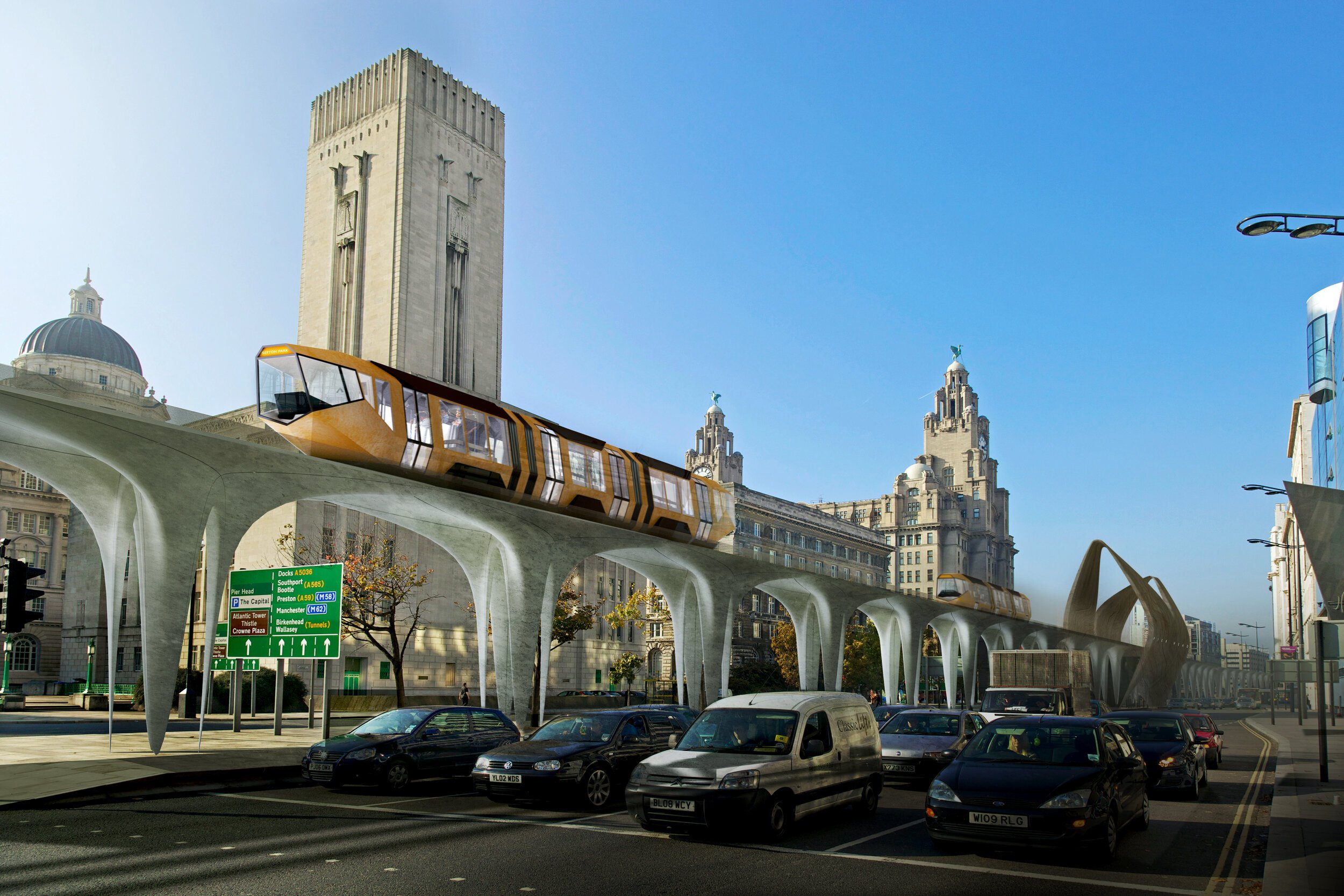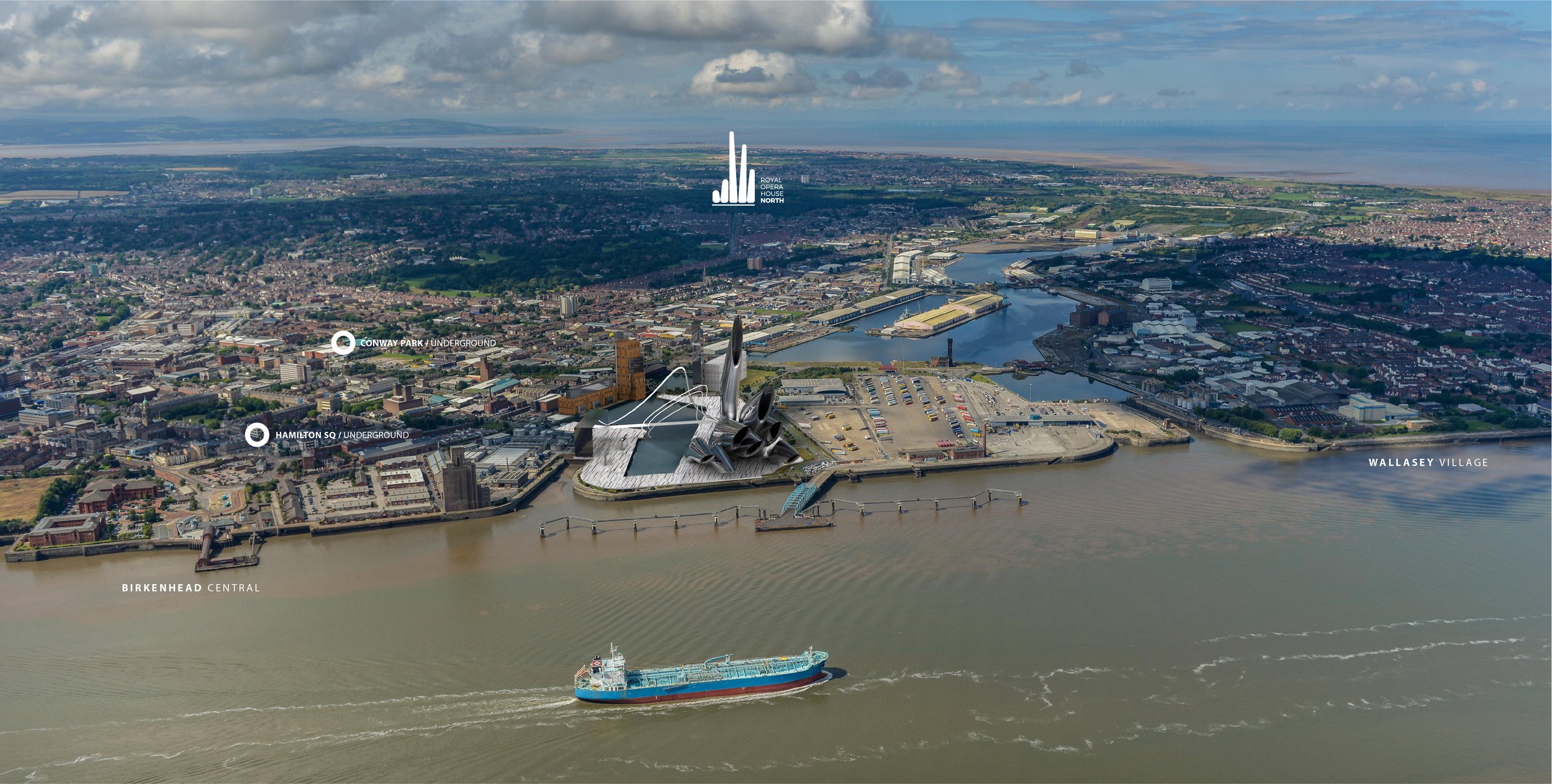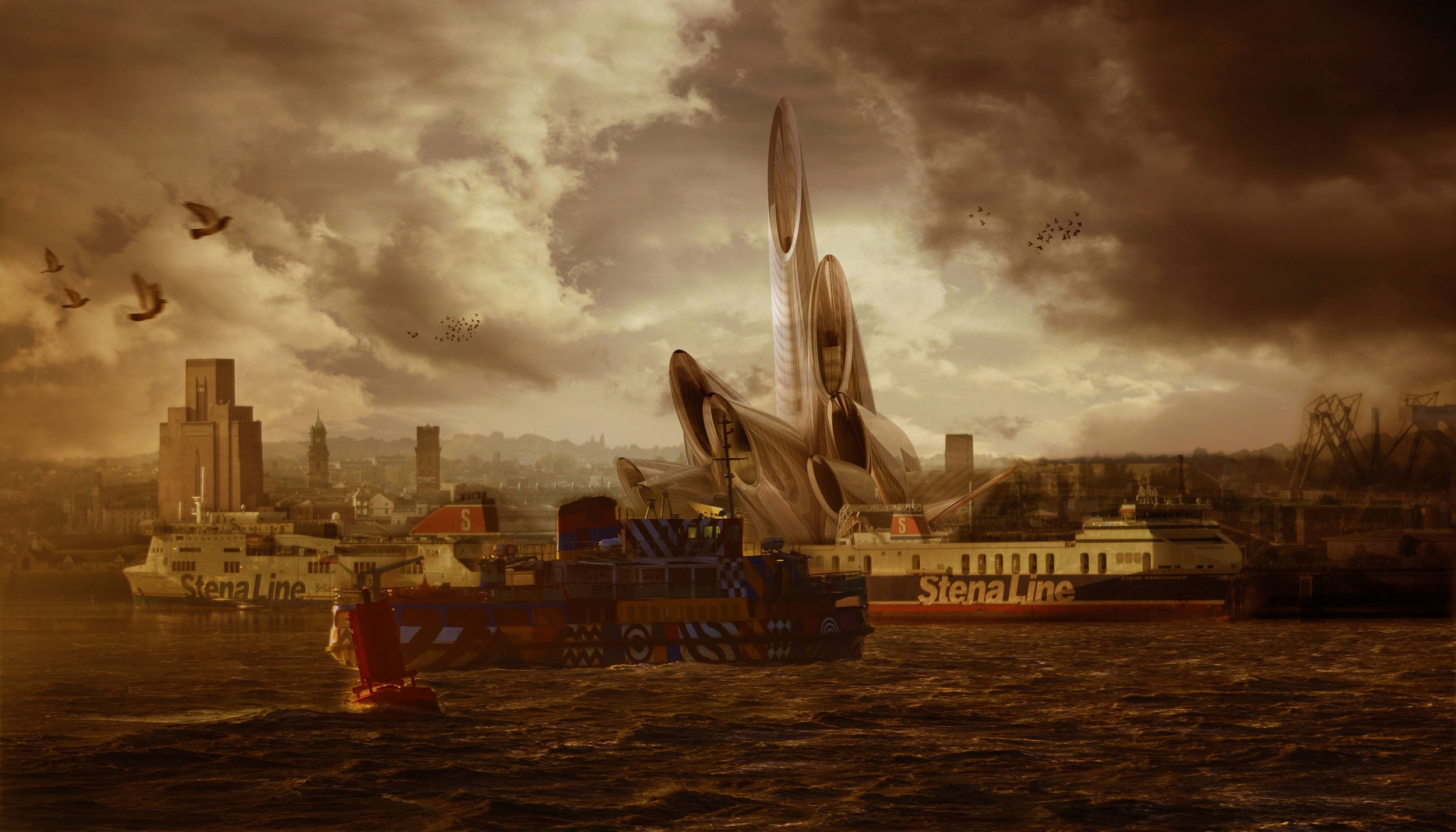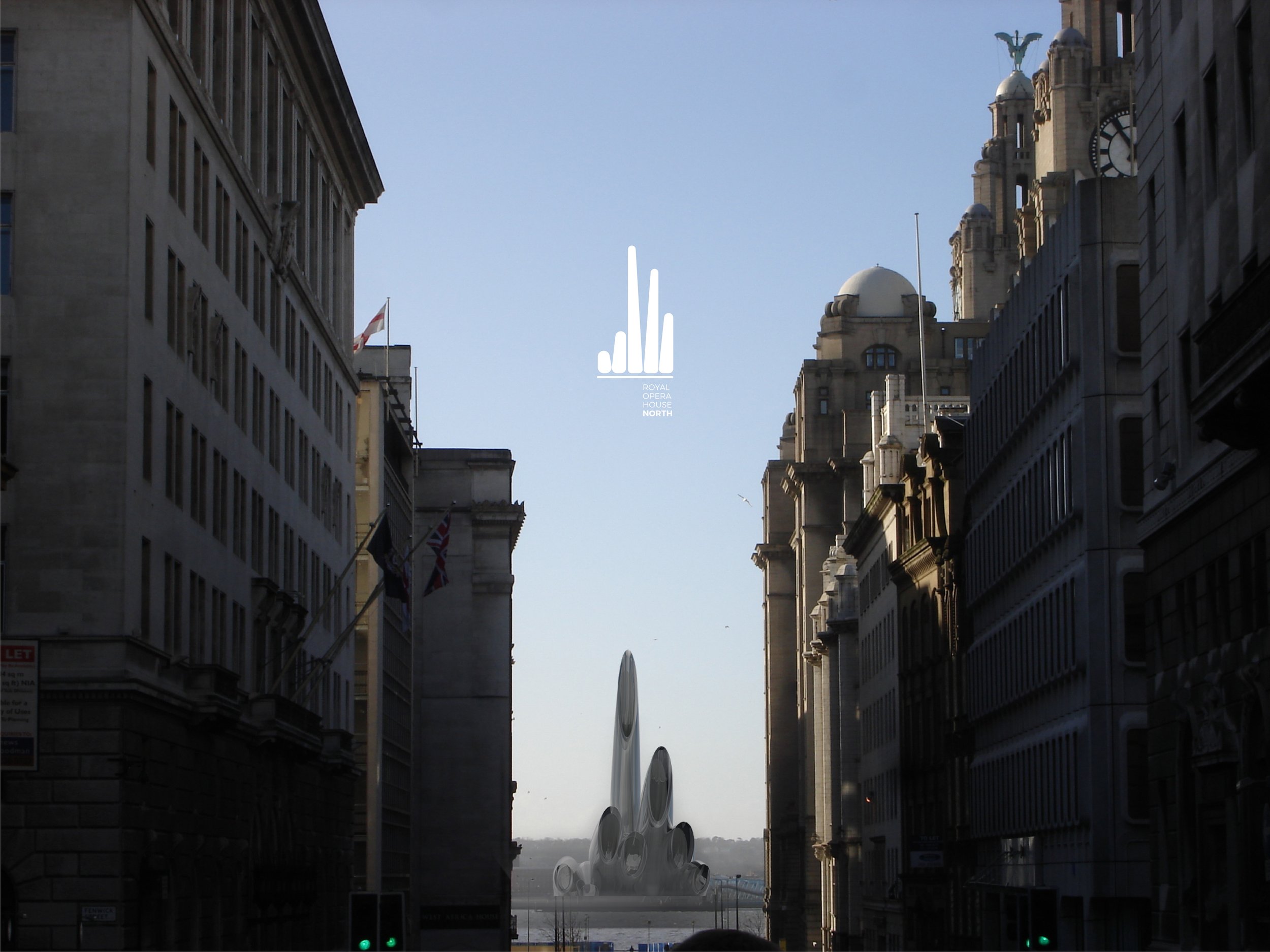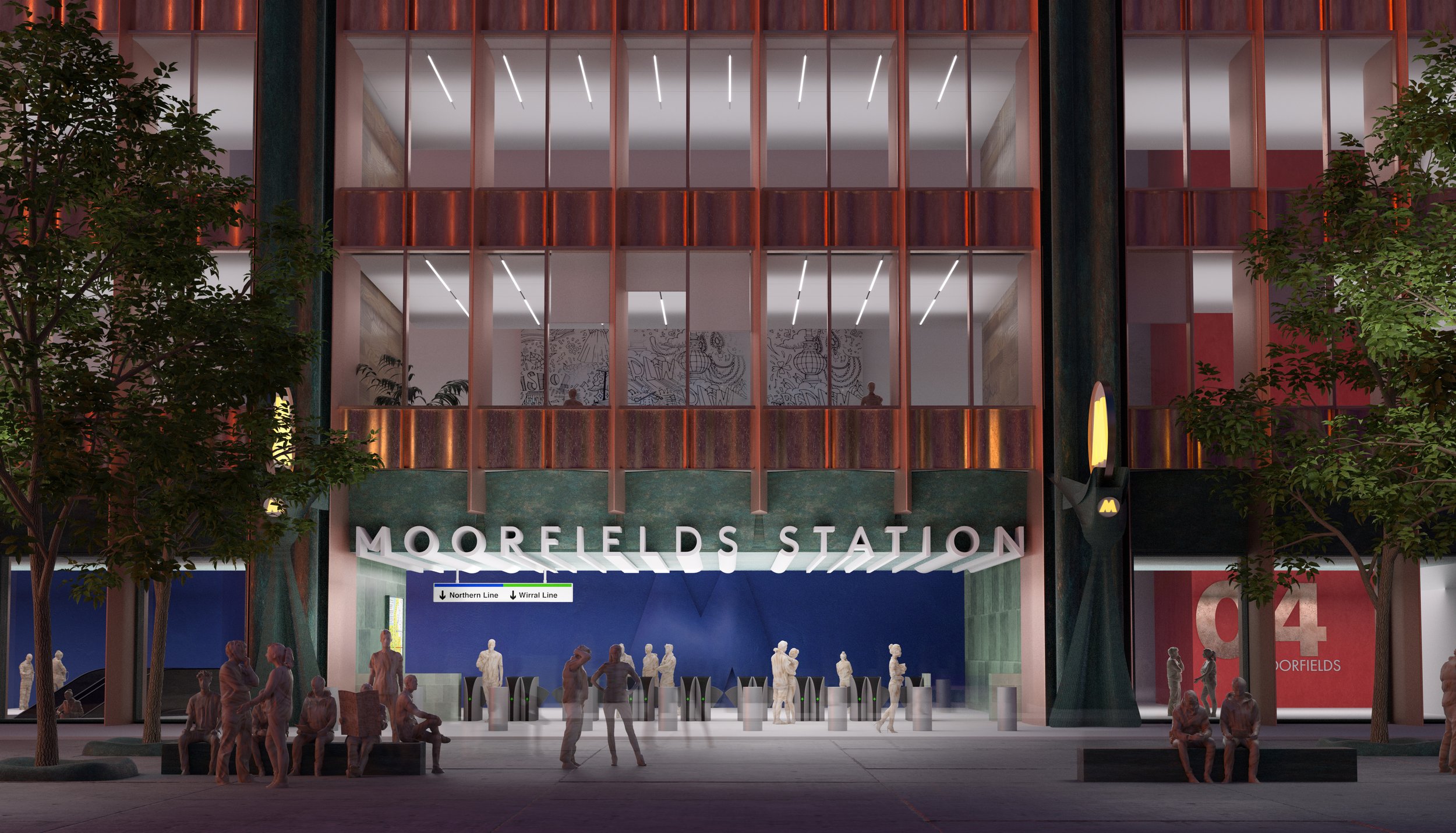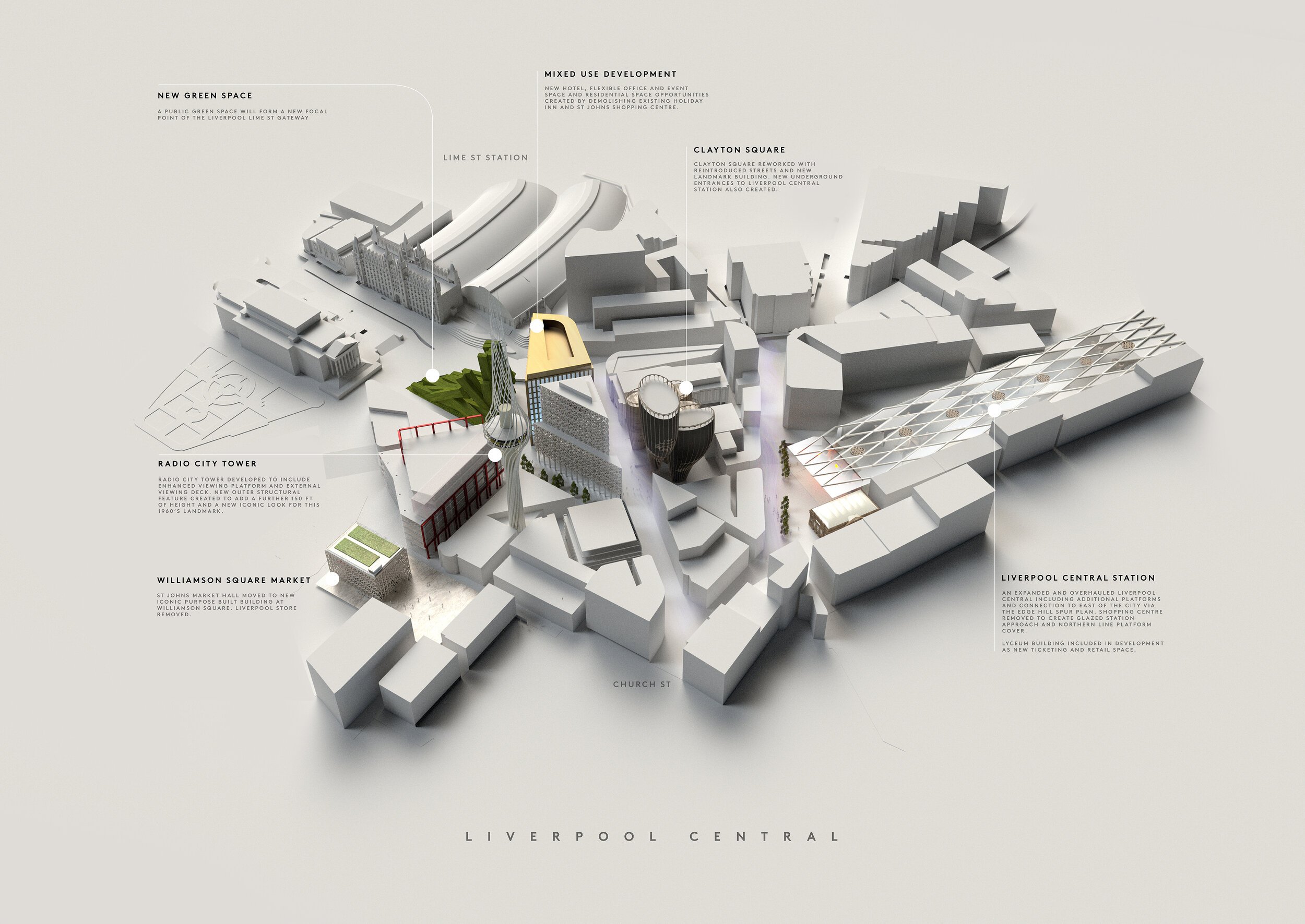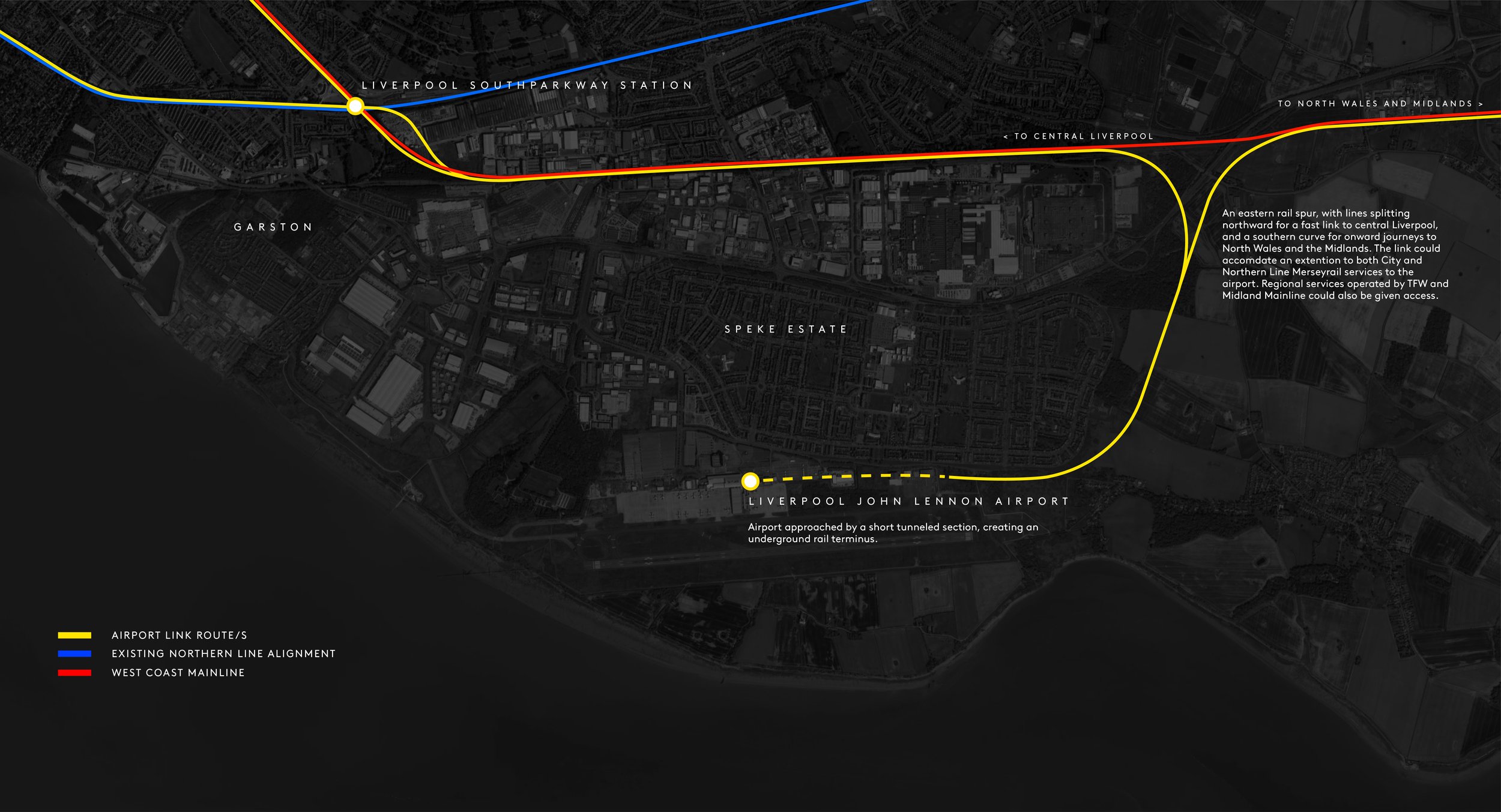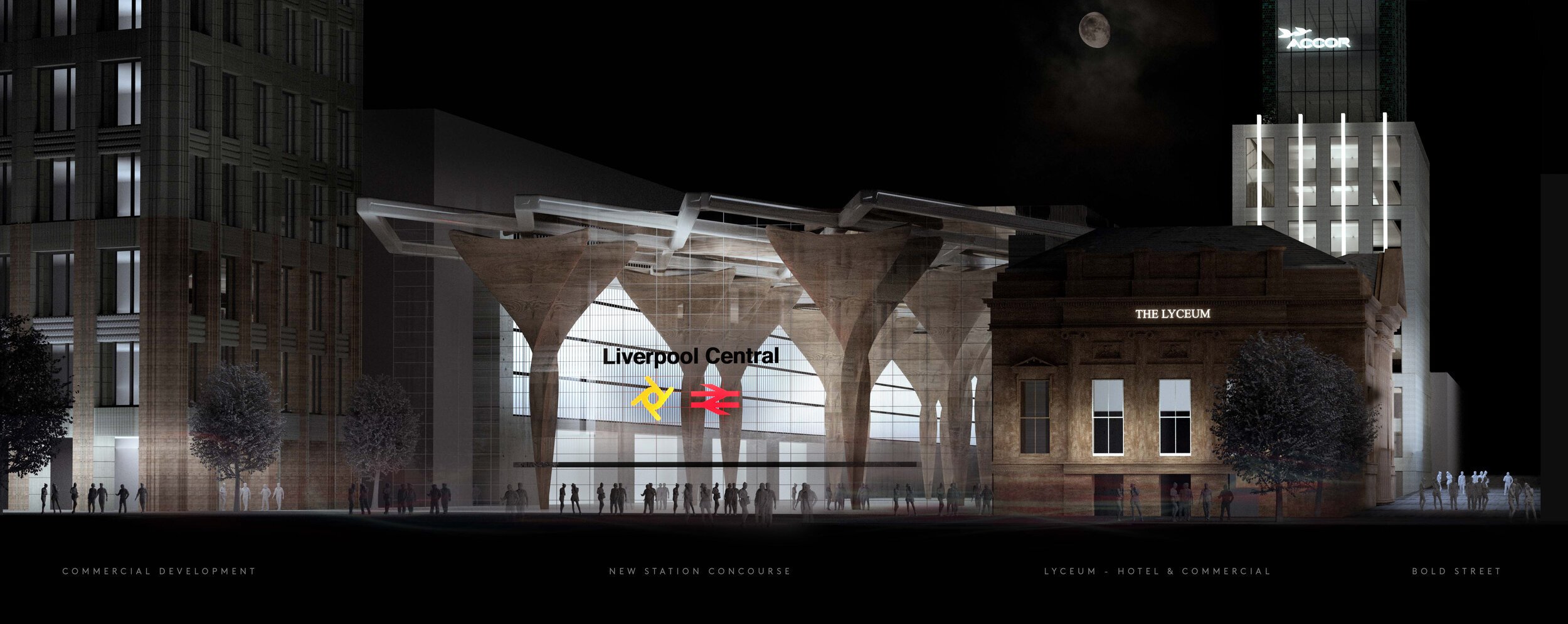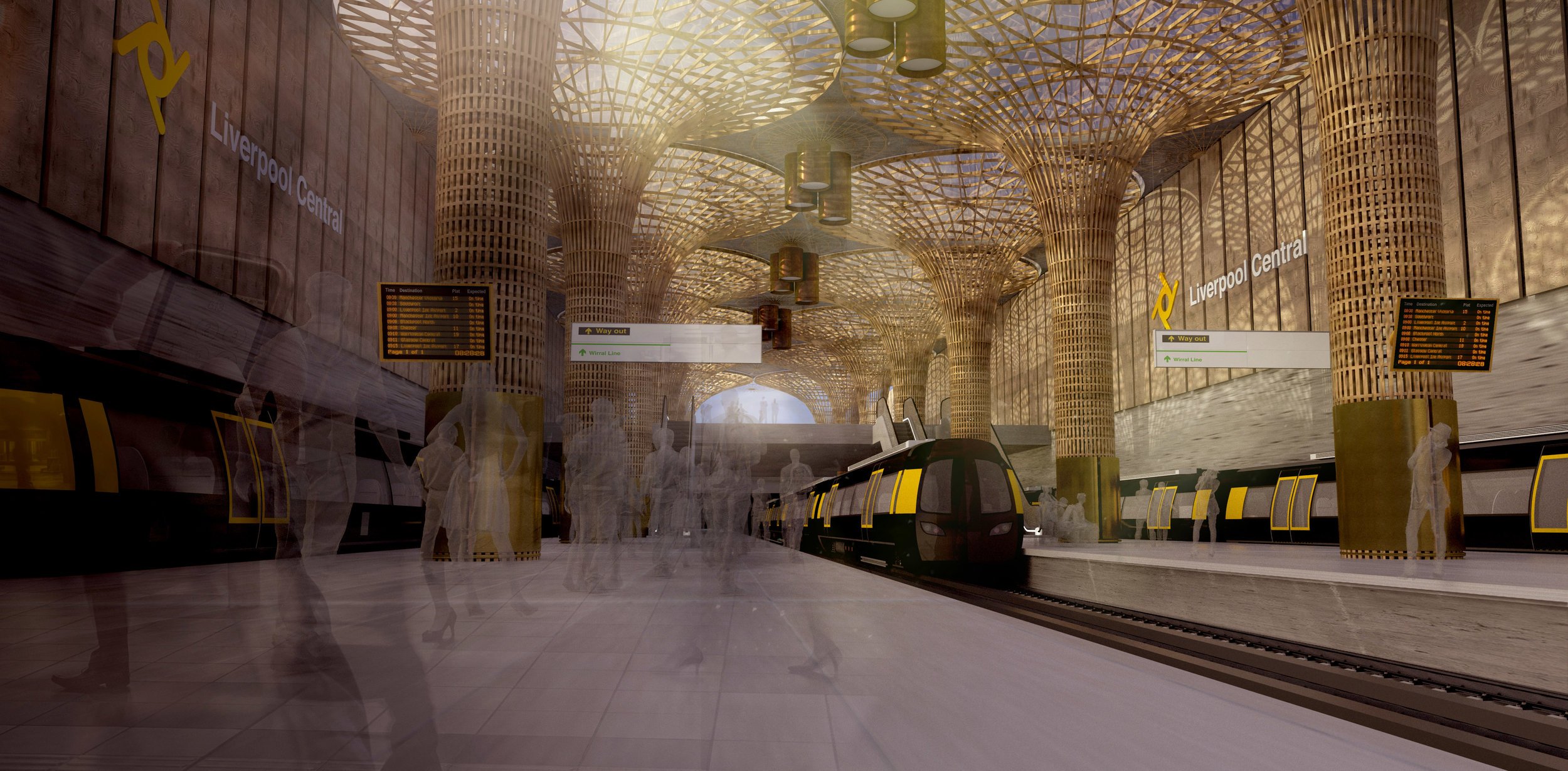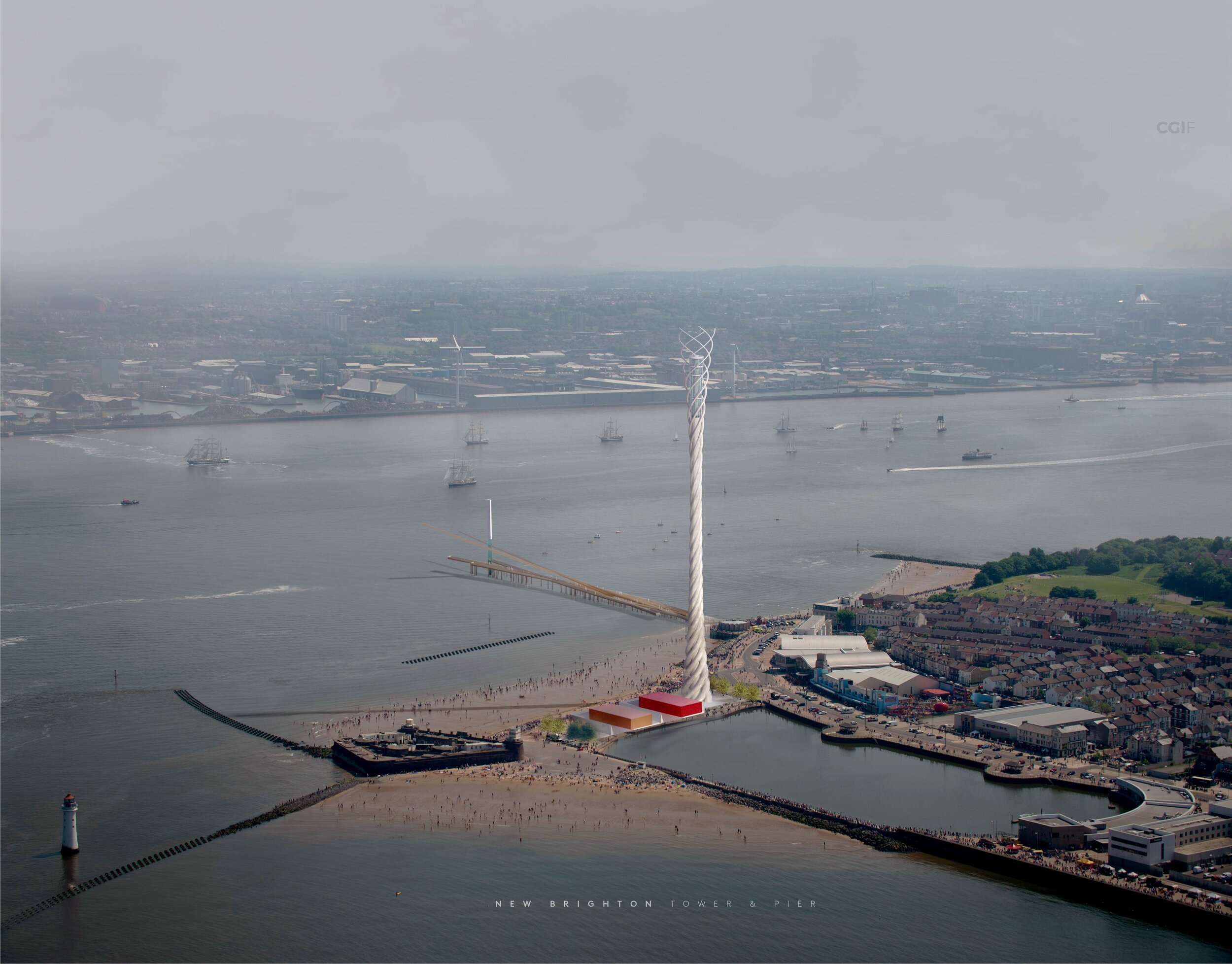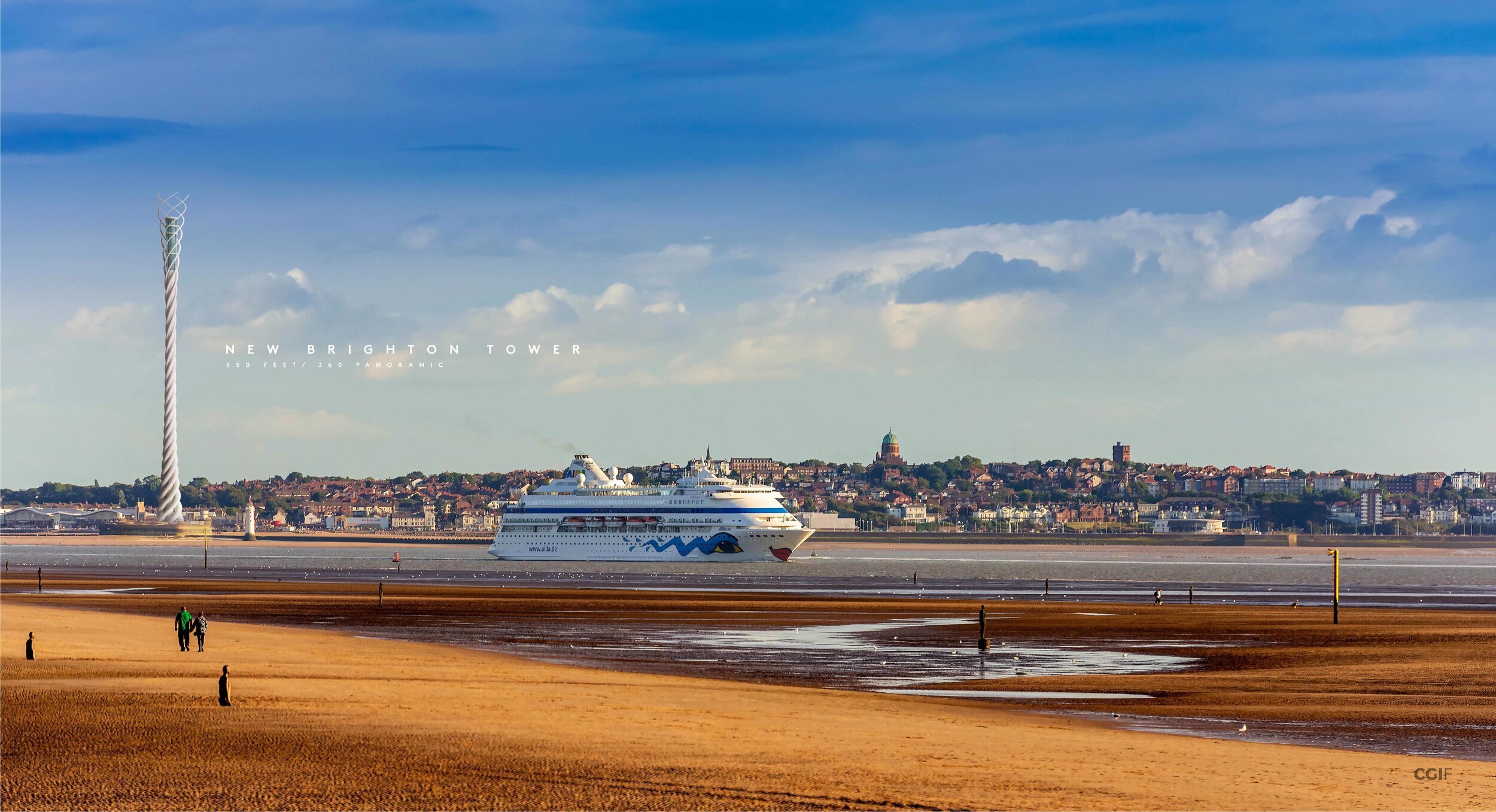Recent features
To the left: what next for the Wirral Waterfront?
As a child I found Wirral, and Birkenhead in particular, to be a deeply mystifying place. I knew that Ireland, where we went on holiday, was across the water, but where exactly was this other place? It wasn’t Liverpool, but was it even England or maybe Wales, or some strange liminal place existing outside my primitive geographical understanding?
Jon Egan
Feb 22, 2024
As a child I found Wirral, and Birkenhead in particular, to be a deeply mystifying place. I knew that Ireland, where we went on holiday, was across the water, but where exactly was this other place? It wasn’t Liverpool, but was it even England or maybe Wales, or some strange liminal place existing outside my primitive geographical understanding?
My earliest journeys across the Mersey did little to dispel Wirral's sense of disquieting otherness. The deep, dark descent into the underworld of the Mersey Tunnel only reinforced its obvious detachment from humdrum reality. This must be the other side of the looking glass.
Years later during my counter-cultural phase, and in the spirit of Parisian Surrealist explorations, we’d take “the metro” to Birkenhead in search of the merveilleux. Birkenhead’s numinous aura was only magnified by the eerie absence of people, the monumental grandeur of Hamilton Square echoing the ominous emptiness and abandonment of Giorgio de Chirico’s metaphysical city scapes.
In later years my associations with Birkenhead became more prosaic and practical through involvement in a succession of aborted regeneration initiatives and "visionary" but unrealised masterplans. Spending days talking to frustrated residents and world-weary stakeholders I was struck by their sad fatalism, as if the town had been subject to some strange and enervating enchantment. As Liverpool’s cityscape was magically transformed before their very eyes, Birkenhead seemed frozen in a state of suspended animation akin to Narnia trapped in its perpetual winter.
But of course there was nothing supernatural about the decline of Birkenhead. Once styled the City of The Future, Birkenhead has a proud and pioneering history. In addition to its global shipbuilding prowess, it’s the town that built the UK’s first public park, its first Municipal College of Art as well as Europe’s first tramway. Birkenhead’s curse is a toxic blend of economic decline and disastrous urban planning, making Birkenhead a place that’s easier to pass through than get to. Whilst cars, people and investment pass Birkenhead by, it’s tempting (and partially true) to point the finger at poor leadership and botched planning. But is there another more fundamental reason for the town’s baleful situation? Is it rooted in Birkenhead and Wirral’s deeper crisis of identity?
Regeneration has to be informed and framed by a sense of place - a clarity of purpose and identity. Without an existential paradigm regeneration is likely to be a series of disconnected and arbitrary interventions, very often aiming to undo the unforeseen consequences of a previously failed intervention. Birkenhead shopping centre is a palimpsest of flawed visions and ham-fisted initiatives. It is still just about possible to discern the archaeological remnants of what was, once upon a time, a high street (Grange Road), dissected, butchered and disfigured by ugly and already half-redundant modernist protuberances . This is town planning re-imagined as self-mutilation.
In 2001 Wirral Council attempted to resolve the peninsula's ambiguous identity with a bold, but alas unsuccessful bid for City Status. This was always a difficult proposition to sell given the uneasy relationship between the borough's urban Mersey edge and its bucolic hinterland. If Wirral isn't a city, then what is it? A municipal construct? A geographical descriptor? A lifestyle aspiration? Is it one place or an amalgam of places with quite different characteristics, histories and identities? It is difficult to suppress the suspicion that the failure to arrest the decline of its distinct urban centres has something to do with their slow immersion and disappearance into an amorphous and confused abstraction. It's little wonder that a Council without a settled sense of identity (its fractious communities historically divided about whether they should have an L or a CH postcode), should struggle to formulate or deliver a coherent regeneration vision. To borrow a Marxist analogy, Wirral's debilitating dialectic needed a resolving synthesis - and happily they found one.
‘Downtown Birkenhead needs to re-orientate itself and define its future in relation to an already burgeoning Liverpool City Centre…’
The Wirral Local Plan (currently awaiting Government approval) ingeniously united the borough's disparate communities and political factions with a strategy to vigorously defend its greenbelt and direct all new housing development onto urban and brownfield sites. Implicit in the plan are two revelatory and foundational propositions.
1) Wirral is not a homogenous place - its Mersey edge is a connected urban strip that is qualitatively different from the pastoral commuter settlements west of the M53. (Income disparity between the borough's most deprived and affluent areas is greater than in any other UK local authority area.
2) The history, identity and future of the urban edge is umbilically connected to the place it stirs out at across the Mersey (but sometimes thinks exists in a different hemisphere) - it’s Liverpool’s Left Bank.
Wirral's Left Bank vision was a new regeneration narrative to reposition and re-imagine the Mersey shore, but is also the core strategy against predatory housebuilders’ determination to challenge the no passaran defence of the greenbelt. However, this defence would only be sustainable if Wirral could make the Left Bank a sufficiently attractive and commercially rewarding location for the scale of building necessary to meet the borough's new homes requirement.
And herein lies the challenge. From New Ferry to New Brighton, the Left Bank littoral has, in recent decades - with one gloriously idiosyncratic exception (more later) - been a virtual regeneration exclusion zone. Turning what is often perceived as Liverpool's down at heel urban annexe into a thriving regeneration powerhouse is a challenge requiring exceptional presentational and practical capabilities.
The presentational brief has been curated by an impressive creative team, combining the branding and visualising expertise of designer, Miles Falkingham with the editorial acumen and eloquence of Birkenhead writer, David Lloyd, The Left Bank mood board, flawlessly realised in the eponymous digital and print magazine, presents a richly fertile incipient oasis, pregnant with possibilities and welcoming to innovators, prospectors and the independently inclined.
Birkenhead Dock Branch Park, conceptual visualisation.
The Left Bank
As a destination for the discerning, Left Bank is a counterpoint to a Right Bank (Liverpool) whose identity and character is being lost under the stultifying uniformity of the standard regeneration model.
But the Left Bank idea is more than a cleverly crafted re-branding exercise. It is also a set of values and sign posts to inform the delivery of what is potentially Wirral's most transformational regeneration windfall. Birkenhead 2040 outlines a radical vision for a re-imagined Birkenhead town centre underpinned by a series of successful Levelling Up and Town Deal funding awards totalling £80 million.
In 2016, following on from my involvement in a consultation on yet another undelivered regeneration project, I was one of a small group who produced an unsolicited document sent to Wirral's then Regeneration Director, entitled Manifesto for Downtown Birkenhead. A call to arms, it's opening paragraph set out the key challenge and imperative:
"Downtown Birkenhead needs to re-orientate itself and define its future in relation to an already burgeoning Liverpool City Centre. Reaching out and strengthening its sense of proximity and connectedness will be vital in attracting the energy, activity and people that are currently absent from a once vibrant centre."
The content was a series of ideas offered or identified during our conversations with stakeholders, or arising from immersive wanderings around a town rich with unique and under-utilised assets. The ideas included creating the region's best urban market, transforming the abandoned Dock Branch railway into Birkenhead's "low-line" and creating a venue for the town's burgeoning new music scene. In 2019 a Festival of Ideas, held as part of Wirral's Borough of Culture programme rehearsed these and other possibilities that would become the anchor ideas for the successful funding bids.
But with both the ideas and funding to deliver transformational change, doubts are emerging as to whether Birkenhead may once again squander a golden opportunity. Following a flurry of key officer departures, including Alan Evans, the Regeneration Chief widely credited with delivering the successful funding bids, concerns are growing that the Council lacks the organisational capacity and technical skills to translate tantalising visions into tangible realities.
‘…it’s something that people would be willing to get off a train for.’
More worrying still, it is now highly probable that pragmatic imperatives will lead to the abandonment of one of 2040's flagship projects. When visionary Dutch architect Jan Knikker was engaged in 2015 by Liverpool developers, ION, to feed into their Move Ahead, Birkenhead masterplan, the possibility of an urban market as unflinchingly radical as his Rotterdam masterpiece became a beguiling statement of ambition. After all, Birkenhead had been a market town, and a re-imagined, relocated modern urban market was the one thing Liverpool didn't have to offer. In the words of Birkenhead Councillor and Wirral Green Party Co-Leader, Pat Cleary, "it’s something that people would be willing to get off a train for."
Citing spiralling costs, the proposal for a new market on the site of the former House of Fraser store at the interface between the St Werburgh's Quarter and the proposed Hind Street residential quarter, would now appear to be dead in the water. A proposal to move the existing market traders into the former Argos store in the Grange Precinct, which is owned by the Council, is being presented as a smart value for money solution that turns a vacant liability into a source of much-needed revenue.
For Cleary, this would be more that the death knell of one of 2040's most transformational projects, it would signify, in his words the replacement of a genuine "regeneration perspective by an asset management mentality." For Cleary, the future of the market is emblematic. If one piece of a coherent jigsaw can be removed, where does that leave projects like Dock Branch Park that could just as easily begin to look expensive and expendable. His is not a lone voice, Birkenhead MP, Mick Whitley, called on the Council to reaffirm its commitment to the new market, warning that the revised option "would mean years of work up in smoke." Following a fraught Council meeting on December 6th, it appears these concerns are unlikely to be heeded. Although officers were instructed to investigate two other options including refurbishing the existing market hall, the House of Fraser site looks likely to remain a boarded up monument to failed ambition.
Others intimately involved in the evolution of the 2040 vision are also worried that the integrity and spirit of the 2040 vision could be lost in delivery. Liam Kelly, whose Make CIC organisation is a key partner in the delivery of the proposed creative hub in Argyle Street, is willing to accept the need for pragmatism, but favoured a less costly iteration of the existing plan on the proposed site, explaining, "it doesn't have to be expensive to look great." For Kelly, the litmus test for 2040 overall will be the Council's willingness to sustain the coalition of stakeholders and co-creators who have worked with the Council in shaping the vision. As the various funding strands are blended and the overall delivery architecture is refined, Kelly believes, it's about "having the doers around the table and how difficult decisions are made" that will safeguard the integrity and deliverability of the 2040 blueprint.
‘Seeing the tragic and seemingly inevitable decline of the once vibrant Victoria Street, local entrepreneur, Dan Davies, embarked on a uniquely eccentric and joyous regeneration adventure.’
With a final decision on the market project now scheduled for February, the omens point increasingly in the direction of Argos. Both Cleary and Kelly stress the much bigger picture perspective that is somehow absent from the beancounting calculations underpinning the Argos proposition. Without a radically different and vibrant Birkenhead town centre, the viability and credibility of plans to build thousands of new homes on brownfield land at Hind Street and Wirral Waters becomes highly questionable. With Leverhulme Estates already launching a legal challenge in support of their plans for 800 greenbelt homes, the pressure on the Local Plan, and the fragile political consensus underpinning the Left Bank idea, may begin to exhibit destabilising cracks and fissures.
Away from Birkenhead there is another equally worrying indicator that when push comes to shove, pragmatism and asset management logic may be taking precedence over a commitment to the Left Bank aesthetic. There is no known precedent or template for the extraordinary regeneration story of Rockpoint and New Brighton. Seeing the tragic and seemingly inevitable decline of the once vibrant Victoria Street, local entrepreneur, Dan Davies, embarked on a uniquely eccentric and joyous regeneration adventure. Buying up empty and semi-derelict shops, he commissioned internationally renowned street artists to execute a series of spectacular murals celebrating the history, culture and identity of the town memorably dubbed, The Last Resort, by photographer Martin Parr.
This was not just about a lick of paint or a superficial facelift to cheer the spirits. Davies's restless energy and obsessive Canute-style audacity has reversed the tide of decline by bringing new businesses, cafes, venues, an art gallery, pub, recording studio and performance space to make Victoria Street possibly one of the most visually and creatively eclectic high streets in this part of England.
With an offer that caters for every demographic - from disadvantaged young people to socially isolated older residents - the breadth of Rockpoint's improvised and quirky inclusivity was perhaps most perfectly expressed in Hope - The Anti-Supermarket. Occupying the thrice-failed food store, Rockpoint transformed the unit into a multi-use space for artisan and independent retailers, social events, comedy, music and local am-dram performances. At a time when communities everywhere are witnessing a diminution of social capital and public space, Davies was delivering, under one roof, the kind of outcomes that 2040's proposed "creative" and "wellbeing hubs" can only promise. In a baffling decision, Wirral Council chose not to extend Rockpoint's tenure of the building, opting instead for the revenue rewards of a hardware store. Hadn't they read the magazine?
The Left Bank idea is an astute piece of positioning, and with an intelligently targeted and resourced campaign, it’s a necessary component in differentiating Wirral's offer, and guiding its regeneration direction. But the Market and Anti-Supermarket case studies also highlight the fragility of mood board-based regeneration, especially when those ineffable and immeasurable subtleties don't convert easily into the hard currency of public sector fiduciary imperatives.
But perhaps there is another flaw in a strategy that fails to distinguish between necessary and sufficient causation. Paris's Left Bank is not simply the bohemian haunts of the Latin Quarter and St Germain-des-Pres and nor is London's South Bank just Borough Market and its trendier residential enclaves. To return to Pat Cleary's challenge, what will make enough people get off the train, or even decide to put down roots in the new urban neighbourhoods envisaged in Birkenhead and the Left Bank? To be more than the One-Eyed town, doesn't Birkenhead need (and deserve) its equivalent of The Musee D'Orsay or Tate Modern? At the conclusion of the Manifesto for Downtown Birkenhead, we posed a question - shouldn't the town that invented public parks and pioneered mass transit reclaim its capacity for innovation and ambition?
“Important places are home to important institutions.... Far from being frightened of big ambitious ideas, we need to encourage them, test them and ultimately deliver them.”
Does 2040 lack the scale of ambition and impact necessary to deliver the catalytic stimulus that Birkenhead requires? Conceiving and delivering projects of that magnitude (including the discreetly mooted V&A of The North) and integrating and re-balancing the two banks of what a casual visitor might mistakenly believe to be one city, is a task that probably necessitated the invention of a City Region and a Metro Mayor.
In fairness to Wirral, the authority has been especially ravaged by the impact of austerity, hollowing out its core capacities and stretching services to breaking point. This is a difficult time to navigate the uncharted terrain of delivery, and the pressure and temptation to find pragmatic compromises may be difficult to resist.
In difficult and demanding circumstances, Wirral has formulated a complex and highly integrated planning and regeneration prospectus, an edifice where big picture objectives are founded on detailed and precisely crafted plans and projects. When Councillors meet to make a final decision on the future of Birkenhead Market in February, they may need to consider whether this is the moment to play a particularly precarious game of jenga?
Jon Egan is a former electoral strategist for the Labour Party and has worked as a public affairs and policy consultant in Liverpool for over 30 years. He helped design the communication strategy for Liverpool’s Capital of Culture bid and advised the city on its post-2008 marketing strategy. He is an associate researcher with think tank, ResPublica.
*Main image: Eszter Imrene Virt, Alamy
Israel-Hamas: Britain looks for fascists in the wrong place
In the wake of the Israel-Hamas war, Pro-Palestinian marches calling for a ‘Ceasefire Now’ are attracting ever larger crowds in Britain’s cities. But with the reaction comes a counter-reaction. Are fears that the Far-Right will exploit these tensions to sow mayhem truly justified? Or could it be said that those calling for peace are turning a blind eye to the support for fascism within Hamas and the Free Palestine movement?
Paul Bryan
It was like all their Christmases had come at once. This was the evidence they needed to quash their opponents and get rid of that evil witch, Suella Braverman, the now ex-Home Secretary.
Famed Far-Right pantomime villain, Tommy Robinson had put in a brief London appearance on Armistice Day as part of the counter protest against the Pro-Palestine march, though he quickly fled the scene in a taxi once the police closed in. There was some pushing and shoving and objects thrown as a crowd of white men headed to ‘protect’ the Cenotaph. “Every. Single. One. Of. Them. Was. Looking. For. Blood. Every one,” intoned professional scouser, sports reporter and mind reader Tony Evans, formerly of the Times. After all, he should know. “I live in Pimlico,” he tweeted. Enough said.
The media went to town of course, with Channel 4 News embarrassing themselves with the claim that ‘the only scuffles on the day involved far-right protesters who clashed with police.’ This spurious claim was later deleted.
Meanwhile, that bellwether of over-the-top reaction, polemicist Owen Jones, did his level best to impose a simplistic division of oppressed and oppressor on the marches. “There were two protests,” he tweeted. “One were a bunch of far right thugs intent on violence. The other was a massive Palestinian protest with “no issues”. One was whipped up by politicians and media outlets. The other was demonised by them.” At least Owen, waited for events to unfold (somewhat). The Liverpool Echo’s political editor and sometime Newsnight guest, Liam Thorp, couldn’t wait to get stuck in, tweeting at 11am that “The responsibility for any violence today lies solely with the Home Secretary and the Prime Minister who is too weak to deal with her dangerous chaos.” Why does he always sound like a pound-shop Churchill?
The feeling that the script was already written before the birds had tweeted was overwhelming. So let’s get somethings straight. Members of the Far Right were present in London though their numbers are hard to pin down – I’ve seen everything from 200 to 2000 quoted in the media – a x10 level of confusion that points to the subjective nature of the assessment. Quite what qualifies which members of the crowd were Far Right and which weren’t was not always obvious – though white skin, opposition to the Pro-Palestinian marches and shouting obscenities seemed qualification enough for many pundits. I suspect membership cards of the English Defence League and their like were largely absent but who knows? After all, the Far-Right label is used so promiscuously these days, it’s becoming hard to distinguish between your Mosely’s and your Monetarists. Alan Gibbons, leader of the Liverpool Community Independents seemed to sum up the mood of presumption - “Look, if it quacks like a fascist, chants like a fascist and attacks police like a fascist it's a fascist.” Obviously not spent much time around Red Action then. Anyway, Alan thought he’d found the smoking gun – a picture of a thug with a swastika tattooed on his torso. Labour MP Dianne Abbot was chuffed about it too. Sadly, a quick reverse image search revealed the picture was from 2016 and not in fact from this year’s Armistice Day marches, but let’s not allow facts to get in the way of good story.
Talking of facts, here’s a few – 126 people have so far been arrested in a demonstration involving over 300,000 people. More will most probably follow but the number is thankfully relatively small. Many of those arrests, as one officer explained on the radio, were pre-emptive of serious trouble, the police choosing to use arrests as a method of keeping opposing camps apart. A knife, a knuckleduster and a baton were found as well as some class-A drugs. Nine police officers were injured amidst chants of “You’re not English anymore.”
We’re told the majority of arrests were from the right-wing and according to the Metropolitan Police Assistant Commissioner, Matt Twist this group was largely made up of “football hooligans from across the UK.” The police are now trying to hunt down protesters from the pro-Palestinian side who are accused of that most amorphous of crime/non-crime categories - hate crime, as well as possible support for proscribed organisations like Hamas. Officers intercepted a group of 150 who were wearing face coverings and firing fireworks. Arrests were made after some of the fireworks struck officers in the face.
So there you have it. It got ugly in places, and where it did the police successfully kept a lid on things. But and here’s the rub, I’m struggling to reconcile the relatively small scale of the trouble with the histrionic shout-outs for a disaster averted. The question we should ask ourselves is why were the ‘Ceasefire Now’ crew so excited about the appearance of a scintilla of right-wingers?
“The idea that white, Far-Right nationalists were just waiting for their Asian Home Secretary to let them off the leash is of course absurd.”
I think there are two answers to this question. One is about Suella Braverman and the other is about diverting the public gaze from the horrors of Palestinian violence.
On the first point, LBC presenter James O’Brien, who likes a good quote, couldn’t help giving the game away. “The Home secretary wanted a riot,” he thundered. Does he do anything but thunder? He continued… “Editors of national newspapers, columnists and commentators… ‘pray that there is not a riot at the Cenataph’ they wrote, while licking their lips at the prospect.” Oh, the hypocrisy! It should be clear to everyone that Suella Braverman is everything progressives hate. They were determined to pin this one on her because they wanted her head and they weren’t going to be satisfied until they got it. Right wing violence on Armistice Day was the metaphorical bullet and they were determined to pull the trigger.
I just wish the James O’Brien’s and the Liam Thorp’s of this world would be honest about that – they were licking their lips too. The absurdity of the proposition that it was all Suella’s fault was for me, best summarised by this tweet…
‘Seen the latest from Suella lads? Worth the subscription to get over the Times paywall. Also excellent pieces from Caitlin Moran and Giles Coren, and Eleanor Hayward is simply the best health correspondent in Fleet Street,’ wrote Gareth Roberts.
The idea that white, Far-Right nationalists were just waiting for their Asian Home Secretary to let them off the leash is of course absurd. But it reveals how the public is increasingly viewed by the political class as mindless puppets who will do whatever they’re told. If it wasn’t for Suella, the logic goes, the yobs would have stayed at home, ironing their flags of St George. They were ‘inflamed’ by her words, unleashing the beast within. As if.
The other reason for the lip-licking is all too transparent. It’s the finger pointing of the anti-racist. ‘Look’, they say, ‘only racists and white supremacists would not want to join our side in our quest for a Free Palestine. Israel is an apartheid state. Join us, as we march from the river to the sea.’
“For all the focus on the threat of Britain’s rump of a right-wing and their historic focus on immigration and racial purity, do you not see a far more extreme mirror of that vile ideology in the rantings of Hamas and Hezbollah?”
These tactics are destined to fail because there are many who can see through them and don’t want to become apologists for a form of Islamofascism. Yasser Arafat, the one-time Chairman of the Palestine Liberation Organisation (PLO) and leader of the supposedly more tolerant Fatah Party, once said, “We will not bend or fail until the blood of every last Jew from the youngest child to the oldest elder is spilt to redeem our land.” What do you think he meant exactly? For all the focus on the threat of Britain’s rump of a right-wing and their historic focus on immigration and racial purity, do you not see a far more extreme mirror of that vile ideology in the rantings of Hamas and Hezbollah? Except, unlike the EDL, these ‘liberators’ have the weapons and the resources to kidnap, maim and kill, as well as making victims of their own people.
Calling for a Ceasefire Now means leaving Hamas intact, free to pursue future campaigns of horrific barbarism. More October 7ths. No thank you. Not for me.
Israel-Hamas: Collective insanity threatens to overwhelm us
In the aftermath of the Pro-Palestine marches in London and the much smaller counter-protest, a game of political ping-pong has ensued. Videos clips are being swapped online from all sides as a new digital currency in moral certainty. Have you seen the one of fascists surging past the police? Yobs! Right-wing scum. Yes, but have YOU seen the one with the Palestine supporter saying, “Hitler knew how to deal with these people.” Islamic fascism right there. Yes, but what about those WHITE supremacists causing mayhem at the train station? What, you mean the one where a protester shouts “death to all Jews.” And so it goes on…
There’s a danger that we’re all about to lose our heads and if we let it, it could get ugly.
Now, I don’t want to give the impression that this is about to be some country vicar, Thought For The Day style piece, urging a gentle middle road, while papering over the cracks in our civilisation with kind words and a cup of tea. There is clearly a huge amount at stake. But I would at least ask everyone to take a deep breath and not assume the very worst motivations from those who find themselves on the opposite side of the fence. There lies the path to de-humanisation and all that goes with it. Rather than summoning partial evidence to prove a point that we know deep down does not represent the full picture, maybe we should look for the courage to acknowledge the flaws in both camps.
Is this image dehumanising? Owen Jones thought so but others disagreed. If we are forever re-defining words to mean whatever we want them to mean, we will lose our ability to think straight. Perhaps that’s the point. Image: Twitter; cartoon originally from Ramirez, Las Vegas Review Journal for the Washington Post.
I for one am critical of the Pro-Palestinian ‘peace’ marches. I just don’t think they represent what their supporters claim, hopelessly entwinned as they are with Islamicist influences favouring a free Palestine ‘from the river to the sea’. A recent article in the Telegraph showed six of the organisations behind Saturday’s London march had connections to Hamas including Muhammad Kathem Sawalha, a former Hamas chief who co-founded the Muslim Association of Britain. This is not a good look. To me, too many people are diving naively in with their eyes closed to the movement’s nasty antisemitic underbelly and risk turning themselves into willing tools of groups who do not share their values and who use apologists consciously and calculatingly as cover. But even I have to admit that many of the protesters clearly mean well – responding to the horrific pictures coming out of Gaza with a natural, empathic desire to put a stop to the suffering. Clearly, they hope that silencing the guns can be a first step in finding a new and lasting peace process in which all can reconcile and heal deep wounds. This is an admirable instinct and should be recognised (when it’s not premised on virtue signalling), but I’d put it in the category of viewing the world through the lens of how we want it to be, rather than how it is really is.
Palestinian leadership have rejected every peace offer that’s ever been put on the table – in 1947, in 2000, and 2008. Negotiations have swiftly been followed by rockets and bombs. Meanwhile, the Jewish settler movement, aided with a nod and a wink by the administrations of Israeli Prime Minister Benjamin Netanyahu, appears to believe it is their God-given right to continue encroaching on the West Bank. As one settler infamously explained a few years back, while attempting to take possession of a property that wasn’t his, “If I don’t steal it, someone else is gonna steal it.” This is religiously inspired entitlement as cover for our basest instincts.
A prized peace cannot hold in the iron grip of absolutism. For all the blood and rubble, you cannot negotiate with someone whose only vision of the future is wanting you dead and gone. Especially ones with a scripture-endorsed death wish where, as author and podcaster, Sam Harris puts it, sadism is “celebrated as a religious sacrament.” Those who have watched the raw footage of the October 7th massacre have described how the killers were elated at their deeds. Douglas Murray for the Jewish Chronicle recounts chillingly, how one Hamas terrorist called his parents back in Gaza to boast that he had killed ten Jews “with my own hands.” Ecstatic with joy he received the praise he desired - “Their boy had turned out good.”
“A prized peace cannot hold in the iron grip of absolutism. For all the blood and rubble, you cannot negotiate with someone whose only vision of the future is wanting you dead and gone.”
There is a secularist presumption at play that all people basically want the same thing – peace, security, a roof over their head, good schools, full bellies and a decent job. But what if it’s not true? Here in the West, this ‘humanistic’ presumption is mapped onto the Israel-Hamas conflict even if it doesn’t apply to all the protagonists. People calling for a ceasefire now, such as the RMT union leader, Mick Lynch end up thinking with a bit of good grace and a fair wind the Israelis and Palestinians can be convinced to sit around a table and hammer it out. As if this was a negotiation over terms and conditions. From this perspective, when confronted with the reality of suicide bombers and hideous acts of barbarity, the question is asked - how could this be? What could turn people to such extreme behaviour? And the prescription as Sam Harris characterises it, is always the same – “they must have been pushed into it…their entire society oppressed and humiliated to the point of madness by some malign power. So many people, he says, “imagine that the ghoulish history of Palestinian terrorism simply indicates how profound the injustice has been on the Israeli side.” And some might argue that the extremities of the Jewish holocaust layered on century after century of cruel pogroms have had a similar effect on the Jewish psyche. But perhaps these explanations are all too neatly packaged for the contemporary western imagination. In an interview with Piers Morgan, psychologist and author, Jordan Peterson makes the point that the sins of the father are visited on their children. That we may not wish life was like this, but it is – generations of bloody violence echoing down in retribution. It’s hard to break the cycle, not impossible, but hard, especially when you add a strong dose of religious certainty that can make even good people do bad things.
Maybe, just maybe, the cries to martyrdom reveal a deeper, unsettling truth about the role belief plays in violence. Maybe the people of the region need to look deep within to question the core ideas that shape their coda.
Paul Bryan is the Editor and Co-Founder of Liverpolitan. He is also a freelance content writer, script editor and creative coach.
@thePabryan
*Main image: Mark Kerrison, Alamy
Genghis Khan, Kirkby Market and me
Since the 1990s, the town of Kirkby, a suburb of Liverpool has undergone a continuous cycle of demolition and reconstruction. The changes, though well intentioned, have largely failed to address Kirkby's social problems or arrest the high rates of deprivation. Regeneration expert, John P. Houghton, who was raised in the town, recounts Kirkby's regeneration history and argues that the social cost of change has often not been worth the price.
John P. Houghton
From rural village to manufacturing powerhouse to struggling suburban overspill, Kirkby has had a chequered history. Just 6 miles from Liverpool, in the borough of Knowsley, the town was once the inspiration for the TV show Z-Cars, a police procedural majoring on social realism in gritty estates.
In recent years, Kirkby has seen some degree of investment, from new housing and schools to a brand new market and health centre, and it recently acquired a new train station. Artwork is layered around the town’s centre including winged chairs and a wise, old elephant riding a Viking longboat. But the picture remains mixed. Hope for better rubs shoulders with as yet unfulfilled promises, marked by peeling hoardings and discarded shopping trolleys. The one thing you can say for sure is that Kirkby is increasingly unrecognisable, with planners consistently favouring demolition and rebuild over subtler forms of intervention.
One man who would know is John P. Houghton, a regeneration expert who grew up in the town. In this article, he argues that the hard lessons from Kirkby’s past need to be applied to its future - that people should come before property. John believes keeping communities together and repairing the social fabric is better than constantly demolishing and rebuilding estates…
In the year 1218, the Shah of Khwarezmia made one of the worst decisions in all of human history; he picked a fight with Genghis Khan.
The Mongol leader had made a tentative peace-with-trade offer to the Shah, the ruler of a vast Central Asian empire, by sending a caravan of ambassadors to negotiate an agreement that would allow both medieval superpowers to co-exist. In response, the Shah killed the emissaries. Khan was so enraged by this act of provocation, he immediately declared war on the Khwarezmian empire and its unwise leader. Victory on the battlefield was swift, although the Shah himself escaped and fled.
Without his enemy’s body for proof of his conquest, Khan ordered his men to the Shah’s hometown, where they demolished and dismantled every single building until no structure was left standing. Even this was not enough to satisfy Khan’s desire for retribution.
His troops went on to re-direct a local river through the place where the town once stood, washing away the last stumps of human settlement and wiping the Shah’s birthplace from the map.
While the course of Merseyside’s River Alt is probably safe, I sometimes wonder if I’ve done anything to provoke similar wrath from the planning department that oversees my hometown of Kirkby in Knowsley. Let’s look at the historical record.
Here’s a list of the now-demolished buildings that played an important part in my early life: the estate where I was born and lived to the age of four; my infant school; my junior school; my secondary school; the church where I took my first Holy Communion; the swimming baths where I dived for rubberised bricks in my pyjamas; the sports centre with its infamous ski slope; the library; he college where I did my first work experience on the local newspaper; and the ‘Mercer Heights’ tower block where my uncle lived which offered views all the way to the Mersey.
One of the few buildings from my childhood still left standing is the house where I lived until I left for university at the age of 18. But don’t get your hopes up; this is not a pinprick of light amongst the darkness. The place I called home will make an unhappy appearance later in this story.
Tales of bloody vengeance aside, there is perhaps another explanation why my hometown has been involved in this seemingly endless cycle of estate clearance and re-construction. It’s an explanation that exposes the folly of putting property before people.
To understand that story, we need to take a look at the history of Kirkby.
Kirkby has seen investment in recent years but vast tracks of land are still hidden behind ageing hoardings. A local resident complained about ‘broken promises’ over a new cinema. Image: Liverpolitan
Over-spill
In 1951, Kirkby was a village of 3,000 people on the eastern fringe of Liverpool. Nearby, the government had built the Royal Ordnance factory to supply munitions to British troops during World War II. This had seen an influx of 20,000 temporary workers during those war years but the village itself had remained largely unchanged, with its rural economy sustained by the fertile soil of the surrounding farmland. But all of that was about to change utterly and at phenomenal speed. In the years that followed, Kirkby would grow at a pace barely seen in England since the Industrial Revolution.
The transformation was driven by the UK’s post-1945 approach to urban and economic development. As in other places such as Coventry and Plymouth, vast tracts of Liverpool had been destroyed or heavily damaged by the German Luftwaffe. For urban planners facing the challenge of rehousing both industry and tens of thousands of workers this opened up untold opportunities to realise their utopian civic dreams.
Post-war government policy subsidised clean-sweep demolition and the dispersal of populations out of cramped, bomb-ravaged city centres and into gleaming, structured ‘new towns’. Kirkby, with its ample land, brief flirtation with mass production and proximity to the city, was viewed as a prime spot to begin construction.
“The people who created Kirkby could build houses, but chronically undervalued the importance of ‘third places’, where people of all ages can rest, relax and play.”
Southdene was the first estate to be built in the new town in 1952, and was followed by many, many more. Although, as we’ll see, it took longer to deliver social and cultural amenities than it did new houses; the first shops were not opened until 1955, while the first pub only began serving in 1959. Kirkby Market started trading a year later.
By 1961, the population had rocketed from 3,000 a decade earlier to 52,000; a seventeen-fold increase in ten years. My grandparents, as children, were part of this vast wave of managed migration. Young families were attracted not only by the prospect of a home with a garden, but good chances of employment too. Liverpool City Council had bought the old Royal Ordnance site and working with factory owners and manufacturers had redeveloped it as Kirkby Industrial Estate. The future looked rosy.
However, the immediate problem on “Merseyside’s largest over-spill estate” was the absence of social infrastructure or, in simpler terms, the lack of anything to do outside of the house. Especially for the huge numbers of young people who lived there.
Tower blocks like Mercer Heights have been disappearing for years. But the new housing has merit if not the same great views. It will, however, take time to build back a lost sense of community. Image: Liverpolitan
“For building’s sake”
By the early 1960s, virtually half (48%) of the Kirkby population was aged under 15. The average for England was just over a quarter (27%). If you find buses or trains quite noisy when half the passengers are school kids, imagine an entire town like that. All of the time, with practically nothing for them to do.
Demographic imbalances are understandable in the post-war context. After all, around 880,000 British soldiers, or 6% of the nation’s adult male population, had shed blood on the battlefield in WW1. Another 384,000 died in WW2.
Less comprehensible is the failure to anticipate the consequences of concentrating thousands of families in a new town without support structures or social amenities. In his blog piece, New Jerusalem Goes Wrong, John Boughton cites a 1965 article in The Times: “no-one has yet built a cinema or dance hall and, possibly for this kind of reason, the 13 and 14-year old are the town’s most frequent law-breakers.”
On the same theme, one resident complained of the local council that “all they’ve built for is building’s sake but not to take the children into consideration. Have a look around here, where on earth can children play?” The people who created Kirkby new town could build houses, but chronically undervalued the importance of ‘third places’; spaces outside the home and workplace where people of all ages can rest, relax and play.
Even reforms to how the town was governed failed to deliver a change in thinking. The Kirkby Urban District, which had been established in 1958, was abolished in 1974 and merged with nearby authorities to form the Metropolitan Borough of Knowsley.
The new structure delivered the same old emphasis on volume housebuilding at the expense of essential infrastructure. Perhaps the new authority’s ambitions were thwarted by an infamous episode in Kirkby’s history.
Sloping off
The new Borough council may have been put off the idea of building anything other than houses by the experience of trying to instal a ski slope in the grounds of Kirkby sports centre. This is one of the oddest, and still most mysterious examples of urban misadventure in England’s post-war history.
The idea, first formulated in a smoky pub in 1973, was to offer residents the chance to get some exercise by emulating the professionals on the BBC’s popular winter sports show, Ski Sunday. In reality, neither the planners nor the contractors knew how to build a ski slope in a built-up urban environment. This most basic fact may have been exposed if the building contract had been put out for open and competitive tender. However, due process was almost completely ignored as deals were done over lunchtime drinks.
“An internal inquiry at the council, found that the [ski] slope had been built “without planning permission, over a water main, on land the council didn’t own. Due process was almost completely ignored as deals were done over lunchtime drinks.”
Costs spiralled as, during safety trials, both people and parts of the slope kept falling off. This required the addition of boundary fencing and frenzied attempts to ‘de-bump’ the surface; all to no avail.
The bumps may have been caused by the “haphazard collection of builders’ rubble” used to make the mound, according to a jaw-dropping BBC Nationwide investigation. This prompted an internal inquiry at the council, which found that the slope had been built “without planning permission, over a water main, on land the council didn’t own.”
The worst allegation was that the slope had been built the wrong way around, threatening to send terrified skiers into the path of oncoming traffic on the M57 motorway. Amid howls of derision, and before it was completed, the council stopped further construction in 1975 and, you guessed it, knocked it down.
Unlike the Kirkby skiers, the local economy was initially heading in the right direction. The teenagers may have been bored, but the adults were kept busy. With a new workforce and modern factory plants, the early years of the town were an economic success story. By 1967, Kirkby Industrial Estate supported a mammoth 25,000 jobs. After the youthful exuberance of the 1960s, however, came the strife of the 1970s and 1980s.
Art designed to lift the spirits has been widely used around Kirkby. Some pieces are more successful than others. It’s unlikely the shopping trolleys were deemed worthy of a public commission, but their presence still speaks powerfully and artistically. Image: Liverpolitan
Demolition and depopulation
In 1971, the Ford factory at Halewood, south Liverpool, where my dad worked on the assembly line, laid off 1,000 workers in the middle of a strike over pay and conditions. Many more redundancies followed as factories were shuttered and workforces shrank in the face of competition and technological advancement. This included factories in Kirkby such as Thorn Electrical, which closed with the loss of 600 jobs.
By 1981 almost a quarter (22.6%) of Liverpool’s working-age population was unemployed. For the rest of that decade, and into the 1990s, Kirkby was trapped in a self-reinforcing cycle of job loss and population decline. The residents of the new town had been promised a New Jerusalem. In reality, as one Liverpool Echo report succinctly summarised, they were “let down by central government planners, corrupt councillors and the private sector alike”.
The loss of jobs and households was exacerbated by the council’s decision to use demolition as a primary response to neighbourhood decline. The BBC paid another visit to Kirkby in 1982, to report on the demolition of a large estate in Tower Hill.
As the newsreader Jan Leeming explained, the development had been built “only twelve years ago” but, according to the council, had proven unpopular and stood completely empty for the last two of those years.
As the estate is dynamited, the camera's unforgiving lens focuses on the destruction and the reporter reveals an equally devastating fact. The council will continue paying for the development for another forty years.
There was, no doubt, a case for demolishing the most unpopular and poorly-built developments, but in Kirkby, as elsewhere, widespread demolition became a self-perpetuating cycle; damaging the environment, breaking up communities, and effectively admitting failure in the task of making a decent place for people to live.
Demolishing entire estates also entailed the destruction of social and community facilities like shops, youth clubs, GP surgeries, and play areas that were already in short supply. In contrast, as a 2010 LSE research paper by Anne Power explains, refurbishment “offers clear advantages in time, cost, community impact, prevention of building sprawl, reuse of existing infrastructure and protection of existing communities.”
“In Kirkby, widespread demolition became a self-perpetuating cycle; damaging the environment, breaking up communities, and effectively admitting failure in the task of making a decent place for people to live.”
By the 1990s, central government policy became more sophisticated. The post-war policy of clearance and construction was falling out of favour. There was growing interest in the idea of comprehensive or ‘holistic’ renewal that paid as much attention to social infrastructure and public services as to bricks and mortar.
Down the road from Kirkby, the revitalisation of the Eldonian Village in North Liverpool won the prestigious World Habitat Award for its model of comprehensive, community-based regeneration. A core element of the approach was to keep the existing community together by repairing and improving the physical and social fabric.
A little further away, Urban Splash made its name in Greater Manchester by purchasing properties and as one president of RIBA wrote, “instead of demolishing them as others would have, they turned them into cool lofts and workplaces”.
Meanwhile, Knowsley council continued demolishing housing stock in Kirkby, including maisonettes and high-rise tower blocks, like Mercer Heights. While clearance and construction in other parts of the country were falling out of favour as a model of regeneration, closer to home it was still being used to spur short-term job creation.
“Driven by debt and speculation”
By 2001, Kirkby was home to just over 40,000 people, its total population continuing to slide down from its 60,000 peak in the economic heyday of 1971. I was part of that outflow, leaving for university in 1996 and returning only ever temporarily to spend time with my family.
In 2011, on one such visit, I drove past my old house, the one mentioned earlier, where I’d spent the majority of my childhood years. I was shocked to find that it was not only empty, but vandalised and partially burned out. I wrote about the situation at the time and it was picked up by Aditya Chakrabortty for The Guardian.
Home sweet home, but not as John remembered it. Time can be cruel. Image: John P. Houghton
The crash of 2008 and the harsh recession that followed had exposed the danger of relying on a fundamentally unstable and over-inflated housing market to drive economic growth. In effect, Knowsley Council, like others, had used housebuilding as a short-term economic stimulant.
When an area declined, clean-sweep clearance and new home construction was used to create jobs and generate economic activity in the immediate supply chain. But these gains were only ever short-term. When you factor in the disruptive social impact of this approach the cycle of knocking down and rebuilding ultimately becomes damaging and self-defeating.
This wasn’t building to make a community, but boosterism to stimulate a brief burst of economic activity in the absence of anything more sustainable or useful. As Chakrabortty put it, “places such as Kirkby remind us that what’s collapsed isn’t [just the economies of] a handful of countries, but an entire model of economic development: one driven by debt and speculation, which ignored the need for productive industry.”
“Kirkby reverses its fortunes”
Kirkby’s prospects for the next few decades are brighter than they have been for a while. After the re-opening of Kirkby Market, the Financial Times in 2022 described private sector investment as “driving a retail revival in a deprived northern town.”
The Liverpool Echo came to a similar conclusion, citing data showing Knowsley “experiencing one of the strongest post-pandemic recoveries throughout the UK when it comes to local spending”. The council is exploring the idea of ‘community wealth building’ as a way to keep more of the money spent locally circulating within the borough’s economy.
The re-opening of the market was part of the long-running redevelopment of the town centre, which in turn is one of several investments in the town. A new train station, Headbolt Lane, opened in October 2023, connecting the Northwood neighbourhood to the line that runs straight into the centre of Liverpool.
If this recovery is to be sustained, the hard lessons learned from Kirkby’s past need to be applied to its future.
The profound social and economic costs of constant clearance and construction massively outweigh the short-term gains of using housebuilding to boost the local economy. Instead of widespread demolition and scattergun population dispersal, we should learn from projects that repair the social and physical fabric.
Neighbourhoods need more than just homes. They need pubs and parks, creches and community centres, libraries and lidos. Places that nurture a sense of community and give people the best environment to have a decent crack at life.
To ignore these lessons would be a folly worthy of the Shah of Khwarezmia.
Kirkby High Street on a sleepy Sunday. Images: Liverpolitan
John P. Houghton is a freelance consultant who works with councils, developers, housing associations, and community groups to make better places. A specialist in urban regeneration and economic development, John has advised the UK government on large-scale institutional investment in major projects. He was born and raised in Kirkby.
John regularly posts articles on his blog, Metlines in which an earlier version of this feature appeared. He can also be found on X (formerly Twitter) @metlines.
What do you think? Let us know.
Add a comment below, join the debate via Twitter or Facebook or drop us a line at team@liverpolitan.co.uk
Not So Red: Labour’s Slow Rise in the Scouse Republic
Liverpool wasn't always the ultimate Labour stronghold. For much of the past century, Conservatives have dominated local and parliamentary elections. Historian of the Left, David Swift, charts Labour's surprisingly slow rise to power in not-so-red Liverpool.
David Swift
You don’t often see Liverpool compared to Iran. And certainly a stroll through the city centre on a Friday or Saturday night brings sights you probably wouldn’t see in downtown Tehran.
In an essay comparing the politics of Iran and Egypt, the sociologist Asef Bayat pointed out that Egypt, despite having strong popular support for Islamist politics and a weak middle class, never established a religious theocracy along Iranian lines. The difference being that in Iran, the government of the Shah had successfully eliminated all secular opposition – liberals, socialists, trade unionists – so the Mullahs were the only people in a position to take over, despite a lack of broader support for their project. So Egypt had an Islamic movement but not an Islamic revolution, and Iran had an Islamic revolution without much of an Islamist movement.
Over the past 100 years something similar has happened in the political transformation of Liverpool. From a bastion of working-class Toryism, Liverpool has become a city with the five safest Labour seats in the country. Other areas with similar demographics have seen Labour’s support slide in recent years, but in Liverpool the party’s dominance has continued to grow.
Yet curiously, beneath the surface, just like in Iran, the dominant political movement has been anything but strong. Liverpool has undergone this Labour revolution with a much weaker, organised Labour movement than other cities. Don’t believe me? Look at the history.
This year marks the centenary of the election of Jack Hayes, the first Labour MP to sit for a Liverpool constituency – who won the 1923 Edge Hill by-election. This breakthrough came roughly two decades after other ‘Labour heartlands’ such as Manchester, East London, Glasgow, Leeds and South Wales had elected their first Labour MPs.
Before and even after Jack Hayes’ triumph, Liverpool was solidly Tory. From 1885 to 1923, with just a few exceptions, the city’s nine constituencies were won by the Conservative candidate in every parliamentary election. Toxteth was represented by people with little claim to working class roots; people with grand-sounding names such as Henry de Worms and Augustus Frederick Warr. It is hard to imagine now but for 14 years the MP for rugged Kirkdale was a Baronet called Sir John de Fonblanque Pennefather.
The most notable exception to Tory dominance at that time was the Liverpool Scotland constituency, centred on Scotland Road, which was dominated by Irish immigrants. Held by the Irish Nationalist T.P. O’Connor from 1885 until his death in 1929, his victory remains the only time a British parliamentary seat has been won by an Irish nationalist party outside the island of Ireland.
Of course, the Liberals had the occasional reason to celebrate too, winning Liverpool Exchange in 1886, 1887, 1906 and 1910 as well as Liverpool Abercromby in their general election landslide of 1906. But even at that election – a wipeout for the Tories and their worst result until 1945 – the Liberal Party only managed to win two of Liverpool’s nine seats, with the Conservatives taking six out of the other seven.
An Irish Republican, Tory Baron and Liverpool’s first Labour MP walk into a bar. But who’s who?
Left to Right: Jack Hayes Labour MP for Edge Hill (1923-31); T.P. O’Connor the Irish Nationalist MP For Liverpool Scotland (1885-1929); and Baron Henry de Worms, Conservative MP for East Toxteth (1885-95). Image credits in respective order (left to right): Bassano Ltd, public domain via Wikimedia Commons; Bain - Library of Congress (1917); Alamy
Some commentators have claimed Liverpool politics are based on rebelliousness or innate defiance and a willingness to speak up and go against the crowd. Which makes what happened in the 1906 general election all the more fascinating. Dominated by the issue of free trade, the Conservatives lost badly at the national level because it was feared their plan to impose tariffs on imported goods would damage trade. And yet even in this election, in a town as totally dependent on trade as Liverpool, even in a port city, Liverpolitans put two fingers up to the national trend and voted for the Tories anyway. Was this an early example of that noted tendency to contrarian defiance or slavish support for the party of power?
Of course, at this time, the six-year-old Labour party was not a serious force around the banks of the Mersey and their leader Ramsay MacDonald – who later become the first Labour Prime Minister, knew it too. In 1910, after a visit to the city he seemed to accept they had no prospects of winning there any time soon, writing with a note of sour grapes that ‘Liverpool is rotten and we had better recognize it’.
Why was Liverpool so slow to support the party of the working class?
One explanation often put forward is the narrowness of the parliamentary franchise which dictated who got to vote. It’s claimed voting restrictions prevented many working people from making their voices heard and it’s certainly true that this affected politics at this time, though perhaps not always in the ways most commonly understood. From 1867, men in ‘borough’ constituencies (usually towns and cities like Liverpool) were able to vote in general elections but only if they were defined as a ‘householder’. This meant a man living independently by himself or with his wife and children who also paid a minimum of £10 a year in rent. In theory, most working-class men could now vote, but in reality it’s estimated 40% of men nationwide were disenfranchised until these rules were relaxed in 1918.
This was because the lack of affordable accommodation meant many men still lived at home with their parents or in houses with multiple families, and so fell foul of the rule. In a port city like Liverpool, where seafaring was the second largest source of employment, this would have been particularly significant because so many men worked away for long periods. The 1921 census found there were twelve times as many men without a fixed address or workplace in Bootle than in St Helens.
Nonetheless, some historians have challenged the idea the franchise disproportionately affected working-class voters, noting that, on average, men from working-class backgrounds found work, left home and started families earlier than their middle-class equivalents. As noted by Neal Blewett in an article for Past and Present, middle-class professionals were more likely to be lodgers, who very often couldn’t vote. It’s too easy to use the disenfranchisement of working-class voters to explain Tory dominance in the city - especially since women, who have tended to favour the Conservatives by wide margins, were unable to vote in general elections until 1918. Perhaps the limitations on the voting franchise hurt rather than helped the Tories. In her influential book, The Iron Ladies (1987), journalist Beatrix Campbell claimed Labour would have won every election between 1945 and 1979 but for women’s right to vote.
The influence of sectarianism overstated
It’s also too easy to blame ‘sectarianism’ for Tory rule in Liverpool. According to this analysis, conflict between Protestants and Catholics divided the working class vote, with Catholics favouring ‘home rule’ for Ireland supporting the Irish Nationalist party (the IPP), while Protestants opposing greater Irish autonomy voted for the Conservatives. The argument goes that the conditions for a Labour breakthrough in Liverpool only occurred after Irish independence in 1922, when the sting went out of the nationalist cause. Catholic votes transferred to Labour, whilst Protestants, with the nationalist issue seemingly resolved, felt less inclined to vote Tory.
But many historians, such as Sam Davies, have downplayed the importance of sectarianism, arguing instead that Tory dominance resulted from the weakness of the Labour party in local politics and splits in the anti-Tory vote.
Famously, Churchill sent gunboats on the Mersey in 1911 to quell a dockers strike, but despite this Liverpool was still voting Conservative. Meanwhile in Glasgow … Red Clydeside was already represented in parliament. Image: HMS Antrim, Ernest Hopkins, Public domain, via Wikimedia Commons
It’s instructive to compare the political situation in Liverpool to that of Glasgow - another town with a violent sectarian divide. While Liverpool outside of Scotland Road was staunchly Tory, in Glasgow, sectarian sentiment saw a surge in support for the Liberal Party. As far back as 1886, with the Liberal Government led by William Gladstone (a Liverpolitan), proposing Home Rule for Ireland under a less centralised United Kingdom, Catholic voters jumped at the opportunity to get behind the Bill. Nationally, the 1886 general election saw the Liberals lose over 150 seats as the issue proved unpopular. Yet in Glasgow, the Liberals won four of the city’s nine seats – with another two going to the ‘Liberal Unionists’ who, opposing the move, were no doubt supported by the city’s Protestants. Liverpool never saw anything like this degree of sectarian influence.
Back to that 1906 election, which by the way was only the second to be contested by the newly-formed Labour party. While Liverpool was busy voting Tory, in Glasgow, former shipyard worker George Barnes was elected as a Labour MP for Glasgow Blackfriars and Hutchesontown, a seat he held until he was elected for the new Gorbals constituency in 1918, alongside Neil Maclean, who won in Govan. By 1922, Labour was winning ten of the city’s 15 seats. In contrast, no Liverpool constituency elected a Labour MP until after the party had taken most of the seats in Glasgow.
“It is perhaps forgotten today, but back in the interwar years, the largest unions on Merseyside, the TGWU and the National Union of Seamen - representing dockers and sailors – had an inconsistent relationship with the Labour party.”
The importance of skilled workers and Nonconformists
One reason for Labour’s earlier breakthrough in Glasgow was its stronger concentration of skilled trades. Although like Liverpool, a major port, Glasgow relied less on distribution and more on the dominant industry of shipbuilding. This provided a stronger industrial base with many skilled jobs defended by well-organised trade unions. Even if we include the Cammel Laird shipyards in nearby Birkenhead, Liverpool never had a similar level of manufacturing jobs. There was far too much reliance on low-skilled, casual labour which was a lower priority for the wider trade union movement.
At this time, areas that voted Labour had either strong trade unions, or high levels of Nonconformist Protestants such as Baptists, Methodists, Quakers – or both. You can see this trend in places like South Wales, West Yorkshire, East Lancashire, and the Durham coalfield. Nonconformity was linked with moral and political liberalism: Nonconformists such as William Wilberforce had been prominent anti-slavery advocates, and were over-represented among critics of British imperialism. They also challenged elements of the British establishment such as the Church of England and the House of Lords. In Liverpool, however, the trade unions were small or weak, whilst most people were Catholics or Anglicans, with few Protestant Nonconformists.
It is perhaps forgotten today, but back in the interwar years, the largest unions on Merseyside, the TGWU and the National Union of Seamen - representing dockers and sailors – had an inconsistent relationship with the Labour party. In 1927, the Executive Committee of the Liverpool Labour Party (then known as the Liverpool Trades Council and Labour Party) was formed from clerks, postal workers, electricians, engineers, railwaymen, painters and insurance workers. Dressmakers, shop assistants, clerical workers, tailors and garment workers were all well represented in the membership – but representatives from the two dominant occupations in the city were conspicuous by their absence.
Tories still strong after World War 2 and the politics of normal
Even after the 1945 Labour landslide, the Conservatives continued to win elections in Liverpool. Tory MPs were elected for Walton and West Derby until 1964, and for Wavertree and Garston until 1983. At the 1959 local elections, six of Liverpool’s nine council wards were controlled by the Conservatives, and three of those were solidly working-class areas, including Toxteth and Walton.
During the 1970s, control of the council swung between the Tories and Liberals. When the Trotskyist Militant Tendency took over in 1983, they succeeded a Conservative-Liberal coalition.
When Labour was successful on Merseyside in this period it was not because of a strong local labour movement, but because political sentiment was tracking with the ‘normal’, with the city tending to vote in line with national trends
Speaking to political scientist David Jeffery, who studies electoral politics in Liverpool, he told me that after the Second World War there was a general trend towards the ‘nationalisation of politics’. By this he means that national rather than local issues became key determinants in deciding how to vote. Local politics began to matter a lot less, so the Liverpool vote tracked the national vote share. As elsewhere in the country, the party in power nationally would usually suffer in local elections.
As Jeffery explained, the Tory successes in council elections during the late 1960s were not driven by a surge in support for the Tories, but rather a collapse in the Labour vote due to the growing unpopularity of Harold Wilson’s Labour government in Westminster.
Then in the early 1970s, when Ted Heath’s Conservative government was unpopular, Labour and the Liberals did better in local elections, and in 1998, a year after Tony Blair’s Labour landslide, the Liberal Democrats once again took power of Liverpool City Council.
Prone to takeover – the problem with Labour’s low local membership
Even though there was a real change of the political culture and identity of the city in the 1980s, there was still not much of a labour ‘movement’. One of the reasons Militant was able to take over Liverpool Labour was because the local Labour party branches had relatively few members. They’d become hollowed out and simply didn’t have enough people to buttress against a well-organised and well-motivated sect.
Historically, in areas without strong trade unions there would be relatively few people in the local Labour party – put simply if you were not a union member or close to a union member you were far less likely to get involved with Labour. So once the unions lost their strength and influence from the 1980s onwards, alongside a decline in local government, the traditional working class routes into local politics dried up. Membership of Labour constituency branches (CLPs) in traditional working class areas has been on the slide ever since. As an example, the biggest constituency Labour parties today such as Hornsey and Wood Green in London have over 3,000 members, but one of Liverpool’s largest, Liverpool Walton, claims to have just over one thousand, and that might have been at the height of the Jeremy Corbyn membership surge.
One of the reasons Militant was able to take over Liverpool Labour was because the local Labour party branches had relatively few members. They’d become hollowed out and simply didn’t have enough people to buttress against a well-organised and well-motivated sect.
Just as in the early twentieth century, Liverpool today has a large working-class population, but it doesn’t have much of a labour movement – despite Labour consistently winning elections.
There have been well-supported social justice movements: such as during the dock strike of 1995-1998, the Hillsborough Justice Campaign, and more recently grassroots initiatives such as Fans Supporting Foodbanks. But this hasn’t translated into high membership or engagement with the Labour party itself.
Middle-class activists and the politics of identity
Labour’s membership surged under the leadership of Jeremy Corbyn from just 198,000 in 2015 to 564,000 by 2017. But how many of these new members were from traditionally working class communities? Creative Commons C.C.0 1.0 via Wikimedia.
As far back as Tony Blair, commentators have noted how the ‘Islington set’ have become increasingly influential in the politics of the Labour party. People whose personal circumstances had taken them a long way from the traditional Labour voter were now shaping the party’s direction. During Jeremy Corbyn’s leadership in the 2010s, membership of the party grew, but often those new members were not from the traditional voter base. London, by comparison to Liverpool, has far higher levels of middle-class graduates and these are exactly the kind of people who have historically joined political parties. It’s not surprising that in places with more middle class voters, there’s been increased enthusiasm and engagement with Labour. But back in the Labour heartlands, not so much. This relative lack of enthusiasm and political engagement can be seen by comparing the turnouts of the last mayoral races in Liverpool and London: in both cases, everyone knew that the Labour candidate would win, yet in London the turnout was 40%, in Liverpool it barely reached 30%.
In recent years, the Liverpool Left has become more radical on cultural issues such as race and ethnicity - but it’s doubtful whether the city’s population is as liberal as their representatives on these issues.
The website, Electoral Calculus breaks down the demographics and political culture of each of the UK’s 650 constituencies, and ranks them according to their political opinion on economics (Left versus Right), internationalism (Global versus National) and culture (Liberal versus Conservative). It then uses cluster analysis to identify the influence of one of seven ‘Tribes’ in each constituency - including ‘Progressives’, ‘Traditionalists’, ‘Centrists’, ‘Kind Young Capitalists’, ‘Somewheres’, ‘Strong Left’ and ‘Strong Right’. It also estimates how each constituency seat voted in the Brexit referendum, a much finer grain of breakdown than exists in the official statistics.
Let’s take a look at how it assesses Liverpool’s five safest Labour seats:
Liverpool Walton - Traditionalist
27 degrees Left, 3 degrees Globalist and 1 degree Conservative; 52% voted Leave.
Knowsley - Traditionalist
26 degrees Left, 2 degrees Globalist, 2 degrees Conservative; 52% voted Leave.
Bootle - Traditionalist
25 degrees Left, 3 degrees Globalist, 0 degrees Social; 50% voted Leave.
West Derby - Traditionalist
26 degrees Left , 6 degrees Global, 1 degree Liberal; 48% voted Leave.
Liverpool Riverside – Strong Left
21 degrees Left, 29 degrees Globalist and 18 degrees Liberal; 27% voted Leave.
As you can see, the top four constituencies are classed as ‘Traditionalists’, according to the Electoral Calculus formula. The people in these seats have, on average, left-wing economic views but cultural and social views that are centrist or conservative.
Traditionalist Kirkby. Small ‘c’ conservatism may rule when it comes to social and cultural views in many of the region’s Labour constituencies. Image Kirkby High Street (2023) by Paul Bryan
In a recent study into how local identities impact on voting behaviour in the Liverpool City Region, David Jeffery also found that while Liverpool constituencies are in the bottom quarter nationally in terms of pro-monarchy sentiment, they are still more pro than anti-monarchy. He found that only 18% of Liverpudlians feel ‘only Scouse’, just 5 percentage points higher than the 13% who feel ‘only English’, with the rest feeling some mixture of Scouse and English.
What can we read into this?
It appears that despite the victories of the Labour party in parliamentary and local elections, there is a large amount of small ‘c’ socially conservative sentiment in the city. That is why up to three constituencies likely voted Leave, and why UKIP came third in the 2014 local elections – only 969 votes off the Greens in second place. They did especially well in working-class wards such as Club Moor, County, Fazakerley, and Norris Green.
This data suggests there’s a risk of Liverpool Labour overreaching on culture, as happened recently with the Scottish National Party (SNP). Despite Scotland’s population being slightly more sceptical on trans rights than the UK average, the SNP leadership assumed they could push forward with radical gender policies - an approach which led to Kate Forbes, who opposes same-sex marriage, coming within 3,000 votes of winning the party’s leadership election.
Within the past year, the SNP has gone from looking invulnerable to now polling only 1% ahead of Labour. Obviously this has not all been down to overplaying their hand on cultural issues, but nonetheless it’s a salutary warning for Liverpool Labour about the dangers of hubris, and mistaking the transformation in the politics of the city for a transformation in its culture.
In the hundred years since the election of the city’s first Labour MP, Liverpool’s support for Labour appears stronger than ever. But history suggests an unpopular Starmer government and continued chaos at the municipal level could well see the party lose power locally and for the majorities of the city’s MPs to be chipped away. The city’s current loyalty to Labour cannot be taken for granted, either by national politicians looking to Liverpool for lessons, or by local figures who might mistake voting patterns for political and cultural radicalism.
David Swift is a historian and writer specialising in Left wing activism who has written for publications such as the New Statesman, The Times, Tribune and Unherd. He is the author of three books including A Left For Itself; and The Identity Myth.
His latest book, Scouse Republic? A Personal History of Liverpool, will be published in 2024 by the Little, Brown Book Group.
*Main image created on Stable Diffusion.
HS2 Cuts: A Second Chance for Liverpool
As we wave goodbye to any ideas of HS2 reaching the north, a deafening chorus of betrayal is drowning out attempts to assess the project’s worth more rationally. Yet the inconvenient truth is that many in the north have never been convinced of the value of HS2. In this article, Martin Sloman, a director at influential lobby group, 20 Miles More, asks whether the HS2 re-set is a golden opportunity for Liverpool - a second chance at creating new transport infrastructure that works for our city?
Martin Sloman
As we wave goodbye (at least for now) to any ideas of HS2 reaching the north, a deafening chorus of betrayal is drowning out attempts to assess the project’s worth more rationally. Yet for all that, there is an inconvenient truth displayed every time a BBC journalist puts a microphone in front of the general public - the existence of a clear disconnect between the project’s advocates and your average paying train passenger. Lord Adonis may cry foul but many in the north have never been convinced of the value of HS2. In this article, Martin Sloman, a director at influential lobby group, 20 Miles More, considers the matter from Liverpool’s perspective. He asks the question, is the HS2 re-set a golden opportunity - a second chance at creating new transport infrastructure that works for our city?
And so there it is. HS2 beyond Birmingham has gone the way of the Dodo. It is no more. It has ceased to be. It is an ex-railway.
Prime Minister, Rishi Sunak’s much trailed announcement at the Conservative Party Conference to hack back the UK’s largest public transport project represents not just a big throw of the political dice, but a huge scaling back of HS2’s ambitions. Unless you believe a Starmer-led Labour government will revive the scheme (don’t bank on it), the line will no longer extend to Manchester, instead terminating at Birmingham, the place that likes to call itself ‘the second city’. Brum’s claims have been bolstered now. This news is seen almost universally amongst the commentariat as a body blow to the much-vaunted ‘Levelling Up’ strategy, but what does it mean for Liverpool and our city region? Should we see it less as a disaster for the north and more as a second chance to get our city’s transport infrastructure right?
Liverpool came late to the HS2 debate. It was only after the Phase 2 proposal was revealed in January 2013 that we began to realise how the project would affect us. By then, the route was set in stone, and it didn’t look good. The new line was designed as if Liverpool didn’t exist. There would be stations at Manchester Piccadilly and Manchester Airport, a lengthy tunnel into Manchester city centre and a link to the north via Wigan. Liverpool would be lucky to get new, plastic platform seating.
Under the HS2 plan, its high speed trains would run from Liverpool to London but would first need to traverse almost 40 miles of Victorian railways at slower speeds before accessing new, gleaming track south of Crewe. The Liverpool service would be limited to the shorter 200m ‘classic compatible’ trains with half the seats and would run two services per hour with a running time to London of one hour and 34 minutes. Meanwhile, Manchester would receive the gold-plated service - three 400m double-length ‘captive’ trains per hour, speeding to the capital in one hour and 8 minutes – three times Liverpool’s capacity and 28% faster – the end of historic parity in connections to the south.
The lack of high-speed infrastructure to serve Liverpool would prevent the release of capacity on our existing local network, which was supposed to be one of the selling points of HS2. This would severely limit the development of new passenger and freight services and ran contrary to the recommendations of ‘Rebalancing Britain: Policy or Slogan?’ – the Heseltine / Leahy report of 2011 which stated:
‘Government should amend the currently proposed High Speed 2 route, so it connects to both Manchester and Liverpool directly. In the same time frame and to the same standard, Government should commit to assuring Liverpool’s historic parity with Manchester for travel time to London and thereby avoid harmful competitive disadvantage to Liverpool in attracting inward investment’.
That harmful competitive disadvantage was confirmed by accounting giants KPMG who produced their report – HS2 Regional Economic Impacts on behalf of HS2 in 2013. It showed maps of Britain covered in big green circles, where HS2 would uplift the economy of cities and towns. There were, however, little red circles and they were less good news and one of them was over Liverpool. To be fair, the report claimed Liverpool’s GDP could be uplifted by 1.2% in ‘favourable’ conditions, but equally it could shrink by 0.5% in ‘unfavourable’ ones. Not exactly a ringing endorsement and a worse outcome than for towns and cities that were not even connected to the network in any way, such as Hull.
In response to this threat, a coalition of academics and local business figures led by Andrew Morris banded together to form 20 Miles More, an independent campaign group lobbying for a direct, dedicated link to HS2. The 20 miles referenced in the name referred to the length of the shortest link to the HS2 network. Our group, of which I was a director, produced reports, met with political, business and transport leaders and responded to consultations. The assistance of political consultants Jon Egan and Phillip Blond helped us to secure television coverage for our launch event.
Something must have stirred because not long after the Liverpool City Region Combined Authority and the local councils woke up to the danger and launched their own campaign called Linking Liverpool and we’d like to think we had something to do with that. They calculated that a direct Liverpool link to HS2 would be worth £15 billion to the local economy and secure 20,000 new jobs. At last, the issue facing our city was being taken seriously.
“That harmful competitive disadvantage was confirmed by accounting giants KPMG. Their report showed maps of Britain covered in big green circles, where HS2 would uplift the economy of cities and towns. There were, however, little red circles and they were less good news and one of them was over Liverpool.”
One point that we made in our report was that a Liverpool link to HS2 could form part of a new rail link to Manchester and over the Pennines to Leeds. We felt vindicated when the Northern Powerhouse Rail initiative was launched in 2014. This envisaged six northern cities – Liverpool, Manchester, Leeds, Hull, Sheffield and Newcastle being linked by new high speed rail infrastructure. This resonated with Boris Johnson’s ‘Levelling up’ agenda.
In 2020, construction work on the first phase of HS2 (London to Birmingham) started and the realities began to strike home. The prospect of miles of countryside being torn up for a new railway generated local opposition and the wrath of environmental groups, especially in the home counties, but it was the rapidly escalating cost of the project that really concentrated minds. An initial 2010 estimate of £33 billion had now ballooned to £71 billion with some commentators suggesting the final figure could be well over £100 billion.
Why costs spiralled out of control may be down to a number of reasons – overspecification of the initial project, inflation, procurement issues, planning delays, environmental mitigation, and of course, government interference. The result was cutbacks and delays, culminating in Rishi Sunak’s announcement at the Tory’s Manchester Conference – bad news for ‘the north’ delivered in the self-declared heart of ‘the north’, eyeball to eyeball.
Figure 1
Routes and phasing of HS2 as they stand following Sunak’s recent announcement.
Looking at the map, what Sunak has done is to prune HS2 back to Phase 1, which runs from London to Birmingham. Gone is Phase 2a from Birmingham to Crewe, Phase 2b (East) from Birmingham to East Midlands Parkway and Phase 2b (West) from Crewe to Manchester. What has been retained is the link from London Euston to Old Oak Common (reportedly now subject to finding private sector investment) – vital for delivering an effective HS2 service – as well as the link at Lichfield (Handsacre) junction to the existing West Coast Main Line, which allows trains from Liverpool and Manchester to make use of HS2.
The implications for the North West are significant and on the upside, the damaging inequality between Liverpool and Manchester identified by Heseltine and Leahy has been removed. So, from the completion of Phase One (currently scheduled for some time between 2029 and 2033), both Liverpool and Manchester will have services to London making use of existing tracks as far as Lichfield. Trains will run on HS2 for over 60% of the distance from London to the North West with the remainder of the journey on the much slower classic network. That will give a journey time to Liverpool of around one hour and 46 minutes and to Manchester of one hour and 41 minutes. This five-minute difference contrasts with the 26-minute difference that would have occurred had Phase 2b gone ahead. Liverpool’s train capacity will be unaffected, remaining at two 200m long units per hour (each carrying up to 550 passengers) - whereas Manchester will see a halving of its promised capacity to three 200m units. This is because the 400m long, 1100 passenger ‘captive’ trains (trains that can only run on the new HS2 route) that were to serve Manchester under the original plans can no longer do so.
“It is difficult to support a proposal that would deliver so little to our city and so much to a city that is an economic rival.”
The reduction in overall train capacity and increase in journey time is, of course, a body blow to the North West and has resulted in accusations of betrayal in certain quarters. But while the avoidance of baked-in disadvantage between our two cities might provoke a sigh of relief in some, it would be wrong to assume that what is bad for Manchester must be good for Liverpool. As Jon Egan pointed out in his recent Liverpolitan article, Mancpool: One Mayor, One Authority, One Vision, the real disparity is not so much between Liverpool and Manchester but between the two cities and London. However, it is difficult to support a proposal that would deliver so little to our city and so much to a city that is an economic rival.
Rethinking Northern Powerhouse Rail
Another victim of the latest cuts is Northern Powerhouse Rail. This body is to be replaced by a new entity known as Network North and improved journey times are promised from Manchester to Bradford, Sheffield and Hull with £12 billion allocated to a link between Manchester and Liverpool. How that money is to be spent will be the subject of agreement between our civic leaders (and presumably other North West towns such as Warrington).
Northern Powerhouse Rail envisaged high speed lines linking the main cities of the North West. However, when the Department of Transport published the Integrated Rail Plan (IRP) in 2021, these aspirations were somewhat diluted.
Figure 2:
The Integrated Rail Plan (2021) - not so integrated now
“What does all this mean for that ring-fenced £12bn route between Liverpool and Manchester? Will there still be a requirement for the Manchester Airport tunnel? Budgeted around the £5bn mark (before inflation hit) that would take a hefty chunk out of the available cash.”
According to the IRP plan, the Liverpool to Manchester rail route would be achieved by a mixture of upgraded freight and passenger lines, some new construction and the Manchester branch of HS2.
This arrangement was never optimum – being seen as a ‘bolt-on extra’ to HS2. However, it did directly connect Liverpool to the new rail network allowing a London connection to HS2 via Tatton Junction.
Changes were made to the IRP routing following the publication of Sir Peter Hendy’s Union Connectivity Review in November 2021. Hendy identified that the best way of increasing passenger and freight capacity to Scotland and Northern Ireland (via the Port of Liverpool) was by upgrading the existing West Coast Main Line north of Crewe.
The proposed route of HS2 to the North – the ‘Golborne Spur’ to the east of Warrington - was subsequently deleted and a review put in place to determine an alternative route that better met the aspirations of the Hendy report. This is, for now, clearly off the agenda.
So, what does all this mean for that ring-fenced £12bn route between our cities? Will it stay the same or once again morph into something else? Certainly, this is an opportunity to completely rethink the Liverpool to Manchester link. For example, will there still be a requirement for the Manchester Airport tunnel? If so, budgeted around the £5bn mark (before inflation hit) that would take a hefty chunk out of the available cash – although it is difficult to see how else a new link can be run into central Manchester. However, given that there is no longer a need to accommodate HS2, strictly speaking there’s no reason why an improved alignment can’t be sought. But there may be other ways to spend the money.
A Mersey Crossrail?
Prime Minister Sunak has promised that the £36 billion ‘saved’ by the cancellation of HS2 Phase 2 will be re-invested in a plethora of new transport projects. Mention has been made of electrifying the North Wales main line, extending the Midland Metro, a host of road projects and finally giving Leeds its long-promised metro. Given that the cancellation means that we in Liverpool will now suffer from reduced journey time to the capital, let’s hope that a reasonable slice of that money comes to our city.
Liverpool has a developed transport network thanks to the infrastructure work of the 1970s, which gave us the Merseyrail system. However, one problem with the network is its limited coverage. The frequent electric trains running underground in the city centre only serve the Wirral, Sefton, a narrow strip of north, south and central Liverpool (but not the east) and a small part of Knowsley. That is a result of a failure to complete the original project following funding constraints in the mid-70s.
Now, we have the chance to complete that project – something that would give the Liverpool City Region a comprehensive rapid transit system second to none in the UK outside the capital.
I’m going to call it Mersey Crossrail because it would truly open up transit from north to south and east to west. It would make possible near seamless travel not only within Liverpool but also to the important network of satellite towns around and beyond the city region. The access to new job and lifestyle opportunities that would arise would be transformative for our people, while also encouraging modal shift to greener forms of transport. How much would this work cost? Probably in the region of £1 billion, which is a fraction of the cost of constructing a similar system in another city. That is because so much of the system is already in place.
So, what would this project entail? Apologies in advance because I’m now going to get into the nuts and bolts. I can’t help myself, I’m a rail enthusiast.
“Mersey Crossrail would make possible near seamless travel not only within Liverpool but also to the important network of satellite towns around and beyond the city region.”
Imagined, new Liverpool Central Station at the heart of an expanded Merseyrail network. Images by: mmcdstudio.
A 4-Step Transport Plan for Liverpool - Features and Benefits
Step 1. Expand Liverpool Central Station
First up, an expansion of Liverpool Central station, which currently hosts Northern Line services to Southport, Ormskirk, Kirkby and Hunts Cross. The station suffers from overcrowding due to its cramped island platform and the need for enlargement has long been recognised.. Widening the station envelope would not only improve the passenger experience, it would also unlock the next stage of transport expansion.
Step 2. Unlock the network by building the ‘Edge Hill Spur’
A new tunnel would be constructed from the south end of the station to Edge Hill connecting to the disused Wapping Tunnel which dates from the opening of the Liverpool and Manchester Railway in 1830. This proposal was formerly known as ‘The Edge Hill Spur’ and is the key to unlocking the true potential of the Merseyrail network because trains would now be able to run seamlessly east to west underneath the city streets in part by using old, mothballed underground tunnels. This Edge Hill link would effectively form a Mersey Crossrail with the prospect of services running between towns such as St Helens and West Kirby. Construction would involve minimal disruption to existing services thanks to header tunnels constructed back in the ‘70s.
The benefits of such a scheme are immense. Merseyrail would be cheaper to run because transiting through the city instead of terminating makes more economical use of trains and train crews, potentially increasing train frequency. However, it’s the expanded travel opportunities that would be the major plus.
Every station on Merseyrail would be within a maximum of one change of every other one. For example, City Line passengers would have direct access to Liverpool Central and Moorfields with their retail and employment opportunities or could run through to other destinations such as Birkenhead, Chester, Bootle or Southport.
“Every station on Merseyrail would be within a maximum of one change of every other one.”
Step 3. A new underground station for the Knowledge Quarter
One proposal that’s never made it off the drawing board is an underground station near to the university on Catherine Street serving the Hope / Myrtle Street area. Build the Mersey Crossrail and this could become a realistic option, not only adding important services for our legion of students and academics but also a much-needed shot in the arm for the broader Knowledge Quarter, including the strategically important Paddington Village area with its growing medical biotech cluster.
Step 4. Create new Merseyrail branches to the wider city region and beyond
With the partial reconstruction of a former flyover at Edge Hill, City Line services could link Runcorn to St Helens and Newton-le-Willows. This would add three more branches to the Merseyrail network covering a broader sweep of Liverpool, Knowsley, St Helens and Halton. Services could even be extended beyond the City Region boundary to Wigan, Manchester and Crewe thanks to the Northern Hub electrification schemes of the last decade and the introduction of the new fleet of Merseyrail trains with their dual voltage capability.
Another opportunity, which is already in progress, and which would benefit from additional funding, is the extension of the existing Merseyrail network using battery technology. We can now see this technology in operation with the opening of the new Kirkby Headbolt Lane station. This is served by trains running off the electrified network from the existing terminus at Kirkby. Future proposed destinations include Preston via Ormskirk, Warrington Bank Quay via Helsby, Wigan Walgate via Kirkby and, possibly the complete length of the ‘Borderlands’ Line from Bidston as far as Wrexham.
One great benefit of battery extensions, apart from avoiding the cost of extending electrification, is the opportunity to displace existing diesel services (e.g. Kirkby to Wigan, Ormskirk to Preston), so both reducing operating costs and harmful emissions.
Figure 3:
Shows the Merseyrail extensions possible with the Mersey Crossrail scheme. It also shows the existing proposals for battery extensions of the existing Wirral and Northern Lines.
With all of the proposed extensions in place, Merseyrail would become a powerful regional rail network, fully integrated into Liverpool City Centre. It would extend both into North East Wales and Greater Manchester.
It should be noted that, these extensions reflect the level of spending on transport expected for a city region the size of Liverpool, with a population of 1.5 million people. It is by no means extravagant.
The cancellation of Phase 2 of HS2 has been a blow for the North West region. However, the Liverpool City Region missed out on the initial proposals. Now, there is an excellent chance to redraw the rail map of the North West to give a more equitable distribution of the benefits that will still flow from the Phase 1 railway.
We now have a second chance with everything to play for. So, let’s hope that our political leaders take notice and deliver us the transport system that the region so clearly requires.
Martin Sloman is a civil engineer and former railway consultant. He is a director of the ‘20 Miles More’ lobby group, a coalition of academics and local business figures, which campaigned for a direct link from Liverpool to HS2.
What do you think? Let us know.
Add a comment below, join the debate via Twitter or Facebook or drop us a line at team@liverpolitan.co.uk
Public Art is Dead. Long Live Culture.
Liverpool has a complex relationship with its Art. Priding itself on its cultural credentials and home to the Liverpool Biennial art exhibition, yet its institutions tend to measure Art’s value in the spreadsheet metrics of the philistine. As our publicly commissioned pieces become ever more disposable, sanitised and inoffensive, art historian Ed Williams asks whether Liverpool is the place where art comes to die?
Ed Williams
Fifteen years have elapsed since Liverpool was honoured with the title European Capital of Culture, and with the help of constant repetition, the city’s status as a ‘Cultural City’ has been cemented within the popular consciousness, at least locally, if not always universally. But what, if anything, does this accolade mean today? And how do we stop it being just a meaningless marketing label, presuming it was ever more than that to start off with?
Culture, or at least a certain type of culture, is like universal health care and compulsory education often viewed as an indisputable social good – a life enhancer that with official state sanction became a defining feature of Britain’s Post-War project to improve the lives of its population. But culture is an elusive quarry - challenging to define, let alone to quantify within a framework of metrics. Unlike healthcare, culture does not ‘treat’ or ‘heal’ in a way that lends itself to spreadsheet evaluation. Nevertheless, a consensus of bien pensantism has coalesced around the importance of culture, invariably focusing less on its intrinsic and frustratingly wishy-washy, hard to define benefits and more on its ability to generate economic returns – something our civic leaders and purse-string holders can feel confident about putting on a press release. As a result, we’ve all become familiar with hearing how some new cultural initiative will add value to the local economy increase visitor spend, improve hotel occupancy rates, and create and sustain those all-important X number of jobs. We understand why these arguments predominate, but accusations of philistinism aside, the true purpose of culture seems to lie elsewhere.
These statistics, often quoted as culture’s most manifest benefit, highlight a fundamental point. In Britain’s post-industrial society, culture is increasingly what economic output looks like. The service sector is the prime employer, and culture is a branch of this sector. That’s why the leaders of our cultural institutions increasingly seem to resemble business men and women rather than merely champions of the arts. Or at least, they certainly have to moderate their artistic passions behind drier, more utilitarian language. The managers of a museum or art gallery may have more in common with that of a hotel or restaurant than is perhaps initially recognised, being equally concerned as they are with customer satisfaction, visitor throughput and money spent.
“A consensus of bien pensantism has coalesced around the importance of culture, focusing less on its intrinsic and frustratingly wishy-washy, hard to define benefits and more on its ability to generate economic returns.”
What one could colloquially call the ‘Cultural Economy’ argument may then explain the need among those, both in government and in the arts, to continually re-iterate the significance of Liverpool’s cultural status. After all, if we weren’t so economically desperate, perhaps there would be more willingness to talk about culture in its own terms and less need to worry about the financial side-benefits? In the absence of much else to shout about, continuously asserting the city’s cultural status becomes a proxy for saying we’re still here, we’re still relevant, we still have a future. It’s also jolly useful for any politicians keen to show they are making good decisions in a challenging environment.
Despite this, the inquisitive might well ask if this is all there is to ‘Culture? Is there anything beyond the reductivism of the bottom line? And if there is, how do we gauge it?
Beyond hosting prestigious events such as the recent Eurovision Song Contest Final, more recent efforts to assert Liverpool’s cultural status appear to focus on the commissioning of works of public art, such as Alicja Biala’s Merseyside Totemy (2022) and, more recently, those unveiled as part of this year’s Liverpool Biennial, including Rudy Loewe’s The Reckoning (2023) and Nicholas Galanin’s Threat Return (2023). These totemic pieces, no pun intended, now seemingly serve as cultural barometers through which our city’s cultural status appears to be discerned. Behold people of Liverpool, this is culture!
Black Power. Exploring ‘hot’ issues in inoffensive ways. Rudy Loewe, The Reckoning, 2023. Photograph by Rob Battersby, courtesy of Liverpool Biennial.
The result of this approach is an ever-increasing amount of public art on display. Whilst prima facie positive, the fact remains that the burgeoning number of works is so great, it is becoming an increasing challenge to maintain an accurate count; and to attend to their continued preservation and maintenance. But then maintenance no longer seems to be part of the brief.
Instead, in an Age of Austerity, public art is commissioned, paid for, put on display for a short time, and there the liability typically ends, with the item often all too swiftly packed up and removed to some mysterious warehouse/bonfire in the sky as if it never really existed – outside of a few pictures on the internet. This is Art transformed into fast moving consumer goods, less a vision for the ages cast in marble and more a plastic bag flapping in the wind. This hard-nosed economic reality may well explain why so many of the recent commissions have only a temporary status within the city. For example, as things stand, Alicja Biala’s Merseyside Totemy will be removed at some point in 2024.
Could this new approach to a work’s lifespan be a consequence of the fact that older pieces have been left to their own devices? Betty Woodman’s Liverpool Fountain (2016) looks to be in a forlorn state, with water flowing only occasionally. Stephen Broadbent’s beautiful and powerful Reconciliation (1) (1990) is blighted by the twin plagues of graffiti and adhesive stickers.
“In an Age of Austerity, public art is all too swiftly packed up and removed to some mysterious warehouse/bonfire in the sky as if it never really existed. This is Art transformed into fast moving consumer goods, less a vision for the ages cast in marble and more a plastic bag flapping in the wind.”
A cynic might surmise that this is an attempt to manifest ‘culture on the cheap’, far removed from the initial spirit with which Public Art was originally conceived in the immediate Post-War period. These works from the 1950s and early 1960s, originating at a time of greater optimism, represented egalitarian attempts to bring art to the wider public, away from the confining and often restrictive environs of museums and galleries. Typically, it was art designed to uplift the spirits. This was how the work of Moore, Hepworth, Epstein and Paolozzi, amongst others, became better known and appreciated by the non-gallery attending public. It was this zeitgeist of civic ambition and new hope that Jacob Epstein sought to depict in his iconic Liverpool Resurgent (1956) which still stands proudly defiant above the main entrance of the former Lewis’ department store. Later works such as Richard Huws’ cheerful kinetic sculpture, the Piazza Fountain(1967), more commonly known as the ‘Bucket Fountain’, were attempts to create a sense of place in an otherwise rather anonymous space. This second generation of works, beginning in the late 1960s, were also conceived as catalysts for development, particularly during the economic dark days of the 1980s and 1990s. They may be considered as examples of the role of public art in regenerating neighbourhoods and communities. Superlative pieces such as Charlotte Meyer’s Sea Circle (1984) and Tony Cragg’s Raleigh (1986) are stand out examples of British Postmodern sculpture at its best.
Cryptic. Visualising climate data to make it ‘accessible’. But can you trigger a conversation if no-one knows what you are talking about? Alicja Biala, Merseyside Totemy, 2022. Commissioned by Liverpool Biennial & Liverpool BID Company. Photograph: Ed Williams.
In more recent years, works have been commissioned by various bodies, including the Liverpool Biennial and Liverpool BID Company. Such is the abundance of these new works it would appear each year heralds at least one new unveiling. But is this merely art for art’s sake? Or does this reflect a wider desire to decorate the city with public art and thereby turn the urban environment into an open air gallery of temporary works? Whatever the motivation, the result appears to be a confusing array of pieces, revealed with some fanfare and then seemingly allowed to decay through neglect or indifference. The casual observer could be excused for concluding that Liverpool is a city where public art comes to die, discarded and left as litter like so many broken domestic appliances. Is this seeming lack of care evidence of a wider malaise within Liverpool’s cultural sector? Is it a failure to fully appreciate that a cultural legacy necessitates ‘after care’? Or does it merely reflect a changing view of art as temporary and disposable? Perhaps we no longer feel able to commit to ideas in the same way – our art like our views increasingly contingent and subject to new interpretations. Are older works, such as Carlos Cruz-Diez’ Induction Chromatique a Double Frequence pour L’Edmund Gardner Ship (2014) – that remarkable dazzle ship - now mere historic footnotes? Having been re-painted, all that remains of Carlos’ work is a small weather beaten placard. I can’t help wondering whether our seemingly endless obsession with the ever elusive avant garde, makes consideration of the established, the old and the familiar now anathema?
This focus on the temporary and the cheap may be the avowed intention of those who commission Liverpool’s contemporary public art, but a critical eye cast over recent works would conclude that they offer little to truly spark the imagination. These pieces provide not the ‘shock of the new’, but rather a dull blandness, resulting in a series of indifferent works which seemingly seek to please only the passing tourist and the selfie hunter. Consider for a moment, Ugo’s Liverpool Mountain, a vertically stacked tower of candy coloured stone blocks placed prominently at the Albert Dock. Whilst initially amusing, and you could argue eye-catching against the uniformity of the dock’s red-brick warehouses, it hardly moves one to further contemplation. But perhaps more importantly in a clear nod to modern sensibilities, neither does it offend anyone. This is Art as Entertainment. Seen, consumed and then forgotten.
“The dissonance between the pretensions of the explanatory labels and the works themselves is a gaping chasm. Alicja Biala’s sculptures are supposedly an attempt to visualise climate data, but you can’t spark a conversation if no-one knows what you are talking about.”
Even commissions which claim to have a more intellectually challenging agenda often fall short. The current Liverpool Biennial includes pieces which address hot button concerns such as race relations, social inequality and climate change, but these works only explore these issues in the most convoluted or inoffensive ways, often leaving the viewer unengaged, bemused or, at best, just happy to have themselves photographed next to a decorative work. The dissonance between the pretensions of the explanatory labels and the works themselves is a gaping chasm. Alicja Biala’s 2022 piece, Merseyside Totemy is a case in point. Only by reading the artist’s explanation or some earnest review in the nationals could you guess at the message. These sculptures are supposedly an attempt to visualise climate data, which we are told can often seem too ‘academic and theoretical’. But au contraire – they are the very example of clarity compared to these cryptic albeit pretty land buoys. You can’t spark a conversation if no-one knows what you are talking about.
Eleng Luluan’s, Ngialibalibade to the Lost Myth, 2023 is highly decorative but does it challenge the mind? Photograph by Ed Williams.
Rudy Loewe, The Reckoning, 2023 is another example of an attempt to make a serious point in an inoffensive way. Rudy’s original work was a far more powerful meditation on the injustices of British colonialism and a celebration of the 1970 Black Power Trinidadian Revolution. Yet this Biennial piece with its pink, orange and cyan stilt walkers just looks ‘funny’. But perhaps the award for the least engaging work should go to Eleng Luluan with her Ngialibalibade to the Lost Myth, 2023. According to the official spiel, ‘Ngialibalibade’ describes ‘the growth of life, the transformation of the soul, the change in nature, the rapid development of technology, the noticeable changes in life, or the subtle ones hiding in our hearts.’ Make of that what you will. It’s claimed the work has something to do with landslides in Taiwan and their power to upend ‘culture’. Though why culture rather than life should be emphasised is curious. Either way, its pottery jar made of fishing nets is remarkable more for its decorative qualities than its ability to provoke meditation on humanity’s relationship with nature. Still, at least it helps to mitigate the torpor elicited by the architecture of Princess Dock.
Surely culture must mean more than this? If the power of art stems from its ability to move, provoke or encourage us, then it must do more than merely act as decoration. Does this malign trend towards the banal and the superficial herald the craven surrender of those in leadership roles within the city’s cultural institutions to eliminate the alleged activism of art? Is this a reaction to the supposed ‘culture wars’ so obsessively reported on by the political right? Or can public art now only ever be commissioned if it is considered ‘safe’, inoffensive, and non-challenging? A small number of indifferent pieces may be forgiven, but the sheer abundance of such bland works seems anathema to the professed aims of public art.
“Perhaps we no longer feel able to commit to ideas in the same way – our art like our views increasingly contingent and subject to new interpretations.”
Forlorn. Betty Woodman, Liverpool Fountain, 2016. “The casual observer could be excused for concluding that Liverpool is a city where public art comes to die.” Photograph by Ed Williams.
I challenge those that cling to the illusion, with respect to public art, that ‘more is more’ in perpetuating Liverpool’s status as a ‘Cultural City’. Just as the European Union’s ever expanding list of cultural capitals – now an increasingly unexclusive club of 78 - tends to devalue the idea of the exceptional, so Liverpool must pay greater heed to what is valuable or risk swamping the quality it does possess in a sea of disposable superficiality. Or worse, lose its ability altogether to distinguish between what is good and what is not. If it is to be more than just an empty slogan, being a cultural capital should act as a rallying call to better appreciate the truly wonderful works we have and to consider commissioning pieces which truly reflect the dynamic power of art.
This is not an argument for ‘less is more’ – rather an entreaty to maintain the important works of public art that we already possess and to focus new commissions on truly ground breaking and lasting works for the people of Liverpool. This should be the real legacy of our City of Culture status.
Ed Williams is an Academic Art Historian who works for TATE Liverpool in the Visitor Experience team. He is a member of the International Association of Art Critics (AICA) and he teaches the History of Art at the University of Liverpool.
Ed is currently running a 5-week course at the University of Liverpool entitled 'How to Understand Art' starting in October 2023. For more details on enrolment click here.
Main image: Ugo Rondinone, Liverpool Mountain (2018). Photograph by Ed Williams.
Share this article
What do you think? Let us know.
Write a letter for our Short Reads section, join the debate via Twitter or Facebook or just drop us a line at team@liverpolitan.co.uk
Mancpool: One Mayor, One Authority, One Vision?
Should the city of Liverpool throw in its lot with Manchester and accept one combined North West Metro Mayor to rule us all? Despite admitting that such a suggestion is about as saleable as a One State Solution for Israel-Palestine, Jon Egan thinks it’s an idea whose time has come. It’s certainly an idea that’s provoked some debate within Liverpolitan Towers. But what do you think?
Jon Egan
Manchester Bees Meet Liverpool Super Lambananas by mmcd studio
Is it time the city of Liverpool threw its lot in with Manchester and accepted one combined North West Metro Mayor to rule us all? Jon Egan thinks so. As you can imagine, the suggestion has caused some debate in Liverpolitan Towers and we are not all in agreement. But what do you think? Here Jon makes his case and hints at future initiatives to come…
So let me issue a warning now. This article contains material that many Liverpudlians will find deeply distressing and offensive. It’s an argument that I have tentatively proffered in the past, but after profound and serious reflection, have concluded, now needs to be set out in the most explicit and uncompromising of terms. You have been warned.
David Lloyd’s recent article for The Post lamenting the exodus of Liverpool’s “best and brightest” was as ever an enlightening and enjoyable read, notwithstanding its downbeat and dispiriting narrative of civic and economic decline. If I can add a generational postscript in support of David’s thesis, every member of our youngest daughter’s friendship group from Bluecoat School now lives and works outside Liverpool.
It was the nineteenth century philosopher, Friedrich Nietzche who argued that only as an “aesthetic phenomenon” does the tragedy of human existence find its eternal justification, and perhaps it’s only in the exquisite prose and imaginative virtuosity of David’s writing that Liverpool’s own tragic predicament becomes philosophically palatable. I admire David’s resolute determination to find some tiny component of hope, offered in the city’s joyously ephemeral hosting of Eurovision 2023. But does our capacity for celebration, hospitality and togetherness provide the alchemy for a viable economic renaissance? Does it, at best, illuminate Liverpool’s status as a half-city, stripped of its economic and productive assets, now reduced to the sheer potentiality of its human capital?
The idea of Liverpool as a stage set for cultural spectacles and entertainment extravaganzas (hyperbolically described by the city’s cultural supremo, Claire McColgan as “moments of absolute global significance”), is a beguiling substitute for an actual economy, and an ability to offer a livelihood for the generations who continue to depart for more attractive and seemingly successful cities. It’s a vision that also reminds me of another of Italo Calvino’s magical realist parables in his masterpiece novel, Invisible Cities. Sophronia, the half-city of roller-coasters, carousels, Ferris wheels and big tops, where it is the banks, factories, ministries and docks that are dismantled, loaded onto trailers and taken away to their next travelling destination.
“I fully grasp the deeply heretical nature of this proposition. A ‘One State’ solution for the Liverpool and Manchester City Regions is about as saleable as a one state solution for Israel and Palestine.”
Two hundred years ago, the realisation that we were a half-city inspired Liverpool’s city fathers to contemplate a project that would have world-changing implications - a genuine moment of “absolute global significance”. Prior to the construction of the world’s first inter-city railway, every human journey between major population centres would be dependent on the locomotive capabilities of the horse. Railways were the harbingers of modernity, compressing time and space, and in this instance, connecting one of the world’s great trading centres with its greatest manufacturing hub. Umbilically conjoined, the two half-cities (the place that trades and the place that makes), became the nexus for Britain’s industrial and imperial prowess for the next hundred years.
If the railway brought Liverpool and Manchester closer together, recent decades have been dominated by a football-terrace inspired antagonism aimed at driving us further apart. Liverpool’s antipathy to our more affluent neighbour would seem also to betray more than a slight hint of jealousy, as our rival has greedily accumulated the trappings and status of regional capital.
Rather than resenting Manchester’s success or investing in a strategy of do-or-die competition, is there a smarter and mutually beneficial alternative? Is it time to re-imagine a more symbiotic relationship, that realises that for every British provincial city, the real competition is located 200 miles to the south?
Of course, this is not an original proposition. In the early noughties, Liverpool Leader, Mike Storey and his Manchester counterpart, Richard Leese signed their much lauded Joint Concordat - an agreement only marginally less shocking than the Molotov-Ribbentrop ‘Non-Aggression’ Pact of 1939 between Nazi Germany and the Soviet Union. The benefits were equally short lived. The agreement was conceived in the golden age of regionalism when under the aegis of John Prescott’s mega-ministry - the Department for the Environment, Transport and the Regions - levelling-up and rebalancing were not mere meaningless mantras but core political imperatives. For all its good works, the now defunct North West Development Agency, which once employed 500 people to drive the region’s growth, was more of a hindrance than an enabler for a serious rapprochement between the city’s two main economic players. Determined to uphold scrupulous neutrality between Liverpool and Manchester (it’s Warrington-base memorably described by broadcaster and musical impresario Tony Wilson as being located in the “perineum” of the North West), the agency was forged by a powerful Labour Lancashire mafia, with a brief to prevent and constrain the domineering tendencies of the two cities.
The ill-fated 2001 Joint Concordat between Liverpool and Manchester was only marginally more palatable than the Molotov-Ribbentrop Pact of 1939 which saw the carve up of Poland. Bundesarchiv, Bild 183-H27337 / CC-BY-SA 3.0
“The idea of Liverpool as a stage set for cultural spectacles and entertainment extravaganzas is a beguiling substitute for an actual economy.”
The Storey-Leese pact conceded Manchester’s status as regional capital, a painful admission of subservience that probably explains the reluctance of subsequent Liverpool leaders to pursue similar overtures. The Liverpool City Region and Greater Manchester devolution deals, and the election of “great mates” Steve Rotheram and Andy Burnham has seen little practical collaboration, beyond occasional media stunts and chummy get-togethers to compare their favourite home-grown pop tunes. Those who expected more than a Northern Variety Hall double act have thus far been disappointed by devolution projects intent on protecting sub-regional domains and denying the compelling reality of geographic and economic interdependence.
We’re two cities less than 30 miles apart, whose fuzzy edges and increasingly footloose populations are blind to civic boundaries that no longer delineate where or how people live, work and play. People are already beginning to see and experience the cities as a single urban place - we just need to dismantle some of the physical and administrative obstacles.
It is beyond farcical that train travel between the two city centres is only marginally quicker today than it was when Stephenson’s Rocket completed its maiden journey two centuries ago. At a pre-MIPIM real estate seminar a few years ago, a Liverpool property professional opined that the single biggest boost to Liverpool’s commercial office market would be a 20 minute train service to Manchester city centre. Who knows, it may even have been enough to persuade Liverpool-nurtured companies like the sports fashion-brand, Castore, to stay in a better connected city location instead of moving to our city neighbour (and taking 300 jobs with it). Questioning the benefits of a fully integrated single strategic transport authority to straddle the two city-regions, is equivalent to advocating the abolition of Transport for London and its replacement by two rival authorities with briefs never to talk to each other.
“Rather than resenting Manchester’s success or investing in a strategy of do-or-die competition, is there a smarter and mutually beneficial alternative?”
For those who ask what’s in it for Manchester, the answer is the well attested and quantifiable benefits of economic agglomeration - cost efficiencies, labour pooling, expanded markets, knowledge spill-overs… Whilst working for the think tank, ResPublica on a project to build the economic case for Liverpool’s connection to HS2, I was staggered to hear Manchester’s economic strategist Mike Emmerich admit that his city envied aspects of Liverpool’s asset-base. The hard and soft criteria by which urban theorists like Saskia Sassen measure the credentials of aspiring global cities, seem evenly dispersed between the twin cities of the Mersey Valley. We can’t match Manchester’s international transport connections, its media and knowledge clusters, but neither can they compete with Liverpool’s global brand, our cultural prowess, architectural grandeur and liveability offer.
If transport is the no-brainer, the wider benefits of agglomeration need to be systematically mapped and identified. The amorphous promise of a Northern Powerhouse can only be realised in physical space, and the contiguity of our two city regions make this the most viable location for a re-balancing project. If the North is ever to grow an economic counter-weight to London, then connecting the two closest jigsaw pieces together seems like a sensible undertaking. Whether its land-use planning or plotting economic development, investment and skills strategies, it’s nonsensical for the two city regions to be pursuing their respective goals in blissful oblivion of what is happening on the other side of an arbitrarily contrived line on a map.
Notwithstanding, its invaluable enabling role in gap funding development and infrastructure projects, the North West Development Agency was a political creation without underpinning logic or legitimacy. Were there ever any connecting threads of economic interest between Salford and Penrith? Wilmslow and Barrow-in-Furness? The Agency’s opaque governance, and its tortuous high-wire balancing act, placating a multiplicity of sub-regional agendas and interest groups, inhibited its ability to optimise the potential of the region’s two great economic engines.
So here comes the controversial bit. Pacts, concordats and convivial personal relationships are simply not sufficient to realise the potential of a new economic relationship between the two city regions - one that acknowledges that their respective asset-bases can be curated for mutual benefit. The only solution is a new governance structure - a devolution model with one Metro Mayor and one Combined Authority. I fully grasp the deeply heretical nature of this proposition, and the threat that it seems to pose to the identity and autonomy of a city that suspects it will be the junior player in any such arrangement. But are identities any more compromised in a ‘Twin City Region’ than they are within the current dispensation? St Helens, Sefton, Wirral, Wigan, Bolton amongst others would probably argue not. The integrity and jurisdiction of the respective city councils and other local authorities would not be compromised - we would only be pooling functions and responsibilities that are already acknowledged to be regional, and projecting them onto a bigger and less artificially contrived regional canvas.
“The only solution is a new governance structure - a devolution model with one Metro Mayor and one Combined Authority.”
Once upon a time, Liverpool and Manchester were authorities under the even more commodious administrative umbrella of Lancashire County Council, and as I‘ve mentioned, more recently, through the North West Development Agency, we were content to buy into the concept of a North West regional project conspicuously lacking any democratic accountability.
In a Twitter / X exchange with Liverpolitan a few weeks ago, I was asked to defend this joint governance proposition by pointing to a successful or established similar model elsewhere in the world. In the US, the twin cities of Minneapolis and St Paul, and of Dallas and Fort Worth, and the urban centres of the San Francisco Bay Area have come together in different ways to pool planning, transportation and economic development responsibilities. Closer to home, the Ruhr Regional Association in Germany exercises both a statutory and enabling role in areas including planning, infrastructure, economic development and environmental protection for the cities of Dortmund, Duisburg, Essen and Bochum. But even if there is no precise template elsewhere, should this be an inhibitor to the cities that built the world’s first inter-city railway, and that pioneered many of the most progressive advances in civic governance in the 19th and early 20th centuries?
In the absence of compelling practical arguments against the proposition, the most likely and persuasive objection will be that the mutual rivalry runs too deep, the antagonism is simply too intense and has festered too long. A ‘One State’ solution for the Liverpool and Manchester City Regions is about as saleable as a one state solution for Israel and Palestine. Maybe it’s an argument that requires a solution or a process rather than a rebuttal. In truth, antipathy is a quite recent addition to a history of rivalry that owes more than a little to the intensity of the competition between the country’s two most successful football teams. Exorcism perhaps requires a practical project, an enthusing collaboration that focuses on shared cultural attributes and ambitions. Somewhere not far away such an idea is maturing, but I will leave it to its progenitors to expand, perhaps on this platform, and maybe very soon.
Of course, there is another motive and spur for this idea which relates to the abject failure of governance within the city of Liverpool and the continuing inability of its dysfunctional political class to nurture or curate those incipient possibilities that so rarely reach fulfilment. The uprooting of Castore from Liverpool to Manchester is an instructive case study, but so too are the games companies, the biotech businesses, legal and insurance firms that have hatched in Liverpool and gone on to prosper elsewhere. Maybe we need governance less rooted in parochial politics and less constrained by cultural legacy. To borrow an analogy from Iain McGilchrist’s Divided Brain hypothesis, perhaps Manchester’s busy-bee utilitarianism and non-conformist pragmatism is the left hemisphere counterpoint to Liverpool’s wistful dreaminess (even our civic emblem is an imaginary being). Is it just possible that our divergent dispositions and outlooks are not actually a prescription for unending antagonism but the formula for a fruitful alchemy?
Jon Egan is a former electoral strategist for the Labour Party and has worked as a public affairs and policy consultant in Liverpool for over 30 years. He helped design the communication strategy for Liverpool’s Capital of Culture bid and advised the city on its post-2008 marketing strategy. He is an associate researcher with think tank, ResPublica.
Share this article
What do you think? Let us know.
Write a letter for our Short Reads section, join the debate via Twitter or Facebook or just drop us a line at team@liverpolitan.co.uk
Ye Wha? Opera on the Mersey and other Mad Visions
For over ten years, 3D animator Michael McDonough, has been dreaming up new ways to re-imagine Liverpool’s urban landscape – designing outlandish opera houses, cathedral-like train stations, gothic bridges, and new visions for the docks. None of them have been built or are ever likely to be. But why does he bother? In this showcase of his work, Liverpolitan Editor, Paul Bryan explores Michael’s fascinating dreamscapes of the imagination.
Paul Bryan
“The way I come at things is to make no small plans. The city has had too much of that, too much dross, too much crap, too much small time thinking.”
So says Michael McDonough, Co-Founder here at Liverpolitan, and a man who has developed a bit of a reputation for his outspoken criticism of Liverpool’s (lack of) development scene. And in fairness, it’s a view that I, as the magazine’s Editor, often share.
One of the things that makes Michael interesting to me (other than the fact he’s had to develop skin as thick as a rhinosaurus to bat off ‘the army of gobshites’ who take him on or even pose as him online) is the fact that despite a successful career as a 3D designer and animator which has taken him to the capital, he continues through his design work to try to make a positive contribution to his home city of Liverpool and the discussion about its future. He does this without fanfare or gratitude and in fact, often in the face of quite complacent criticism from ‘locals’. Often by people with far less talent or insight than himself. For over ten years now, entirely under his own steam, Michael has been dreaming up new ways to re-imagine Liverpool’s urban landscape – designing outlandish opera houses, cathedral-like train stations, gothic bridges, and new visions for the docks. None of them have been built or are ever likely to be. They are not fully formed architectural plans, more dreamscapes of the imagination and we’ve made a showcase of that work in this feature article.
But why does he bother? What’s the point? Aren’t they just castles in the air built before AI and Midjourney made fantastical images the prerogative of all? To believe so would be to miss what’s really going on. There’s a much harder edge lying beneath the glossy visuals. He’s making the case for ambition as an antidote to a city-wide loss of nerve.
“We should be thinking in the same way world cities do like London, Singapore and New York. All these places have big ambitions. We should be looking to emulate that,” says McDonough. Instead, he believes Liverpool increasingly seems resigned to a lower status and too often its mediocre plans reflect that. Small schemes are favoured over transformative ones and then heralded as being the way forward. Anything substantial or showy is typically treated with hostility and suspicion.
“I keep hearing that in Liverpool we’re different, that we have our own models of success, but it’s a language of defeatism, masked and airbrushed as some kind of urban superiority.” He rejects this idea totally. “Being different doesn’t mean you reject ambition, scale and big ideas. That doesn’t make you different, it just makes you stupid.”
‘There’s an obsession in Liverpool’s planning circles with ‘context’ – the idea that new developments must be submissive to the city’s crown jewels."
Michael’s designs are meant in sharp contrast to the veritable cottage industry of ‘place-making’ peddlers, much favoured in recent years by our city leaders, whose low aspiration output chimes with this defeatist mindset. Meanwhile, the same old local architectural practices win job after job, churning out budget off-the-shelf buildings that further erode what makes the city special. There’s an obsession in Liverpool’s planning circles with ‘context’ – the idea that new developments must be submissive to the city’s crown jewels. But that attitude just results in bad buildings and Michael’s designs deliberately shun such restrictions. Some of his designs will inspire, but also enrage.
“The irony,” says McDonough, “is that those buildings we love so much are there purely because of ambition, because of power and commerce. They didn’t just land there as gifts from God.”
The point of history is to learn from it, not to fetishize it. We do Liverpool’s history a disservice by feeble attempts at mimicry. The Liverpool of yesteryear was bolder and more global in its perspective and if we are to take something useful from the past, it should be that. What Michael is attempting to do with these designs is to remind the city that it’s capable of bigger ideas, capable of re-imagining itself, capable of statement architecture, and capable of challenging its city rivals.
“What pushes me to create these designs is a desire to make people see the city differently – and by that I mean primarily the people who live and work within it. Because if we can awaken that boldness of old, so much is possible in our future,” says Michael. That is the lens through which he’d like people to view his designs. Of course, design is subjective. What might be considered beautiful by one person, can be viewed as horrendous by another but he claims to welcome those reactions. “One of our motivations for founding Liverpolitan magazine, was to create a place where thoughts and ideas on the city’s built environment could be shared, discussed and visualised – to think beyond self-constrained limitations,” he concludes. And indeed that is part of our mission.
So buckle in. This is Michael’s contribution. We hope others will be inspired to contribute in the future. It’s a long read. You may need a cup of tea. But there are lots of pretty pictures and food for thought.
Enjoy.
English National Opera, Liverpool
Post-Eurovision, Liverpool emerges with its reputation for hosting big events enhanced and attention inevitably turns to ‘what next?’ So how should the city attempt to capitalise on this positive exposure? Capitalise being the key word here – turning the benefits of a one-off event into something long-lasting, and preferably given a tangible physical form.
Step forward candidate 1: The English National Opera (ENO). This prestigious London-based institution has been told by its funders, Arts Council England, that if it wants the purse strings to remain untied, the institution needs to up-sticks and move to the regions, and rumour has it that Liverpool is very much on the short-list. Some will question why a city like Liverpool needs opera, but even if Tosca and Turandot are not your kind of thing, attracting such a high profile organisation will only add to Liverpool’s cultural offer and open up new job opportunities for young people who might otherwise fly the nest.
Dreaming up a new opera house on the banks of the Mersey, is something that dates back to the wild and unfunded dreams of former Mayor Joe Anderson. But this time, at least in theory, the prospect sounds a little more plausible. Not fully plausible mind – a recent article in The Post claimed the move might be more northern outpost than wholesale relocation, akin to Channel 4’s setup in Leeds. Still, it’s not completely out of the equation – especially if a new facility could combine uses with other functions – education, meeting space, performance arts. Back in 2021, the then-chancellor, Rishi Sunak allocated £2m for a feasibility study into some kind of new immersive music attraction. So despite initial talk of yet another Beatles-focused space, perhaps there’s scope for blending these projects onto one site to make the whole more achievable.
‘The point of history is to learn from it, not to fetishize it. We do Liverpool’s history a disservice by feeble attempts at mimicry.’
The most obvious location is the site of the now defunct former police station headquarters at Canning Place off the Strand. It’s a big site in a glamorous location with the potential to integrate the city centre more closely with the Baltic Triangle. In scale, Michael is proposing a building similar to the much lauded Copenhagen Opera House, which also has a waterfront setting, but he’s keen to avoid any slavish adherence to ‘context’ – “the space is big enough to create its own”, adding new aesthetic design cues to Liverpool’s urban environment rather than forever replicating (usually in impoverished form) what is already there. For Michael, this means “no warehouse-style blocks, no red-brick, and a departure from straight lines.” Some have said they can see a cobra snake in this design and others an elephant (hopefully not of the white variety). “I didn’t intend either but if they’re there, they’re there,” says Michael. “It’s all about organic, smooth, natural forms.” The final two images in the set, which show the interior of the main auditorium, were created using artificial intelligence more as an experiment in what is possible with the technology.
As an added bonus, Michael is proposing to demolish the John Lewis car park, which adds a “blocky barrier to the growth of the city centre eastwards,” as well as eroding the sense of occasion that this landmark structure deserves. A new solution would have to be found for the bus depot that sits beneath it (not to be confused with the Paradise Street Bus Station which would remain unaffected).





Liverpool Overhead Railway
Many people have long been fascinated by the Liverpool Overhead railway and perplexed by its loss. Extending seven miles along the length of the city’s impressive docklands from Seaforth and Litherland in the north to the Dingle in the south, the line survived for just 64 years before the decline in dock employment ate too deeply into its commuter base. There can be little doubt that if the Overhead Railway had survived into the modern era instead of being dismantled in 1956-57, it would have become another iconic symbol of Liverpool reminiscent of the Chicago ‘L’ trains. Not only that, but it may have long ago expedited the regeneration of the north docks into other uses. Instead, minus viable transport provision, we have had to watch on powerless as docks have lain derelict for decades under the tattered banner of Liverpool Waters.
As much as it’s fun to sit within an old Overhead carriage within the Liverpool Museum (and marvel at its spacious dimensions and varnished wooden interiors), Michael would much prefer to see it rebuilt. The case is becoming stronger with the soon to open Bramley Moore Dock Stadium, the Titanic Hotel and new apartments in the Tobacco warehouse extending the city centre and creating a line of activity to the attractions centred around the Albert Dock.
‘The Liverpool Overhead Railway may have long ago expedited the regeneration of the north docks into other uses. Instead, minus viable transport provision, we have had to watch on powerless as docks have lain derelict for decades under the tattered banner of Liverpool Waters.’
However, Michael says “we cannot and should not merely recreate a pastiche of the old line.” Technology and engineering have moved on, and the old structure was difficult and expensive to maintain. Besides, its heavy-set viaducts blocked views of the river from further inland, which might be unwelcome today. If the city are ever to rebuild the Liverpool Overhead Railway, he feels it should “celebrate the past but not be beholden to it.” A little like London’s Docklands Light Railway (DLR), his version 2.0 is a fully-fledged railway, not a monorail, elevated by organic and elegant concrete columns that avoid the blocky and very nineties form of the DLR design.
To maximise its utility, Michael’s new Liverpool Overhead Railway would not simply follow the old route but would connect more widely. Starting at Bootle in the north to better integrate that area as part of our metropolis, the line would connect the Everton stadium and key attractions centred around the Albert Dock before heading off south to the airport, and perhaps also east via the disused Waterloo or Victoria tunnels. The design of the structure would be modern, and the trains capable of running on conventional tracks (like the recently introduced Merseyrail ones) opening up options for integration with the wider rail network.
Royal Opera House North & Wirral Cultural Centre
At Liverpolitan, we’ve always believed the Wirral Waterfront to be Liverpool’s great missed opportunity. Overlooking one of the finest riverside vistas in the world, the left bank of the Mersey should be prime real estate, and yet it’s almost apologetically unimpressive – as if frightened to upstage its more famous brother. Surely, we can do better? “People laughed at the idea of Salford Quays hosting the BBC and the Imperial War Museum North,” says Michael, “but with its spectacular setting, the Wirral Waterfront should be aiming higher again.”
Two waterfronts, one city has to be the future but to really make that idea count, at some point we’ll need a significant intervention in the landscape. Wirral Council are doing good work in master planning a new Birkenhead with a better relationship to the river and Liverpolitan is all for it. But to seal the deal, argues Michael, “the Wirral needs something that stands out, something that can be seen from the Liverpool side – something that says ‘Look at me, come over to the Left Bank.’”
Given the 0.7 mile width of the Mersey between Liverpool and Birkenhead, any new landmark structure would need to be huge, gargantuan even. Taller than the 210 feet Ventilation Tower. Possibly taller than the 328 feet Radio City Tower. Cathedral-like in scale and presence. It was along those lines that McDonough put forward this earlier concept for a Royal Opera House North – aligned so that “you can see it as you look down Water Street – the two sides of the river visually connected with an iconic landmark; a catalyst for seeing Birkenhead through new eyes.”
The design is dominated by a series of steel funnels with a glinting chrome façade pointing in all directions of the compass including skyward. They would be wrapped around a central auditorium which could also have uses as a cultural centre exploring the Wirral’s fascinating history from the Vikings to its use as a monastic retreat, not to mention shipbuilding and its colourful background as a smugglers paradise.
‘The Wirral needs something that stands out, something that can be seen from the Liverpool side – that says ‘Look at me, come over to the Left Bank.’
Liverpool HS2
It’s all gone a bit quiet on the High Speed 2 railway project hasn’t it? Maybe that’s a good thing – just get on and build it. But for Liverpolitan, HS2 has always been something of a poker-tell, not so much about the lack of commitment of the national government to invest anywhere outside of the south – which to be honest, we can all take for granted. No, what HS2 really reveals in full technicolour is the shallowness of Northern solidarity – some places, most notably Manchester and Leeds are consistently favoured over others like Liverpool and Newcastle. Despite the sweet words of ‘King of the North’, Andy Burnham, arguments about agglomeration are forever used to draw money and opportunity towards these investment blackholes and away from everywhere else. And HS2 has been the smoking gun. More’s the pity that Liverpool’s own leaders have been too foolish to notice (or they never cared).
When the Conservative government announced the Integrated Rail Plan for the North and Midlands in late 2021, the media was full of a wailing and gnashing of teeth. Cutting HS2’s eastern leg to Leeds and scaling back plans for Northern Powerhouse Rail was seen as more evidence of the perfidiousness of London and Whitehall. Right on cue, Liverpool’s often hapless Metro Major Steve Rotheram, joined in the venting, complaining that “we were promised Grand Designs, but we’ve had to settle for 60 Minute Make Over.”
Not for the first time, a fair reflection of Liverpool’s own particular interests was absent, but with the help of railway campaigners like Martin Sloman and Andrew Morris of 20 Miles More, Liverpolitan spotted it. The truth was, the plan might have been less good for Leeds and Manchester but it was better for Liverpool. Fresh high speed track was going to be laid closer to the city in a dedicated spur that would relieve capacity constraints and increase the scope for an expansion in freight services. In addition, the need to widen the narrow throat entrance to Lime Street was also finally acknowledged. Hurrah!
‘What HS2 really reveals in full technicolour is the shallowness of Northern solidarity – some places, most notably Manchester and Leeds are consistently favoured over others like Liverpool and Newcastle.’
Still, wanting the best for Liverpool means building new track all the way into the city centre serviced by a full specification HS2 station. By the way, what happened to the commission set up by Steve Rotheram in March 2019 and announced with full fanfare at the MIPIM Property Exhibition, which chaired by Everton CEO Denise Barrett-Baxendale, was going to choose between 2 possible locations for a new “architecturally stunning” HS2 station in the city centre as well as 5 routes in for the track? Quietly dropped?
Focusing on the most likely outcome of a redeveloped Liverpool Lime Street, Michael has put together some outline designs, which incorporated the grade-II listed Radisson Red Hotel (previously the North Western Hotel) as the main entrance to the station.
To read Liverpolitan’s cutting dissection of HS2 and the Integrated Rail Plan for the North and Midlands, check out ‘HS2 – A Liverpool Coup?’ by Michael McDonough and Paul Bryan
Or to read Martin Sloman’s examination into the options for a city centre station, try ‘Lime Street or Bust? The Options For Liverpool’s HS2 Station’
Moorfields and the Commercial District
Back in March 2023, Liverpolitan tweeted about the state of Moorfields, which we described as “a regrettable symbol of Liverpool's down at heel CBD.” We noted that the area is littered with dereliction, empty office buildings and signs of homelessness, and asked the question, “Have we become so used to this embarrassing patch that we no longer see it as failure?”
The tweet received almost 45,000 views and provoked a whole host of online conversation with the issue later picked up by the Liverpool Echo. Councillor Nick Small, who after the recent local elections is now the city’s Cabinet Member For Growth and the Economy, got involved, agreeing that the site needs to be developed. There was some discussion about whether robust plans for the area were in place already as part of the City Centre Local Plan and Strategic Investment Frameworks (SIFs). But mostly, to the extent that the local BID or the Council have acknowledged the issue, action on the ground seems in short supply.
To some extent, the lack of regeneration may be an issue of plot owners sitting on parcels of land and waiting for a payday, but as a subsequent squabble between Merseyrail and the Council over who was responsible for cleaning the grotty Moorfields escalator showed, a lack of concerted coordination between agencies leaves ample scope for things to fall between the cracks.
Moorfields is littered with dereliction, empty office buildings and signs of homelessness. Have we become so used to this embarrassing patch that we no longer see it as failure?
Michael McDonough argues that Moorfields is another of Liverpool’s great missed opportunities and it’s hard to disagree. The area’s city centre location, great transport links, and historic setting within the traditional heart of Liverpool commerce, should with the right support, allow it to live again. “The whole area needs re-invention and the drift towards noisy bars and tourism serves to cheapen its prospects,” says Michael. He claims that demolishing the rotten Yates Wine Lodge should just be the start. “Moorfields can handle density and scale and is the perfect place to rebuild Liverpool’s grade-A office offer” centred around the idea of prestige and talent.
In these visuals, Michael wanted to rebuild the entrance to Moorfields Station with mid-rise commercial office space above – no more going up to go down. He also took a stab at upgrading the former Exchange Station offices, which “may have been grand from the front, but from the rear leave a lot to be desired” – failing to properly address the park that will hopefully one day be re-instated as part of new public realm within the wider Pall Mall development.
St Johns and Central Liverpool
Far, far and away McDonough’s biggest bugbear with Liverpool’s built environment has to the St Johns Shopping Centre. We know it’s commercially successful and last time we looked it had a 97% retail occupancy rate. It clearly fills an important niche within the city’s shopping offer with its cheaper rents for retailers. But damn if isn’t an ugly pig of a building (no offence to our porcine brethren). Arriving at Liverpool Lime Street, that’s the first thing you see. Talk about first impressions. Squatting over a network of old streets and the site of what would be today, if it hadn’t been bulldozed, a much valued Victorian market, Michael believes St Johns is a “dated lump of a building that acts as a physical and psychological barrier between London Road and the rest of the city centre.” It’s not a stretch to suggest that St Johns has played a role in the former’s decline. Repeated, half-hearted attempts to patch the shopping centre up have failed and its blue plastic blanket and struggling traders’ market are a testament to “a succession of bad planning decisions going back fifty plus years.” A lasting solution to all of these problems, says Michael, “requires demolition.”
The images Michael has put together here are a collection of different attempts to reinvent this “ugly and misfiring section of Liverpool.” The main driving force behind his designs is a desire to remove this “lumpen barrier” and re-stitch together our centre “in a more permeable way that evokes expressions of pride rather than cringes.” Michael wants to see a much better front door to Liverpool Lime Street – our city’s once grand hello and goodbye point. He’d like to replace this “parody of the city’s greatness” with something more iconic and ambitious.
‘St Johns is a dated lump of a building, its blue plastic blanket and struggling traders’ market a testament to a succession of bad planning decisions going back fifty plus years.’
The eagle-eyed might spot the use of neon and a prominent clock tower as a modernised callback to what the site has lost. As Michael says, “we can’t always recreate the past but we can be inspired by its best bits.” He’s also given the Grade 2-listed but still a bit ugly, Radio City Tower, a makeover, adding an elegant polished steel lattice of radiating lines which add height, fluidity and tricks of light to recast a regional landmark into one of world significance.
Read more about Michael McDonough’s vision for St Johns in the Liverpolitan feature, A New Central Liverpool.
The Silo
The former grain silo in the north docks is one of Liverpolitan’s favourite buildings in Liverpool. If it was just a little further south, closer to the Tobacco warehouse and Bramley Moore, we could imagine it being repurposed as a truly iconic, high capacity arts, events and business hub. However, the silo is located deep within the working part of the dock estate with industrial infrastructure all around it, so that idea is likely to remain a dream. Still, just imagine what could be done with this incredible structure. For McDonough, the project would “represent a development challenge similar to how London’s Bankside Power Station was transformed into the Tate Modern.”
For these visuals, Michael has re-imagined the space as a media industry hub – with film, TV and radio studios and education space for our universities – “a back-up plan in case the Littlewoods Film Project doesn’t deliver.” There would also be a theatre venue, gallery space and office facilities for the production sector – which he describes as “the perfect tonic to act as a catalyst for the regeneration of North Liverpool.” Another possible use, he suggests, might be a central hub for burgeoning logistics businesses if the new Freeport ever takes off. As you can see, Michael has taken the liberty of re-instating the Liverpool Overhead Railway, with ‘Silo Station’ ready to whisk visitors straight to the doorstep.
‘What Michael is attempting to do with these designs is to remind the city that it’s capable of bigger ideas, capable of re-imagining itself, capable of statement architecture, and capable of challenging its city rivals.’
Liverpool John Lennon Airport
Not for the first time, Liverpool John Lennon Airport finds itself in a strange position. Back in the years following World War 2, JLA (minus the Beatles moniker) lost its opportunity to become the north’s most important airport when the Ministry of Defence, which had requisitioned it for the RAF, sat on the asset while its Manchester rival grew. It’s been an uphill struggle ever since.
Not that Speke Airport, as some still call it, hasn’t had its days in the sun. For a time in the early 2000s, Liverpool was THE favoured location for budget airlines in the northwest as passenger numbers ballooned from 0.6 million in 1997 to 5.5 million in 2007. That growth stalled as its much larger rival came to its senses and stopped turning its nose up at budget travellers. Still, JLA has remained a valuable strategic asset for the city, and despite the devastating blow that Covid dealt to its passenger numbers and its finances, the airport is making a solid recovery. Finally free of the dominant stranglehold of Ryanair and Easyjet, the airport is now diversifying its offer, attracting new airlines such as Lufthansa, Air Lingus and Wizz Air. And JLA continues to pick up a steady stream of awards for the efficiency of its operations, where queues tend to be largely absent.
Sad then, that Liverpool Airport has found itself consistently under attack in recent years from local environmental activists such as Liverpool Friends of the Earth and the Save Oglet Shore campaign group, who appear to want to make an example of it, by opposing all possible expansion. In fact, it’s been pretty clear in Liverpolitan’s own Twitter debates with these groups that there are those who would like to see the airport closed altogether – its miniscule contribution to the nation’s CO2 output too much for some. Others claim the farmers’ fields to the south are too ecologically important to lose or that air quality is impacting the health of local residents – the result in part of some very strange and short-sighted choices by the Planning Department on where to locate new residential developments. Inexplicably, our council continues to have a very ambivalent attitude to what should rightly be viewed as a key enabler of our economic prosperity.
‘The reality is, the healthy human desire to travel and see the world will not and should not be legislated away by those with a dystopian vision of the future.’
The reality is, the healthy human desire to travel and see the world will not and should not be legislated away by those with a dystopian vision of the future. The technical challenges to realising a cleaner way to fly are immense, but they are not uniquely Liverpool’s burden and no other city would so blindly hobble itself in restriction.
Michael McDonough grew up next to Liverpool John Lennon Airport and has seen its infrastructure grow from “a small, bland, industrial shed of a terminal into something more befitting,” and at some point in the future he believes it will need to expand. Michael argues that better public transport provision should be a priority with an extension of the Northern line or a tram connection mooted as alternatives. In these designs, Michael has proposed a train line that tracks underground for the final few hundred meters to arrive directly at a much expanded terminal. The capacity of the current structure is around 7 million, so if JLA can hold onto its post-Covid gains and continue to build upon them, discussions about what comes next will be inevitable. “The myopic few who claim the northwest already has a large airport and doesn’t need another, are shutting their eyes on the obvious.,” says Michael. “Demand for flying will continue to rise and the north can easily sustain a larger Liverpool John Lennon Airport at Speke.”
Northern Assembly
Given the shenanigans at Liverpool City Council in recent years, it might seem strange to suggest our city as the seat of political governance for the whole of the north. But a Labour government is a distinct possibility come 2025 and they’ve often flirted with the idea of greater regional devolution and a northern assembly to govern our unruly mob. Manchester is the usual default option, of course, but at Liverpolitan we can’t be having that. Perhaps only Newcastle can offer the grandeur of our riverside estuary setting here on the Mersey. Wouldn’t it be wonderful if Liverpool took inspiration from its darkest days to become a paragon of democratic values? To take accountability and citizen engagement as its governing principle, to put behind it the days of boss politics and party before city, and instead show the world how local government is done when at its best.
McDonough’s design of a new Assembly district is based on a wholly different concept to Peel’s current underwhelming plans for Liverpool’s central docks – albeit quite capable of incorporating a sizeable, new park. The site encompasses a parliament building, ancillary office space, a new cultural centre with notes of modern gothic and an extension of a revitalised mixed-use Ten Streets area including substantial residential to repopulate the area and give it life. In these days when the potential for terrorist attacks is sadly a design factor, Michael believes the location’s riverside setting has unique advantages, making it defensible for security services. Addressing concerns about the loss of ‘blue space’ at Waterloo Dock, he has increased the provision of waterways by reclaiming some of the infilled land, and bridging buildings across it. This Michael explains is “meant as both a symbolic and practical gesture of compromise in a city often at loggerheads with itself on how to reach for the stars architecturally without compromising existing heritage elements.”
Naturally, this substantial expansion of our city centre, requires transport infrastructure, which Michael has designed in with a new station at Vauxhall on the Northern line. Such investments in transport become more viable as we add additional all-year-round uses instead of just relying on the footfall that the new Bramley Moore stadium will provide.
‘Wouldn’t it be wonderful if Liverpool took inspiration from its darkest days to become a paragon of democratic values? To put behind it the days of boss politics and party before city, and instead show the world how local government is done at its best.’
For a fuller exploration of this concept, read Michael McDonough’s Liverpolitan feature, Welcome to the Assembly District.
Liverpool Central Station
The redevelopment of Liverpool Central Station has long been on Merseytravel’s wish list and it’s not hard to understand why. Boasting the highest passenger numbers of any underground station in the UK outside of London, Liverpool Central is, despite recent minor refurbishment, “a dark, dated and cramped station prone to over-crowding,” according to Michael. Its current single island platform structure and track layout on the Northern Line section also places restrictions on train capacity. A full scale expansion of the station, which the Liverpool Combined Authority are pushing central government for, would allow more trains to run through services linking up the Northern and City lines via a re-used Wapping Tunnel. This would in turn free up capacity at Lime Street Station enabling it to focus on its role as an intercity and regional transport hub.
A few years ago there were grand plans to convert the old Lewis’ department store which sits next to Central Station into a new shopping centre accommodating new residential blocks. A side benefit of the scheme was the use of Lewis’ ground floor to open up a new, additional entrance to the station itself. However, the proposed scheme, which ultimately came to nothing, left intact the tired, almost prefab current station entrance – “a pale shadow of what was once a magnificent Victorian railway terminal,” says Michael.
McDonough believes that when the time comes to rebuild this thing, we should “go all out and design a station that lets in the light.” These visuals imagine a doubling in the size of the station envelope, with an additional platform, and the complete removal and replacement of the shopping arcade with a dedicated railway concourse at the street level front end. The plan would allow the floor above the underground platforms to be removed allowing sunlight to reach down to create a much more welcoming environment. Reinforced as a major local transport hub for the city, and with the poorly performing shopping centre now gone, Michael believes the wider site offers potential to “accommodate new office and residential accommodation at impressive scale.”
‘The proposed scheme, which ultimately came to nothing, left intact the tired, almost prefab current station entrance – a pale shadow of what was once a magnificent Victorian railway terminal.’
New Brighton Pier and Observation Tower
The advent of foreign travel certainly did for many of Britain’s seaside resorts. Still, nostalgia aside, glancing through old photographs of New Brighton does makes the heart bleed for what was lost. It’s hard to think of a more striking example of the region’s self-destructive attitude towards its built environment than the loss of the old ballroom and tower, fire or no fire. Not to mention its pier, pleasure grounds and lido. Daniel Davies of Rockpoint Leisure has been doing his bit in recent years to bring a bit of hip to Victoria Street and the Championship Adventure Golf course is well worth a visit too. In fact, there are tentative signs that Wirral Council are starting to understand what they have, even if the area has been stripped of many of its key attractions. Liverpool’s Left Bank can and should be a treasured beauty spot, a place for families to enjoy and a haven for the avante garde and edgy. Now is the time to think bigger.
Michael hasn’t yet worked on a full plan for New Brighton but bringing back some kind of landmark beacon with a viewing deck, visible from the other side of the Mersey and prominent to the passing cruise ships feels like it should be part of the picture. Back in the early 2000s, sculptor Tom Murphy proposed a 150-foot statue of the Roman god, Neptune, to sit in the waters at the mouth of our mighty river – Liverpool’s equivalent of the Statue of Liberty or the Colossus of Rhodes. Oh, how we’d like to have seen that! Or if money was no object, two of them either side of the river standing proud like the Argonaths of Lord of the Rings. In the meantime, Michael McDonough took a stab at a slightly less monumentalist beacon a few years ago.
‘Back in the early 2000s, sculptor Tom Murphy proposed a 150-foot statue of the Roman god, Neptune, to sit in the waters at the mouth of our mighty river – Liverpool’s equivalent of the Statue of Liberty or the Colossus of Rhodes.’
The Liverpool ‘Angel’ Bridge
Unashamedly a flight of fancy and almost certainly the most outlandish of McDonough’s ideas, the concept of a bridge linking Liverpool and Birkenhead delivers an element of San Francisco’s Golden Gate magic and then tries to one-up it. There’s something slightly Game of Thrones about this design, which Michael says he wasn’t consciously thinking about at the time. “It’s intended as statement architecture,” says McDonough, “A big ‘Here I am’ to the world that would forever add a new image to the iconography by which Liverpool is known.” The idea behind it is to unlock the two sides of the Mersey as one urban centre, transforming Birkenhead’s prospects for the better. It would, of course, be ludicrously expensive and so is likely to remain one for the mind’s eye. “Building this kind of structure would take serious doses of civic ambition and that’s the kind of vision we don’t often see in these parts,” said Michael.
For those worrying whether the bridge would undermine the Mersey tunnels, it has been designed as pedestrian-only, although it could be adapted to accommodate light rail or electric tram-buses. In terms of location, on the Liverpool side, Michael imagines it would sit between the Albert Dock and the Museum of Liverpool, while over at Birkenhead, the bridge would land at Woodside, right next to his alternate proposed site for an Opera House North.
“It’s intended as statement architecture”, says McDonough, “A big ‘Here I am’ to the world that would forever add a new image to the iconography by which Liverpool is known.”
…and finally.
Project vision and designs by Michael McDonough. Article by Paul Bryan.
Paul Bryan is the Editor and Co-Founder of Liverpolitan. He is also a freelance content writer, script editor, communications strategist and creative coach.
Michael McDonough is the Art Director and Co-Founder of Liverpolitan. He is also a lead creative specialising in 3D and animation, film and conceptual spatial design.
Share this article
What do you think? Let us know.
Write a letter for our Short Reads section, join the debate via Twitter or Facebook or just drop us a line at team@liverpolitan.co.uk
Pact! What Pact? An Insider’s View on the Lost Battle to Defeat Labour
In the run-up to the 2023 Local Elections in Liverpool, three men working in the shadows, tried to corral the opposition parties into a pact capable of doing some serious damage to Labour at the polls. But in the face of factional intransigence, personality clashes and party ambitions it was doomed to failure. This is the inside story of that failed mission told by one of those men.
Jon Egan
In the run-up to the 2023 Local Elections in Liverpool, three men working in the shadows, tried to corral the opposition parties into a pact capable of doing some serious damage to Labour at the polls. Described as an exercise in herding cats, the enterprise was ultimately doomed to failure, as factional intransigience, personality clashes and party ambitions took hold, before the electorate then delivered the killing blow. This is the inside story of that failed mission told by one of those men, political consultant, Jon Egan.
“Why are we doing this?” is a question that former BBC Radio Merseyside broadcaster, Liam Fogarty and I have been asking ourselves on and off for more than twenty years.
Even before our involvement in the now largely forgotten Liverpool Democracy Commission, we have been kept up at night wondering how to fix Liverpool's broken civic democracy. Years pumped into a losing battle, the odds very much against us. Have we been wasting our time?
The context for the latest phase of anguished introspection was this year’s local elections in Liverpool which, as you may have noticed, returned Labour to power with an increased majority on the City Council. Before explaining the efforts that Liam, myself and Stephen Yip, a former City Mayor candidate and founder of the charity, KIND, made to avert this seemingly predestined eventuality, it’s worth taking the time to fully comprehend and meditate upon the extraordinary fact of Labour’s victory.
There is no simple or rational explanation for Labour’s achievement, although the campaigning skills of my former Labour Party colleague and strategist, Sheila Murphy need to be duly recognised. The Labour campaign was a brilliantly executed masterclass in misdirection, diversion and manipulation worthy of the illusionist, Derren Brown - wiping the collective memory of the city’s voters and convincing them that their party bore absolutely no responsibility for the endemic chaos, waste, corruption and ineptitude of the last ten years. This election, apparently, had little to do with how a struggling city, effectively governed by colonial administrators, was going to put its house in order. No, it turns out the script was the old familiar one about sending a message to the city's historic arch-nemesis - The Tories.
The result, I suppose, proves precisely how difficult it is for people to overcome addictive and self-harmful habits like voting Labour in Liverpool. Maybe what the city needs is not so much new councillors, but counselling.
‘The Labour campaign was a brilliantly executed masterclass in misdirection, diversion and manipulation worthy of the illusionist, Derren Brown.’
In The Myth of Sisyphus, the writer Albert Camus defined the absurd as the irreconcilable gulf that separates human aspirations from the world’s predisposition to thwart them. The tragic image of Sisyphus struggling to roll his enormous boulder to the top of the hill, already sensing the futility of his labours against the forces of gravity, is an apt metaphor for the investment in time that Liam and myself have made in initiatives, campaigns and conversations undertaken over many years in the hope of making Liverpool’s politics function normally. So if the narrative of this election campaign carries the darkly comic resonances of dramatists, Beckett and Ionesco, and their Theatre of the Absurd, then this is not literary pastiche, but rather the perfect paradigm for Liverpool politics. And in that spirit, it seems appropriate to start not at the beginning, but at the end.
One of the most inexplicable aspects of the election result, was the way that the defeated parties far from despairing at the loss of an historic opportunity, were to varying degrees seemingly satisfied (or at worst only mildly disappointed) with their less than modest achievements. For the Liverpool Community Independents getting only three of their cohort re-elected was at least ‘a springboard’ from which to progress. For Green Party Leader, Tom Crone, “bitter disappointment” extended only as far as lamenting the loss of one target ward (Festival Gardens) by a single vote.
For Richard Kemp, the eminence grise of Liverpool Liberal Democracy, the pitiful addition of three councillors, would give his party “plenty of time for reflection on how the council should work, and where the city should be going.” One wonders how after four decades as a City Councillor, Richard was still trying to figure out these rather elementary conundrums, before he finally decided to fall on his sword and announce his long anticipated retirement as party leader.
So let’s rewind to the beginning, or at least the beginning of Act 2. Act 1 being the heroic, but ultimately doomed campaign by Stephen Yip, to be elected as City Mayor in 2021.
Running a surprisingly close and creditable second to Labour’s Joanne Anderson , Yip’s undoing was the stubborn refusal of Green Party Leader, Tom Crone and the ubiquitous Kemp to stand aside to allow for the possibility of deliverance from a disgraced and discredited Labour administration. The 2021 election seemed, at the time, to be a decisive “never again” moment, with penitential expressions of regret from Liberal Democrats and Greens and pledges to learn the lesson of fractured opposition.
Like trying to roll a rock up a hill. Now more than ever, Liverpool’s opposition parties needed to master the alien vernacular of co-operation.
So to Act 2
Following the publication of the Caller Report in 2021 it was decreed that Liverpool should abandon the baroque and inscrutable election-by-thirds system, and instead adopt an all-out election on new boundaries with the majority of councillors to be elected from single member wards. Now more than ever, Liverpool’s opposition parties needed to master the alien vernacular of co-operation. Seemingly unable to conduct conversations between themselves, the task of scoping the opportunities for an electoral pact fell to myself, Stephen Yip and Liam Fogarty. Having manoeuvred the boulder to within inches (well maybe a couple of hundred metres) of the summit in 2021, we felt that one more effort was something we owed both to ourselves and the people of Liverpool. Far from delivering the new dispensation promised following her election, the era of Anderson 2.0 (Joanne) was notable mainly for its dismal continuity - a botched energy contract costing the city millions, hundreds of millions more written off in uncollected tax and rates, revelations concerning councillors dodging parking fines and extended roles for Government Commissioners taking responsibility for even more substandard and failing services.
The process of encouraging political and electoral co-operation between Liverpool’s opposition factions began with a discrete gathering at Richard Kemp’s house in the summer of last year. Treated to copious quantities of sausages and dips, a generally constructive exchange with Richard and his Lib Dem colleague, Kris Brown, concluded with a suggestion that Liam attend their upcoming policy conference to raise a few issues and provide an outsider perspective on the challenges of the upcoming election. Both from this gathering and the subsequent conference, we sensed a distinct lack of enthusiasm for the idea of any form of electoral pact. If this was to happen, pressure rather than polite persuasion might need to be applied.
By the end of the year, we had started informal conversations with friends and contacts within the other three opposition groups - The Liberal Party (an eccentric relic from the pre-Alliance / Lib Dem era sustained in Liverpool through the hyperactive exertions of its charismatic talisman, Cllr Steve Radford), the Liverpool Community Independents (a party formed by dissenting former Labour councillors primarily disillusioned by cuts and corruption) and the Green Party. With the prospect of another squandered opportunity on the horizon, we resolved to take the decisive step of inviting the leaders to a more formal gathering hosted by Stephen Yip at the HQ of his charity, KIND. The tactical approach was to corral the three most willing participants into an agreement and then publicly challenge or shame the Liberal Democrats to come on board.
‘It began with a discrete gathering at Richard Kemp’s house in the summer of last year, where we were treated to copious quantities of sausages and dips.’
Eschewing sausages for club biscuits (salted caramel flavour), the more business-like ambience of the gathering cut straight to the quick. Without an agreement from opposition parties (all of whom occupied terrain to the left of the centre) we would be facing the prospect of another four years of Labour misrule. Apart from pointing out the mutual benefits of a pact, we offered to provide whatever practical, organisational and campaigning resources we could muster from the networks created during Stephen Yip’s mayoral campaign. Admittedly, these were no match for the Labour legions, but we believed they could help the disparate groups to sharpen core messages, target more efficiently and raise the quality and potency of communication collateral. These resources were conditional on the reality of a pact and a clear indication that its participants were putting city before party.
From the outset the Liberals and Community Independents were fully and unequivocally committed to the principle and practicalities of a pact. For Tom Crone and the Green Party, the proposition was clearly more problematic. Promising to take the idea away for "consideration", we were left with an uneasy sense that history was repeating itself. It was unclear at the time, and indeed still is, by what means of mysterious convocation, the Liverpool Green Party reaches its decisions. With Tom intimating that the national party was instructing them to field the maximum possible number of candidates, the sad implication was that regime change in Liverpool was less of a priority than adhering to the diktat from on high. After several days of radio silence, I was tipped off that Tom would be attending a film event at St Michael's church, and it might be a useful opportunity to see how things were progressing. Our conversation, sadly, revealed that they weren't, and that even a three party pact was becoming an unlikely, if not entirely illusory, possibility.
Stephen Yip's description of our undertaking as an exercise in herding cats was suddenly complicated by the unexpected arrival of a much more exotic species defying all known zoological and political categorisations. The first in a series of audiences with hotelier and property developer, Lawrence Kenwright, took place in late December in the sepulchral gloom of the Alma de Cuba bar, formerly St Peter's church. The bar had been the venue for a series of revivalist-style rallies at which Kenwright had railed against council corruption, presenting himself as the figure-head for a new, popular movement called Liberate Liverpool, that would sweep aside the cliques and cabals that had brought the city to its current parlous state.
‘It was unclear at the time, and indeed still is, by what means of mysterious convocation, the Liverpool Green Party reaches its decisions.’
I was deputed to conduct the initial conversation, that provided a fascinating insight into Kenwright's character and motivation, the history of his relationship with the City Council and Mayor Joe Anderson, and the ambitions underpinning his political project. Kenwright's almost visceral determination to unseat Labour was evident; what was less clear was his precise role in the project, and the means and method by which it was to be achieved.
Whilst it was easy to understand the motivations behind Liberate Liverpool, and its attraction as an antidote to an out of touch and self-serving politics, it was difficult to believe that it offered any kind of remedy. Symptoms are not cures, and Liberate Liverpool’s attraction for cranks, conspiracists and far-right interlopers was perhaps an inevitable consequence of its febrile genesis and almost millenarian rhetoric. Some good and sincere people answered the call only to be sent into battle with the campaigning equivalent of peashooters and water pistols. At a subsequent meeting (accompanied this time by Liam Fogarty and ex-Labour Councillor Maria Toolan), we embarked on what we thought was a subtle policy of dissuasion, politely pointing out the inherent flaws of a campaign targeting "people who don't vote" and relying almost exclusively on social media, only to be accused by a Kenwright acolyte of "disrespecting Lawrence."
Our approaches were an attempt to scope the albeit remote possibility of identifying suitably vetted independent candidates who could be assumed into a broader-based Clean-Up Coalition. It is an indicator of our desperation that this hope was ever entertained.
‘We embarked on a subtle policy of dissuasion, politely pointing out the inherent flaws of a campaign targeting "people who don't vote" only to be accused by a Kenwright acolyte of "disrespecting Lawrence."'
As February rolled into March, our efforts became simultaneously more modest and more desperate. Following advice from a sympathetic insider, we were advised to bypass Kemp and re-pitch the idea of an electoral pact to the Lib Dems through the party's former leader and campaign supremo, Lord Mike Storey, who we later discovered was to stand as a candidate in Childwall. Alas Stephen Yip’s conversation with Storey was even more emphatically negative than the sausage-gate soiree with Kemp months earlier.
It was clear we needed to explore more pragmatic alternatives. If not a city-wide pact, perhaps a nod and a wink understanding to avoid actively campaigning in each other's target seats? Maybe also an agreement around some core commitments to improve transparency and accountability, combat corruption and restore public confidence in the City Council? Initially, Richard Kemp sounded refreshingly and surprisingly up for it, but with the fatal complication that some of their target seats were also target seats for the Greens and the Liberals. Nods and winks would have to be restricted to the safest Labour seats in Liverpool where none of the opposition parties entertained serious hopes of winning. In other words, for show only. Meanwhile, Stephen Yip drafted four pledges on transparency and corruption, which were immediately endorsed by the Community Independents and the Liberal Party. The Lib Dems, however, would not sign up; the response published on the But What Does Richard Kemp Think? blog, a depressingly patronising and public epistle "explaining" that the proposals were either illegal, already in place (due largely to his efforts) or would be a waste of money. It seemed futile to point out to Kemp that the proposal for an Independently-chaired Standards Board was not only perfectly lawful, but had been initially drafted for Stephen's Yip’s 2021 manifesto by Howard Winik, who was now a Liberal Democrat candidate.
Unlike his predecessor, does the Lib Dem’s new leader, Carl Cashman have the imagination or inclination to detach his party from its comfortable civic niche in South Liverpool suburbia?
For me, this was perhaps the final and conclusive evidence that laid bare the true nature of Liverpool Liberal Democrats and their deep complicity in a council whose corrupting and dysfunctional culture long predates the shortcomings of the Joe Anderson era. They are not, in my view, an "Opposition Party" in any meaningful sense of the word, but are more akin to the tame collaborators in the sham democracies of the Soviet Bloc - the Liverpool equivalent of the Democratic Farmers Party of East Germany. They have no desire to fundamentally reform or reset a moribund civic culture, but are content to bide their time in the hope that circumstances will grant them an opportunity to preside over its decrepit edifice. In one sense, Liberate Liverpool were right; the Liberal Democrats are not part of a solution, but are an intrinsic and intractable part of the problem. Whether Kemp’s much younger successor, the neophyte Carl Cashman, has the imagination or inclination to detach his party from its comfortable civic niche and the bucolic pastures of South Liverpool suburbia, will largely determine whether Liverpool's local democracy remains a hollow charade, or becomes an empowering mechanism for change.
‘The Lib Dems are not an "Opposition Party" in any meaningful sense of the word, but are more akin to the tame collaborators in the sham democracies of the Soviet Bloc - the Liverpool equivalent of the Democratic Farmers Party of East Germany.’
Epilogue
It is the tragic-comic circularity of the narrative that makes Liverpool politics an absurdist drama. The interminable wait for Godot - an intervention, a new structure, a new political alignment, a salvific figure able to break the cycle of failure, corruption and chaos that has blighted our city for as long as anyone can remember.
On the day of polling, I was helping Maria Toolan with some last minute door knocking to encourage supporters to get out and vote in the City Centre North ward. She was already sensing with fatalist resignation, that her efforts to unseat two former Labour colleagues had failed. "The problem is," she lamented "people aren't bothered about waste and corruption, it's what they expect from the city council and they don't believe that it's ever going to change."
This is the suffocating dead weight of Liverpool politics, an oppressive inertia and sense of fatalism engendered by decades of broken promises, betrayed trust and shameful failure. It's the gravitational drag that immobilises progress and snuffs out any glimmer of a more honest and hopeful politics.
Labour's strategy understands and exploits this endemic cynicism. It doesn't really matter how badly we've governed Liverpool, this is a Labour city and elections cannot alter this brute existential reality. Sending a message to the Tories might actually seem like a more worthwhile place to put an ‘X’ than investing in a hope for something better, when you suspect that this isn't even a logical possibility. Little wonder that 8 out of 10 Liverpool voters decided to stay at home.
Would an electoral pact have unseated Labour? Would it have signalled to voters that there was a tangible possibility of an alternative administration? It's hard to say, but looking at the results and totting up the number of seats where competing opposition parties on the progressive wing of politics won more votes than the Labour majority, it cannot be completely discounted.
Labour mis-fire. By personalising the campaign against Gorst, they had also localised it. In Garston, the election was no longer a rehearsal for a General Election. It was about the honesty and integrity of individuals and their credentials to represent their community - weak territory for Labour to fight on. Photo from Twitter @Pablo8485
If there is cause for hope, it was in the response to what was one of the most deplorable manifestations of Liverpool Labour's darker instincts. The officially sanctioned Labour campaign, scripted from on-high and professionally disseminated under the supervision of Sheila Murphy and their Regional Office, was a vacuous mash-up of kick-the-Tories and Eurovision-phoria. But beneath the sanitised veneer another more vicious and toxic campaign was being waged against Community Independent candidates who had originally been elected under Labour colours. Fake social media accounts became platforms to abuse, ridicule and defame the Community Independents with particular venom aimed at Sam Gorst, a former Labour Councillor seeking re-election in Garston.
The ferocity of the campaign against Gorst reached its nadir with a shamefully deceptive leaflet masquerading as a community newsletter which raked up Gorst's old social media posts, and more seriously, falsely implied that he had used his position as a councillor to jump the social housing queue. Within an hour of the leaflet being issued, we launched our final, and perhaps only effective contribution to the election campaign. A round-robin email was despatched to secure the support of the city's four opposition leaders in a joint denunciation of Labour's malicious and dishonest leaflet. And to their credit, Kemp, Radford, Crone and the Community Independent's Leader, Alan Gibbons all replied with personalised quotes for a media release within 30 minutes. The unprecedented show of unity secured positive media coverage, that was followed by The Echo's political correspondent, Liam Thorp exposing the tell-tale fingerprints of Labour on the scurrilous social media accounts.
An otherwise faultless Labour campaign had slipped up. By personalising the campaign against Gorst and his running mate Lucy Williams, they had also localised it. This election and the campaign against Alan Gibbons in Orrell Park, were no longer just dummy run rehearsals for a General Election or a vote of thanks for delivering Eurovision; they were about the honesty and integrity of individuals and their credentials to represent their community. Gorst, Williams and Gibbons' victories may or may not be a platform for the future growth of the Liverpool Community Independents Party, but they are perhaps a hopeful intimation that gravity doesn't always win.
Jon Egan is a former electoral strategist for the Labour Party and has worked as a public affairs and policy consultant in Liverpool for over 30 years. He helped design the communication strategy for Liverpool’s Capital of Culture bid and advised the city on its post-2008 marketing strategy. He is an associate researcher with think tank, ResPublica.
Share this article
What do you think? Let us know.
Write a letter for our Short Reads section, join the debate via Twitter or Facebook or just drop us a line at team@liverpolitan.co.uk
Can Liverpool be Liberated from Labour?
From black ops-style campaigns to discredit rival independent candidates by the local Labour Party to the unlikely rise of the ultimately doomed anti-corruption movement, Liberate Liverpool, the city’s local elections proved to be one of the most fiercely contested in years. And then Labour won. Writing for UnHerd on the eve of the election, Liverpolitan Editor Paul Bryan describes the fervid atmosphere of the campaign amongst the hopes and shattered dreams of candidates of all colours.
Local Elections 2023
Paul Bryan
This article by Liverpolitan Editor, Paul Bryan was published by UnHerd on 3rd May 2023 on the eve of the 2023 Local Elections in Liverpool. To read the whole feature visit…
Before Liverpool can bask in the joy of hosting next week’s Eurovision Song Contest, it must first contend with tomorrow’s local elections — and the rounds of mudslinging that have come with it. Take one of Labour’s election pamphlets, pushed through the letterboxes of residents in the south of the city. Disguised under the banner of Garston Resident News, the leaflet mined old social media posts belonging to independent councillor, Sam Gorst, who had been expelled from the Labour Party in December 2021 for associating with Labour Against the Witchhunt, a group opposed to “the purge” of pro-Corbyn supporters for alleged antisemitism.
Under the headline “Sickening”, Gorst was criticised for historic posts in which he called Queen Elizabeth “a useless bitch” and the Jewish former Liverpool Wavertree MP Luciana Berger, who eventually resigned from the party, a “hideous traitor”. The pamphlet also claimed that he lived in a “leafy” area and insinuated that he had jumped the queue on social housing, although that accusation is contested.
But if the intention was to make an opponent look bad, Labour may have shot itself in the foot. A joint statement released by the Liberal Democrats, The Liverpool Community Independents, The Green Party and the Liberal Party described the leaflet as “cynical”, “dishonest” and “shameful”. Their calls for a clean fight, however, have fallen on deaf ears, not least because the mud is being thrown in all directions amid widely reported allegations of Labour corruption and incompetence.
“In cities with a more contested political complexion, one might expect such failures to be severely punished at the ballot box. But this is Liverpool, and ousting Labour is the toughest of political challenges.”
Snippet taken from a Labour election pamphlet disguised under the banner of Garston Resident News,
To read the whole article visit…
https://unherd.com/2023/05/can-liverpool-be-liberated-from-labour/
Paul Bryan is the Editor and Co-Founder of Liverpolitan. He is also a freelance content writer, script editor, communications strategist and creative coach.
Share this article
What do you think? Let us know.
Write a letter for our Short Reads section, join the debate via Twitter or Facebook or just drop us a line at team@liverpolitan.co.uk
The tales we tell. Why Scouse stories of strength and resistance matter
Liverpool should never turn its back on a troubled past. On the contrary, as Patrick Devaney argues in this reply piece, it's not our suffering but our record of showing strength through adversity that defines us and the stories we tell about ourselves.
Patrick Devaney
In a recent op-ed entitled, Why we need to stop banging on about Thatcher and the Toxteth bloody riots, Liverpolitan Editor, Paul Bryan argued that focusing on the city’s past risks pinning Scousers as “irrelevant, backward-looking, and worst of all, passive in the face of the present” and can offer us only “a shrunken vision of our place in the world… a tiny Scouse Republic of Retreat.” I feel compelled to respond to this as I believe there is no need to look down on the hard times the city has been through or shy away from the broken images of urban decay that haunt our past. It is what it is, and we are who we are. There is no shame in who we are and highlighting the challenges we’ve faced in the past does not mark us with a “Petty Scouser” point of view.
Rather, for me, one of the key reasons we shouldn’t be turning our backs on the past is the fact that, unfortunately, the future increasingly now looks more like the past. It’s not like austerity ever really went away, but now, with austerity 2.0 biting up and down the country, we need the strength to pull together more than ever. Furthermore, there’s no reason to think that the outward-looking agency Paul craves cannot be found in the extreme challenges the city’s inhabitants have faced together. Communal adversity can spur social and political movements that change the world. However, there are limits to how far identity can take us and I intend to show in this response article that while our common heritage offers us strength in our identity, that very identity can only take us so far because of the very ideals of justice and kinship that it is built upon.
For a prime example of the power shared adversity offers we can look to New York in the 1960s and 1970s where we see similar images of urban decline to those that grip the imagination when thinking about the Toxteth Riots and 1980s Liverpool. Influential American city planner, Robert Moses, carved out city projects from roads and bridges to housing and parks that treated the existing New York landscape like a blank sheet of paper. With his eyes on the suburbs and the ubiquity of the motorcar, he cut through densely packed working-class and ethnic residential communities to construct the Cross-Bronx Expressway. His plan led to the demolition of hundreds of residential and commercial buildings and displaced the families and businesses they housed. Moses also enacted a slum clearance programme that designated many more densely populated and stable Bronx neighbourhoods inhabited by mostly working and lower-middle class Jewish, Italian, German, Irish and Black communities as being slums. Ultimately, Moses forced more than 170,000 people to abandon their homes for demolition in the interests of “progress” and “modernisation”. However, despite this marginalisation and wanton destruction, something began to stir in those ruined blocks and devastated neighbourhoods. Underneath the busy expressway that the better-off used daily to pass them by, youngsters in the Bronx began defining themselves through the formation of a new culture built on spray paint and tags, breakbeats and heavy bass, rhymes and ‘disses’ and pops and locks. In the face of Moses’ actions, Hip Hop was born and has been acting as a force for cultural and social revolution ever since.
It all sounds familiar, doesn’t it? Social dislocation, economic deprivation and racial discrimination wrought by an uncaring overseer that cares not for the people of certain communities. So, what do we do then, when our history is filled with similar social dynamics? Do we turn our backs on events because they’re “negative”, or build upon them because they’re real? As the Bronx experience clearly shows, when times are hard, they can fuse a shared sense of identity within the communities that live through them. This can be a source of strength so powerful it can push even the most marginalised in society to change the world.
‘So, what do we do when our history is filled with similar social dynamics? Do we turn our backs on events because they’re “negative”, or build upon them because they’re real?’
In fact, nation-states are built upon that very power. The shared myths and heritage we teach ourselves and the persecutions we have faced together are what bind us to people we have never and will never meet. From wars fought and lost, to great works of art, pride in scientific advances, songs and literature or notable sporting moments, our shared experiences and memories, both first-hand and passed down, all contribute to a common idea of identity that moves us beyond the limits of our own personal horizons. That’s why I think it is so self-defeating to turn our backs on the common myths we share as people from Liverpool. They offer a source of strength that can power us to change the world again.
These stories from our past are not restrictive either. We don’t need to get caught up in definitions when discussing our common heritage. Rather than defining who we are, it creates a shared foundation upon which we all can build as people of this city, whoever we may be. A gravitational pull around which we, no matter our background, are all orbiting in our own way. This includes many potential variations among us with some focusing on the implications of this story and others on their recollections of that event. Our common heritage does not lock us into our past, but rather offers us a rich tapestry upon which we all have the chance to make a mark, shaping and defining our ideas of this city and who we are as we move into the future. We are in charge here.
If we turn our gaze north of the border to Scotland, we can even see how these common myths can generate real political power. The Scots, whom people from Liverpool should be proud to call brothers and sisters, have a recognised nationality that has enabled them to fight back against the diktats of Westminster in ways we can only dream of. Scotland’s common myths form a foundational basis for a recognised national identity that offers them real political power, while ours do not.
Interestingly, however, while huge swathes of the Scottish national identity undoubtedly come from centuries of wars with the English, there is no denying the fact that it was Edinburgh and London together that spread the borders of the British Empire from one end of the world to the other just as much as it was Liverpool and Glasgow too. I would argue then that much of what feeds the Scottish National Party’s continued impressive showing at recent Scottish elections is more to do with the Poll Tax and Prime Ministers than it is to do with English kings like Edward I. If Scottish nationalism in its current form is built at least in part on the marginalisation it feels today, then it is built on the same marginalisation felt in Liverpool, as well as communities across the North of England, through the Midlands, and into Yorkshire. Therefore, despite our common imperial history and the decades of marginalisation we’ve lived through together, Scotland has a much better deal than the rest of us. Scottish common myths have delivered free universities and free prescriptions while ours, even though they are similar in nature, see us with Conservative commissioners running our city.
Clearly then we can see strength in communal stories and shared identities but now it is time to examine how our communal stories and our shared identities are incompatible with these deterministic types of identity politics. For me, our heritage is not defined by what happened to us or, even worse, by what ‘they’ did to us; I see us as being defined by how we acted in those circumstances. When the time came to say no, we said no; when things went too far, we pulled them back; when they attacked us, we stayed strong together; and when they denied us justice, we did not give up the fight. Yes, we have swallowed a lot of “bitter pills”, as mentioned in the article I felt compelled to respond to here, but those bitter pills are not the focus of our gaze when we peer into the past. Instead, we are searching for and leaning on the common strength we found within ourselves to swallow them and keep going, together. It is not the Hillsborough disaster that defines us but the decades-long fight for justice.
‘Yes, we have swallowed a lot of “bitter pills”, but they are not the focus of our gaze when we peer into the past. Instead, we are leaning on the common strength we found within ourselves to swallow them and keep going.’ It is not the Hillsborough disaster that defines us but the decades-long fight for justice.’
Our heritage is built upon solidarity and standing together in the face of adversity. Yes, the idea of being “Scouse, not English” stems from a long history filled with gunboats on the Mersey, contrition over our role in the slave trade, and solidarity and action in the face of marginalisation, but I believe making our identity political in nature would be incompatible with the ties that bind us.
This is because a key point here is that our stories mustn’t simply be cartoons and scare stories to tell our kids. There needs to be substance behind them for them to have real meaning. Yes, Thatcher is a scary spectre from our past, but it is because of the real actions she took against the city. Managed decline was real and, in many ways, with central government commissioners overseeing the city right now, it still is. It’s not enough to simply go on about Thatcher; the people of Liverpool must stand for what she was trying to stamp out. Her war on society in support of international finance and global market forces tore the country apart, but in Liverpool, we stood strong and fought back against the propaganda levelled against us and our neighbours. There is no need to mention Murdoch’s rag by name, but by turning our back on the hate it peddles we have set ourselves apart in hearts and minds from our compatriots who are more readily exposed to the bile it spews.
Therefore, despite our unique perspective on the British experience, it is what we must stand for that means the notion of being “Scouse, not English” can only take the people of this city so far. An independent scouse republic on the banks of the royal blue Mersey, although intriguing to imagine, would be hard to square with our relationship with justice. To pull ourselves apart from neighbours who have shared our hard times would be to abandon them to the malicious will of a common tormentor. Yes, we can celebrate who we are and shine a light on the transgressions of the state but when it counts, we must stand together.
Finally, it is important to reiterate that our stories from our past couldn’t be more relevant to our future and the challenging times that lay ahead. We need the strength they give us and dare I say it, people up and down the country need it too. The community spirit needed to stare injustice in the face and stand for what is right, no matter the odds. We can’t and shouldn’t turn our backs on that now. We’ve been here before and as a city, we are stronger for it. If it is a question of image, then we should own it. The message should be don’t feel sorry for us because of the difficult times behind us; we own who we were, who we are, and who we will be. In fact, don’t worry, this city, for all we’ve been through together, is here for you. The difficult times we have experienced as a city equip us to help anybody who needs it with the difficult times ahead that we all will share.
Patrick Devaney is from Liverpool but lives in Barcelona, Spain where he works as Editor of the Digital Future Society Think Tank. He also works as a consultant for UNESCO on the digital transformation of education. You can tweet Patrick at @PatrickDevaney_ or reach out to him on LinkedIn.
Share this article
What do you think? Let us know.
Write a letter for our Short Reads section, join the debate via Twitter or Facebook or just drop us a line at team@liverpolitan.co.uk
Eurovision 2023: Liverpool’s Imperfect Pitch
When Liverpool won the right to host Eurovision 2023 on behalf of war-torn Ukraine, most people in the city celebrated. With its reputation for music and for fun nights out, allied to its compassionate heart, the city was seen as the perfect fit in difficult times. But some have warned that in mistaking kitsch for cool Liverpool risks reinforcing a narrow and trivialised perception of its cultural brand. Jon Egan wonders how we can subvert expectations to deliver on the European Song Contest’s higher purpose.
Jon Egan
Amidst the near-universal jubilation at Liverpool’s successful bid to stage Eurovision, I struggled to suppress an almost inchoate feeling of dissident cynicism. Is the European Capital of Culture now pitching its future identity on an ambition to be the European Capital of Light Entertainment?
Liverpool is a perfect fit for Eurovision we are told by the bid’s architects and cheerleaders, though this natural synergy with an event that was until very recently derided as a festival of musical mediocrity is at the very least an arguable proposition. No disrespect to Sonia (creditable second) and Jemini (nul points), but they are rarely name-checked when the city intones the sacred litany of its popular music icons. As travel writer and destination expert, Chris Moss opined in his recent Daily Telegraph article; “From Echo and the Bunnymen to The Farm, from The Mighty Wah to The Lightning Seeds, pop and rock culture in Liverpool has always been anti-establishment, iconoclastic and often disdainful of national media-driven circuses."
I’m old enough to associate the Eurovision Song Contest (as it was called once upon a time) with Katie Boyle, a BBC stalwart and actress whose deft professionalism and elegant gentility made her a perfect fit as TV host for an earlier incarnation of the continent’s festival of song.
I’m not quite old enough, however, to remember, what is now my favourite ever Eurovision-winning performance, France Gall’s weirdly off-key rendition of Serge Gainsbourg’s ironic masterpiece, Poupee de Cire, Poupee de Son. Yes, there was irony at Eurovision long before Conchita Wurst or the knock-about stage-Irish buffoonery of the late Sir Terry Wogan.
Eurovision’s durability is doubtless its capacity to adapt to the changing mores of social convention and popular culture, not to mention the seismic disruptions to the boundaries and very identities of its competing nations. Which of course, takes us to 2023 and a Eurovision overshadowed by the tragedy of war in Ukraine. So it’s time for me to swallow my cynicism and recognise that this Eurovision is more than a celebration of blissful superficiality. Eurovision, which was conceived as an event to help bring a war-ravaged continent back together, has rediscovered a higher purpose and it’s up to us to deliver it.
There are already some encouraging signs. Claire McColgan and her team are planning an events programme that will celebrate Ukrainian culture in its many guises and remind the watching millions why this is happening here and not there. Liverpool’s Cabinet Member for Culture, Councillor Harry Doyle, told a gathering of stakeholders that he’s open to ideas about how the city can derive the maximum benefit and the most enduring legacy from next year’s Eurovision. So, if Harry wants my two penn’orth worth, here goes.
Whilst researching an article for the Daily Post sometime in the run-up to the European Capital of Culture, I asked David Chapple, a former Saatchi & Saatchi creative and regular visitor to the city, how he would market Liverpool. His answer was stark and challenging -“Stop telling people what they already know, surprise them!” I’m not sure that we have ever managed to live up to David’s exhortation. As Chris Moss warns, there is a danger that by claiming a perfect fit with an event that “mistakes kitsch for cool” we may simply be reinforcing a narrow and trivialised perception of Liverpool’s cultural brand. Moss, born and bred in neighbouring St Helens, believes that a city that should be the UK's foremost cultural destination is committing another branding "blunder" (having tossed away its World Heritage Status) by claiming an almost umbilical affinity with what he provocatively dismisses as a "naff, brainless extravaganza."
Moss's rhetoric may be extravagant, but there is more than a kernel of truth in the proposition that we have consistently failed to articulate and market the breadth and quality of our cultural offer. Ensuring Eurovision simply doesn't serve to reinforce a constraining stereotype, has to be a guiding imperative.
“There is a danger that by claiming a perfect fit with an event that “mistakes kitsch for cool” we may simply be reinforcing a narrow and trivialised perception of Liverpool’s cultural brand.”
So rather than being the perfect fit, let’s set out to design an imperfect fit. Let’s confound expectations, stretch the envelope and deliver a gathering that offers more than the “glitter and sparkle” that Doyle describes as the essence of Eurovision, but also explores what he terms (somewhat vaguely) “the added layer of Europe.”
I’m certain that Harry, Claire and their team are sincerely committed to ensuring Liverpool’s Eurovision acknowledges the wider European and specific Ukrainian context, although the confectionary metaphor suggests an application of icing rather than an especially bespoke cake mix. Surely now more than ever the “added layer” is the essence.
Returning to David Chapple and his urgings to surprise, the challenge to Liverpool would be how do we stage and wrap Eurovision in a way that confounds stereotypical perceptions of the city, that expands and subverts expectations while revealing a facet of unsuspected seriousness and cultural depth? Given the unique circumstances of this gathering, it seems like an appropriate juxtaposition to pitch the exuberant excess of Eurovision with a broader conversation and cultural exploration of the event's unsettling backdrop.
Notwithstanding Joanne Anderson’s excusable hyperbole that “the eyes of the world will be on Liverpool,” Eurovision 2023 will attract enormous numbers of visitors and serious levels of media attention. Liverpool needs to embrace the opportunity, and the responsibility, to do more than simply host Europe’s ultimate carnival of camp.
Are there media partners with whom we could convene a Eurovision of Ideas - a virtual or even physical gathering of thinkers, policy-makers and artists from Ukraine, the UK and Europe to explore how the shattering reality of yet another European war can help us to forge a deeper and more durable sense of solidarity and a shared future?
Is there space to stage an expo for Ukrainian businesses including their burgeoning technology sector, to help them forge new contacts and explore new markets?
For Ukraine, Eurovision has become a symbolic staging post in a journey from isolation and the cultural suffocation of the Soviet era. This war is a painful and bloody episode within the struggle for a new cultural and economic relationship with its estranged continent. So, how do we ensure that the celebration of Ukrainian culture proposed by Claire McColgan is sufficiently resourced to be immersive and integral and not merely a quaint window dressing for the main event? Culture Liverpool is bidding for funds to deliver a European-themed cultural programme, but an email to cultural organisations inviting bids was hastily withdrawn in the absence of any definite funding commitment from Arts Council England. These are early days, but this is not a positive omen.
In a recent conversation with me, journalist and commentator, Liam Fogarty speculated that if Manchester or Glasgow were staging this Eurovision, the scale of ambition might be greater and the prospecting for partners, funders and co-creators more lateral and imaginative. He is perhaps not alone in that thought. For the first time in nearly two decades, we have been successful in a major bidding competition, but what happens when the circus leaves town? What's our pitch to ensure a positive legacy and how do we create this event in a way that shows a previously unsuspected vista of a more interesting and multi-faceted city?
This is a huge opportunity to redress the imbalance of cultural investment towards London (and even Manchester) by demanding the resources to give a platform to the diversity of a resurgent Ukrainian culture, emerging from what contemporary poet, Lyuba Yakimchuk has described as a “war of decolonisation.” At the end of the day, we’re standing in for the place that would, but for the obscene brutality of Putin’s invasion, be hosting this event. So, let’s stretch every sinew and apply every creative impulse to celebrate the identity of a nation that a deranged tyrant is seeking to wipe off the face of the map.
And of course, we already have a connection and relationship with a Ukrainian city dating back to the early 1950s when Odesa was in the Soviet Union. In truth, Liverpool’s twinning relationship with the Black Sea port had become a largely hollow civic anachronism - a relationship long since packed away in the lumber room of municipal memorabilia. Until now, the cultural highlight of the twinning relationship was an impromptu concert by Gerry Marsden on the Potemkin Steps when the Merseybeat legend led an aid convoy after the Chernobyl nuclear disaster.
“For the first time in nearly two decades, we have been successful in a major bidding competition, but what happens when the circus leaves town?”
For Odesa, threatened with invasion and subject to merciless missile strikes, friendship and solidarity have acquired a new and vivid resonance. Steve Rotheram's ambition to make Eurovision Odesa’s “event as much as our own” is generous and laudable but it will only be honoured by a substantial financial and imaginative investment and genuinely collaborative curation.
Without prescribing what a co-created cultural programme might look like, there is massive scope for stunning and surprising collaborations. One of the many intriguing (and sadly unrealised) ideas championed by the much-maligned Robyn Archer, whose brief tenure as Creative Director for Capital of Culture 2008 marginally exceeded Liz Truss’s occupancy of 10 Downing Street, was to stage performances by the Dutch National Opera in the semi-dilapidated grandeur of Liverpool Olympia. Notwithstanding Liverpool’s uncharacteristic failure to extend our famed hospitality to the soon-to-be homeless English National Opera, we could perhaps invite Odesa’s renowned opera company to be part of our Eurovision cultural celebration in their sister city. Whether at the Empire, Olympia (or even my long cherished dream to stage opera in the epic setting of St Andrews Gardens aka the Bullring), we could at the very least promise them a performance that would not be interrupted by air raid sirens or the rumble of distant explosions.
Sharing the Eurovision limelight with Odesa must be the beginning of a longer-term commitment to work with a city still under daily Russian bombardment. Beyond cultural and humanitarian co-operation, there may be a myriad of ways in which we can assist with trade and reconstruction. Even before the damage inflicted by Russian missile and bombing strikes, Odesa's Soviet-era port infrastructure was in dire need of investment and modernisation. Through a concordat for economic co-operation between the two cities, Liverpool should be using the exposure of Eurovision to gather together and broker the expertise and potential investment partners to help Odesa recover from the trauma and devastation of the present conflict.
All this may seem too ambitious, unrealistic or even unnecessary. At the end of the day, all that’s expected of us is that we put on a show, manage the organisation with reasonable efficiency and make an appropriate gesture to recognise the special circumstances of this Eurovision.
Maximising the opportunity and legacy is an undertaking that would require a massive collaborative effort with support from the UK Government, broadcasters, and cultural institutions here and in Ukraine. But without an initiative and impulse from Liverpool it will simply not happen. The unprecedented context surrounding the hosting of Eurovision 2023 demands exceptional effort and imagination, and we will never have a more morally compelling case for partners to match rhetoric with tangible resources.
For Liverpool, to quote Liam Fogarty, we should view Eurovision as “the starting block, not the finishing line” in the process of repositioning the city, building our cultural brand and answering the fundamental question posed in Chris Moss’s Telegraph article - what does Liverpool want to be?
Are we content to be the perfect fit, and use the Eurovision stage to repeat what the world already knows - that we’re a place that can deliver a great night out? Or will we use it to express the depth of our generosity and hospitality, the breadth of our imagination and the magnitude of our ambition?
Jon Egan is a former electoral strategist for the Labour Party and has worked as a public affairs and policy consultant in Liverpool for over 30 years. He helped design the communication strategy for Liverpool’s Capital of Culture bid and advised the city on its post-2008 marketing strategy. He is an associate researcher with think tank, ResPublica.
Share this article
Remembering Capel Celyn
In 1965, the Welsh village of Capel Celyn was flooded to supply fresh water to Liverpool. It’s been a sore point ever since, provoking Welsh nationalist sentiment and an official apology from Liverpool City Council forty years later. Looking back, was this simply a case of predatory exploitation or can an argument be made that it was a rational decision based on the needs of the majority?
John P. Houghton
Trinity Mirror / Mirrorpix / Alamy Stock Photo
In 1965, a Welsh village was flooded to supply fresh water to Liverpool. It’s been a sore point ever since, provoking Welsh nationalist sentiment and an official apology from Liverpool City Council forty years later. Looking back, was this simply a case of predatory exploitation or can an argument be made that it was a rational decision based on the needs of the many?
Described by the BBC as “an idyllic Snowdonia village”, Capel Celyn in the Tryweryn Valley, North Wales was a quiet, rural settlement, home to 67 people, a general store, a post office, a cemetery, a school, and the Methodist chapel after which it was named. Reliant on the surrounding farmland for jobs, bucolic Capel Celyn seemed a world away from the kind of UK envisaged by the British Prime Minister, Harold Wilson when he announced his plan to transform these isles by unleashing the white heat of a new scientific revolution.
Pobol y Cwm / People of the Valley
According to Prof. Ed Atkins of the University of Bristol School of Geographical Sciences, the village typified a “certain type of Welshness” that was deeply connected to the landscape and, in a country losing its linguistic heritage, still predominantly Welsh-speaking. Liz Saville Roberts, the current MP for Dwyfor Meirionnydd described the inhabitants as an integral part of “one of the richest folk cultures in Europe”.
Yet for all its traditional, rural qualities, the village was actually moving into the modern, post-war world. Some of the villagers had radios and TVs and more were on the electricity grid. Capel Celyn was a living, breathing, working community. It was not a moribund settlement in terminal decline. And yet, I describe Capel Celyn in the past tense because, in 1965, the village and surrounding farmlands were deliberately flooded. Despite a decade of organised opposition and bitter resistance, Alderman Frank Cain of the Corporation of Liverpool pulled a lever and buried the place under 68 million tonnes of water.
The stated rationale at the time was that the city had started to run out of water because its economy and people were becoming “increasingly industrialised” and thankfully due to rising hygiene standards, “increasingly sanitary”. And so to meet this need, Capel Celyn became Llyn Celyn, or to use the English, Lake Celyn. The natural terrain of the Tryweryn Valley became a man-made reservoir.
The story of Capel Celyn is barely known in England. The name only appears in the media when, as with this summer, hot weather and drought conditions reveal “haunting” images from an underwater village. ‘Underwater’ invokes the myth of Atlantis and sounds much less disturbing than “drowned” or “flooded”.
In Wales, however, especially in the north, the name still resonates. In his 2017 Raymond Williams lecture, Welsh actor Michael Sheen listed the destruction of the settlement as being among the worst humiliations inflicted on the Welsh by the British in their entire history. The other national disgraces he rolled off included the construction of Edward Longshanks’ ‘Ring of Iron’ castles along the coast of North Wales to intimidate the locals into acquiescence; the brutal suppression of ironworkers opposing the lowering of their wages by British troops during the Merthyr Rising; and the quashing of the Rebecca Protests, which had seen struggling tenant farmers pushed to their financial limit by the imposition of road tolls. That’s the kind of company in which the drowning of Capel Celyn was viewed.
In this article, I’m going to look at the events running up the flooding, the resistance it provoked, and the lessons we can learn as water access and water shortages become increasingly seen as a source of conflict in a global climate emergency.
Thirst
The stated justification for the drowning of Capel Celyn was that Liverpool was running out of water for domestic and industrial use. The Corporation of Liverpool, the forerunner to the council, claimed that its existing supplies were on the brink of exhaustion. The city’s need for water, it was argued, could only be met, by “overdrawing” from existing reservoirs and “obtaining temporary bulk supplies of water from Manchester”. With the city’s industries growing and the replacement of old slums with new housing increasing the demand for clean water, the situation was, they said, one of “very considerable urgency”.
For those who argued that Liverpool needed to look beyond its current sources, the Tryweryn Valley was the obvious candidate. It was geographically close to Merseyside, was one of the largest water watershed catchment areas in Wales, and could be turned into a large reservoir with a single dam.
“Everyone deplores the fact that in the interests of progress sometimes people must suffer, but that is progress.”
Bessie Braddock, Labour MP for Liverpool Exchange
Of course, Capel Celyn was not the first, nor would it be the last, settlement to be sacrificed to meet a town or city’s demand for water. Welsh rivers had been dammed and re-directed since the 1800s. Llyn Efyrnwy (Lake Vyrnwy) was built as a reservoir in the 1880s by the Liverpool Corporation Waterworks Committee. This earlier scheme necessitated the flooding of Vyrnwy Valley and the submerging of the rural settlement of Llanwddyn. In the process, a church, two chapels, three inns, ten farmhouses, and 37 houses were dismantled.
By the 1950s, however, the context had changed. The Welsh nationalist and pro-independence movement, spearheaded by Plaid Cymru — Party of Wales, was in the ascendant. They chafed at the extent to which Welsh land and resources had been confiscated and appropriated over the centuries. By the end of World War Two, for example, fully 10% of Welsh land was owned by the Ministry of Defence, as cited by Dr Ed Atkins. It was hardly surprising then, that any new plans would meet with resistance.
The first the Capel Celyn villagers heard of the plans was in the winter of 1955 when the Welsh edition of the Liverpool Echo reported that the Corporation of Liverpool was considering flooding the valley to construct a reservoir.
However, it wasn’t until January 1957, that the Corporation held a meeting with the community in their own village. The Corporation claimed that there had been meaningful consultation, but campaigners and local authorities disputed this vehemently. They claimed that they were effectively presented with a fait accompli, which they had no power to reject or amend. As one of the scheme’s opponents in the House of Lords put it a few years later; “there were rumours… but we heard nothing more…until the complete scheme was there. I do not suggest that Liverpool is a "big bully," but that is the treatment a bully metes out.”
Various accounts suggest that in essence, officials’ contacts with villagers were not about consulting or listening. They were there to explain, in cold and technical terms, a decision that had already been made and would be enacted regardless of the villagers’ views.
Resistance
There was immediate and furious opposition to the plans.
Many were opposed on the grounds of natural justice. It was simply unfair to displace an entire community in the service of another. A more explicitly political form of opposition depicted the Corporation’s behaviour as another example of England’s colonial exploitation of Wales’ natural resources.
A pamphlet produced by Plaid Cymru stated that the decision was not driven by need but by greed; the Corporation wanted to take the water and sell it for a profit, they asserted. This point was also made by Welsh parliamentarians in the debates that, as we’ll soon see, became an integral part of this story.
The resistance on the ground took many forms. The villagers’ first act was to form the Tryweryn Defence Committee. The Committee organised an extensive letter-writing campaign, mobilising citizens across Wales, and supporters across the globe, to write to the Corporation, the Home Office, №10 Downing Street, and anyone else who might listen.
Dr Matthew Green, who covers Capel Celyn in the excellent Shadowlands: A Journey Through Lost Britain, describes the tone of the letters as “beautifully vitriolic”.
The Defence Committee organised a rally in Bala, the nearest town, and a public meeting in Cardiff, to raise awareness of the threat they faced. Captured by the local press, children from the doomed school held their own march through the village. The Committee also sent a delegation to try to speak at a meeting of the Corporation, but were heckled and eventually ejected from Liverpool Town Hall. A protest march in the city was met with similar hostility. Eurgain Prysor Jones was just three years old when she was taken on the march by her parents. As she recalls, “the reception we had in Liverpool was awful. People were spitting and throwing rotten tomatoes at us. It was an awful disappointment.”
In December 1956, Liverpool Corporation voted in favour of building the dam and flooding the valley. The Corporation, however, had no power over land in Wales. They would need the blessing of a higher power to get their way.
“That is progress”
Given the scope and scale of opposition, it would have been extremely difficult and time-consuming to go through the normal planning procedures to construct the reservoir. What Welsh politician would vote to drown a Welsh-speaking village to supply water to an English city?
The Corporation had to identify an alternative route to get the planning permission they needed to proceed. Like the water they would unleash on the village, they found a way around the obstacles in their path by working with friendly MPs from other parts of the UK to sponsor a Private Members’ Bill in parliament. This mechanism allowed individual MPs to put forward legislation, separate from the government’s legislative agenda.
The Tryweryn Reservoir Bill was presented to the House of Commons in January 1957. Passage of the bill into law would allow the Corporation of Liverpool to circumvent the Welsh planning authorities and obtain a Compulsory Purchase Order for all the land in the valley. When the motion came to a vote in July of that year, 35 of the 36 MPs representing Welsh constituencies voted against it. The 36th, the Conservative MP for Cardiff North, abstained.
“We knew our home would be gone, our chapel would be gone, our school would be gone and our friends would be moved to different parts… I think if it happened today we would have (been given) counselling for trauma.”
Eurgain Prysor Jones, resident of Capel Celyn
So what was the attitude of non-Welsh MPs? What of the Labour MPs who were, in theory at least, guided by notions of working-class solidarity across national boundaries? Bessie Braddock, the Labour MP for Liverpool Exchange, justified the decision on utilitarian grounds. “Everyone deplores the fact that in the interests of progress sometimes people must suffer, but that is progress,” she said.
The same pragmatic apologia was offered by another Liverpool MP, the Conservative Sir Victor Raikes. “If it is decided that it is in the interests of a large number of people [and] the rights of a small number of people are affected, then, subject to proper safeguards for the minority, the right of the majority must prevail,” he intoned.
Meanwhile, the Conservative MP, Henry Brooke, may have faced a conflict of loyalties. He was both the Minister for Housing and Local Government, and the Welsh Secretary. In the former role, he would no doubt support any measure to fuel the industrial resurgence of the North West. In the latter role, should he have been minded to stand up for the rights of the people of the valley? If he did have mixed feelings about the choice before him, he concealed them very well. Brooke voted for the bill. Its successful passage, on a vote of 166 to 117, left the Welsh authorities utterly impotent. and meant the Corporation of Liverpool could proceed without delay.
The villagers, their supporters and sympathisers, had petitioned, protested, and marched. They had taken their case to the Corporation of Liverpool and the House of Commons in London. Both times their pleas had fallen on ears that were not only deaf, but deliberately closed; their plight met with the sort of bureaucratic detachment and dry, etiolated language that justified their suffering in the cause of the common good.
“A darker turn”
Parliament’s decision triggered a second, more direct and aggressive wave of resistance. What else was there left to do after the inability of Welsh MPs to stop the plan had shown, as one article at the time put it, “how powerless Wales was in a political sense”?
The fight to halt the project took a darker turn. In 1962, shortly after evictions began, two men travelled from Gwent to damage heavy machinery on the site. Their fine of £50 was paid by supporters and they were greeted as heroes outside the court by Gwynfor Evans, the President of Plaid Cymru. In early 1963, with the construction of the dam well underway, three men formed Mudiad Amddiffyn Cymru — the Movement for the Defence of Wales. In their first direct action, they planted a bomb on the building site. The explosion destroyed a transformer and earned one of the men a year in jail.
Yet the work ground on.
Ghost town
Like a prisoner on death row, the valley had to be made ready for its end. As Dr Green puts it in Shadowlands, “The Tryweryn valley was systematically scoured of buildings, trees and graves.” The houses were dismantled. Bodies in the cemetery were disinterred, with families given the grim choice of paying to have their relatives’ remains removed, or doing it themselves. The church was deconsecrated, with some of the masonry used in the construction of the dam.
The final residents were evicted in the spring of 1963.
Some villagers did reconcile themselves to a different future. Green tells the story of John and Mabel Evans who agreed to move out of their home into a larger house that came with electricity and 34 acres of land. But they were very much in the minority. Of the 67 inhabitants, 48 people refused to do a deal with the Corporation and were moved against their will.
Eurgain Prysor Jones, the young girl we met earlier when she marched through Liverpool, looked back as an adult on the emotional impact of their ousting; “It was a very unsettling time… We knew our home would be gone, our chapel would be gone, our school would be gone and our friends would be moved to different parts… I think if it happened today we would have (been given) counselling for trauma.”
In September 1964, the basin’s floodgates were closed and the river was dammed.
The scene was set.
Here comes the flood
Astonishingly, given the hurt and anger they had provoked, the Corporation of Liverpool decided to make a day of the drowning.
It was Thursday 21st October 1965. The Corporation’s 400 invited guests were met with at least the same number of protestors who, wielding placards and megaphones, barracked the VIPs as they arrived in a convoy of official cars. The subsequent events would be farcical, even comical, if the context for the day was not so tragic. The protestors cut the microphone lead, so the dignitaries’ speeches were drowned out by chants and curses. The Lord Mayor of Liverpool had to duck and weave his way through a hailstorm of insults and projectiles. As one protestor recalled, "They were driving the dignitaries from Liverpool across the dam. Each time a car went past we'd lift it off the road and rock it. We ran down to the marquee and I saw a man pick up a brick and throw it.”
The planned forty-five-minute ceremony of self-congratulation was condensed to a chaotic few minutes before Alderman Cain pulled the lever and the deed was done.
Après le déluge
We can look at the legacy of Capel Celyn in a number of ways.
In practical terms, the water from the valley did flow to Liverpool. A general argument can be made that, when building essential infrastructure, the needs of the many should come before those of the few, as long as there are robust and democratic safeguards in place.
A decade ago, some residents’ groups and businesses in East London were moved, through compulsory purchase, and despite their stiff opposition, to make way for what became the London 2012 Olympic Park. Today, advocates of the HS2 high-speed rail line might argue that the negative impact on villages along the route is justified by the claimed benefits that the route will bring to millions of people in the North. As long, of course, as there is adequate compensation and engagement.
It is hard to make this argument in relation to Capel Celyn. Compensation was offered to the villagers, but only after a decision had been taken and without meaningful consultation with the residents or their representatives. When they tried to make their voices heard, they were rejected and ignored.
Most significantly, there remains controversy to this day as to the true scale of Liverpool’s need for water. In the parliamentary debate mentioned earlier, Thomas Jones, MP for Merionethshire, argued that “Liverpool is (involved) in this adventure… for the sake of profit out of the sale of water” and had “in some mysterious way” increased the amount of water it needed between readings of the parliamentary bill. His view was seconded by Goronwy Roberts, MP for Caernarvon, who argued that the bill would “confer on a single municipality… a monopoly on the resources of one of the greatest water catchment areas in Wales.”
In 2015, the retired Labour MP and cross-bench peer, Lord Elystan Morgan seemed to substantiate these claims. Appearing in a BBC documentary on the event, he claimed, “In the 10 years preceding, the population of Liverpool had decreased… Liverpool was selling industrial water to 24 other authorities, making a lot of money, and it wanted to maximise that profit. That’s what Tryweryn was about.”
Liverpool City Council had already issued an apology by this point. In 2005, a motion passed in the council chamber recognised “the hurt of forty years ago” and said sorry for “any insensitivity by our predecessor council at that time”. The apology was short and did not address the specific arguments about Liverpool’s need, or otherwise, for Welsh water.
Within Wales, the loss of Capel Celyn boosted the nationalist, independence cause. Plaid Cymru’s vote share in the 1951 general election was 0.7%. In 1959, it was 5.2%.
Cofiwch Dryweryn / Remember Tryweryn became an important political slogan of the Welsh nationalist movement. Tryweryn memorial wall just outside Llanrhystud.
Peter Brown, CC BY-SA 4.0 via Wikimedia Commons
Clearly, there will have been other events and trends shaping people’s voting behaviour. And non-nationalist parties tended to play down Capel Celyn’s political impact. The former Labour First Minister Rhodri Morgan described the idea that the events of the 1950s and 1960s catalysed the independence movement as a “little bit of nationalist myth-making.”
Nonetheless, it seems incontrovertible that the flooding of Capel Celyn was one important factor in the rise of Welsh nationalist and pro-independence sentiment, as well as the resurgence of the Welsh language.
Remembering
We cannot undo what was done to Capel Celyn. We cannot unmake the traumatic memories, re-fill the graves, or rebuild the demolished homes. But we can remember and remembering can be a powerful and political act. During the 1960s, two graffitied words started to appear all over Wales - Cofiwch Dryweryn. Remember Tryweryn. The most famous marking is found at Llanrhystud, near Aberystwyth.
The message needs to be heard far beyond Wales. As the world’s climate warms, and the global population continues to grow, water is becoming an increasingly precious resource. Wars fought over water may be common occurrences in the coming centuries; fought just as frequently as conflicts for land and oil have been in our time.
To avoid such a dystopian future, we need to support international measures like the UN Water Convention. This is a legal framework that facilitates cooperation on the use of water in an equitable and sustainable way across national borders.
The UK has signed up to the convention but has yet to ratify it. This is something we can change.
John P. Houghton is a freelance consultant in the fields of urban regeneration and economic development. He helps people to make their towns and cities even better places to live. John was born and raised in Kirkby. He tweets @metlines.
Share this article
What do you think? Let us know.
Write a letter for our Short Reads section, join the debate via Twitter or Facebook or just drop us a line at team@liverpolitan.co.uk
Why we should stop banging on about Thatcher and the Toxteth Bloody Riots
Journalists arrive in Liverpool to tell the same story over and over again - the city cast as the lead in a Shakespearean morality play, fuelled by righteous anger, touched by tragedy, let down by treachery. Yet is our own obsession with the 1980s feeding the media stereotypes?
Paul Bryan
My personal experience of the 1981 Toxteth Riots existed, as for so many others in Liverpool, solely on television. The nightly news reports showed lines of police officers cowering under shields as youths hurled stones and set light to cars and buildings. I didn’t know why it was happening but I knew it was exciting and so did my friends – as if through some mechanism of the collective unconscious we quickly turned it into a street game, unimaginatively called ‘Toxteth Riots’. The rules were fairly simple. All you had to do was clutch a metal bin lid and defend yourself from rocks and stones hurled somewhat half-heartedly by your mates. The winner was the one who could stick it out for the longest. Writing about this now, I’ve only just realised, we were instinctively putting ourselves in the shoes of the police. They at least seemed understandable. Still, it didn’t hold our attention for long. We got bored of it after two nights.
If only I could say the same about the national media. 41 years later and they’re still using the Toxteth Riots as the go-to framing device for just about any story on Liverpool. Of course, in no way do I mean to belittle the experiences of those who were there, or those who suffered under the social forces that made life more difficult. But for me growing up, the riots always felt like something distant, from some other Liverpool, far off and largely irrelevant. If anything, the Toxteth Riots were a boon – they gave me the chance to meet TV scarecrow, Worzel Gummidge at the International Garden Festival three years later, thanks to the intervention of Michael Heseltine, unofficially crowned the Minister for Merseyside.
I mention this personal story because I’ve noticed a tendency in the media and in political circles to describe Liverpool as a single unit, with a single, monolithic outlook and I find this approach unhealthy and untrue. The Toxteth Riots as history and metaphor have become something of an unquestionable foundation stone in our understanding of Liverpool’s journey. I’m not for one minute doubting their significance, but merely wish to flag that, due to the vicarious nature in which they were experienced by many, the events will never speak to us all in the same way and I think that’s worth acknowledging given the sometimes over-simplified, stripped-down caricature of ‘Scouse’ tales that we are often encouraged to identify with. And if that applies to someone who was alive at the time, you can bet it will apply even more to those who were as yet unborn.
The Toxteth Riots sit as the starting point of a master narrative that is told and retold ad finitum. Typically, it’s a story pitched as one of strife and rebirth – a city on its knees rising phoenix-like from the ashes with the regeneration that followed. Either that or it’s used to evidence our home town’s long history of racial inequality. There are further beats in the story of course and usually they point to ‘basket-case’ – a city that just can’t seem to catch a break or get its house in order. A place that is frankly perplexing. Journalists visiting Liverpool tell the same story, time after time, yet they never tire of it, new facts on the ground serving merely to embellish an already familiar pattern.
It would be easy to point the finger at outsiders here, but this game plays out amongst Liverpool’s inhabitants too and I’ve begun to wonder… does the incessant focus on the 1980s (and we must throw the hate figure that is Margaret Thatcher into the same pot) does the constant repetition serve the city’s best interests? Do these references still yield insight or are they just a reheating of old battles, about as useful to understanding Liverpool today as the Suez crisis is to making sense of Britain’s contemporary approach to foreign policy?
A case in point. This week, the Mayor of Liverpool, Joanne Anderson was interviewed by a journalist from the left-leaning New Statesman magazine, enticed no doubt by the city’s hosting of the Labour Party Conference. Ostensibly about Liverpool’s current political crisis, the article began like this… “In 1981, the violent arrest of a young black man near Granby Street in Toxteth, Liverpool, led to nine days of rioting.”
“Journalists visiting Liverpool tell the same story, time after time, yet they never tire of it, new facts on the ground serving merely to embellish an already familiar pattern.”
What followed was a tick list from the unofficial media guide to Liverpool which we presume is handed out by the NCTJ on journalism graduation day. Margaret Thatcher, ‘managed decline’, European Capital of Culture and the regeneration of the Albert Dock, Derek “Degsy” Hatton and the Militant Tendency, gang warfare and the shootings of young children, now sadly updated with new names. Welcome to Fleet Street’s version of Punxsutawney where we’re all doomed to live the same day, every day. Bill Murray, at least, found a way out. In Liverpool, we’re still looking.
Truth is, the story could have been about anything – crime, the opening of an arts festival, or an important football match and it could have been published anywhere – The Telegraph, The Guardian, The New York Times or Unherd. It doesn’t really matter what the initial prompt is, as long as the story stays the same. Liverpool, the city, is perennially cast as the troubled lead in a Shakespearean morality play, fuelled by righteous anger, touched by tragedy, let down by treachery, now sadly a watchword for – (insert your favoured macro-political, agenda-driven blank here).
Refreshingly, the Mayor was not too impressed with the New Statesman article. On Twitter, Joanne claimed the writer had “focused on a whole load of scouse stereotypes” and accused him of “lazy journalism”. I found myself in agreement so I reached out to the Mayor for further comment, and to my surprise she replied. What she had to say, for a local Labour leader is, I think, important and worth hearing. But you’ll have to wait a while. You see, first I have this theory and it involves turning our attention inwards. It’s the real meat in this piece. For as much as we might want to blame the media, I believe that the press are, in large part, reflecting back what we as a city put out about ourselves.
Sometimes, our own worst enemy
Compare these two statements. The first is by a journalist, Oliver Brown, Chief Sports Writer at the Telegraph, who was writing about Liverpool’s complex relationship with the establishment in light of some fans failing to observe a minute’s silence to mark the death of the Queen.
“Liverpool is a city that feels that it has been shunted to the margins of British society. It is scarcely an unfounded view.”
The second is from Kim Johnson, MP for Liverpool Riverside who was describing her sense of betrayal at Labour Leader, Keir Starmer writing in the Sun in 2021.
“We are the Socialist republic of Liverpool, a city that marches to the beat of a different drum, a resilient city that will always come back fighting. But we have a long memory and will not forget this betrayal by the leader of the Labour Party, in our Labour city.”
Can you spot the similarities? For starters, they are both quite careless in their use of the collective – back to that sense of the monolithic, singular opinion to represent the Liverpool way. But they also both spoke to something else – a powerful sense of grievance baked into the city identity. Kim Johnson’s quote in particular was the perfect crystallisation of a view that has become increasingly noisy in recent years – the idea that Liverpool is ‘Scouse, not English’ – a place apart, waged in a perpetual battle to get a fair deal, coalescing around some sense of the ‘Other’.
A few weeks back, the Liverpool Echo’s Dan Haygarth, in a quite remarkable article, attempted to explain why so many in the city reject national identity. As explanations go it was comprehensive, yet strangely unconvincing, but it was a perfect reflection of what passes for common sense around here. Supposedly, our 19th-century Irish roots had turned us into ‘rebels’ sceptical of authority; our coastal location transformed us into natural internationalists who looked out rather than in; a history of being ‘let down by the establishment’ first by the Thatcher government in the 1980s and then over the Hillsborough disaster had for many ‘broken the city’s relationship with England beyond repair.’ Throw in the generosity of EU European Objective 1 funding followed by savage post-2010 cuts from Westminster, a Brexit vote that went the wrong way and a nasty article in the Spectator under Boris Johnson’s watch and a seemingly irresistible case was made for a city destined to walk alone.
Haygarth’s article concludes – “The phrase 'Scouse, not English' not only encapsulates Liverpool's civic pride and a healthy rebellious spirit, but expresses a feeling that the city has been so often let down by the establishment of this country. It should come as no shock that large swathes of this Labour-voting, outward-looking, and heavily-Irish city do not feel like they have much in common with the rest of England.”
“They also both spoke to something else – a powerful sense of grievance baked into the city identity… a mutual connection made through the collective swallowing of bitter pills… our loudest voices complicit in the forging of our own myth of alienation.”
For me, the sense of our loudest voices being complicit in the forging of our own myth of alienation is palpable and the justifications horribly deterministic. Who here thinks their life choices and personality are determined by people born 200 years ago? Stitching together disparate events, our public figures and opinion-formers are consciously weaving a narrative that seems to share some of the features of an accelerated national story – one encompassing communal loss and betrayal, a unique sense of difference forged through a mythic connection to lands beyond the horizon and an othering from a surrounding horde of distinctly unsympathetic barbarians. But as foundation stories go, it seems to lack many of the positive elements that make nationhood worth having – with little sense of victories past or historic purpose hard won. Today, it’s hard to look back to our past days as the Second City of Empire with any pride – our fine buildings now come tinged with a dusting of racial guilt. Meanwhile, victories in the class war seem thin on the ground. We are adrift.
What is striking about this evolving story of self, and I must point out that this is about the narrative, not the individual, what is most striking is that it does seem to cohere around a strong sense of grievance for slights endured – a mutual connection made through the collective swallowing of bitter pills made palatable by the odd-football win. Of course, many will simply feel this description does not fit and may take offence at any perceived slight on their scouse identity. But this project to manufacture a sense of separation is very real.
In my view, we are being sold a pup and it’s one that needs to take a trip back to the vet. While we gripe against lazy stereotypes in the media, we are, in truth, guilty of playing to them ourselves and too often take on these restrictive ideas as our own. Liverpool, and I say this with genuine love, is in danger of becoming an addict to its own class-A narrative.
Stuck in the past – where’s our sense of agency?
I’m conscious I need to explain how I think this works and why I believe it’s so dangerous to our health of mind and our future prospects. Let’s go back to that Liverpool Echo article and the popular argument. It has the benefit of simplicity. It goes like this… our sense of grievance, which is legitimately founded, is fuelling our independent, republican spirit, our demand for fairness and our rejection of Englishness, and this is entirely understandable and in some ways positive. It is up to the English and the English alone to make good or we’ll carry on our separate way. Should you be so minded you can buy the mug or the t-shirt and proudly proclaim your support for the Scouse Republic.
Now let me explain what I think is really happening. It ain’t pretty. Strap yourself in. I won’t be winning any prizes for popularity.
My argument is that our sense of grievance is fuelling not a positive assertion of independence but a downward spiral into insularity. The modern sense of political scouse identity that we are being encouraged to adopt, is a perversion of the positive and energetic forms that went before. It is forming primarily around negative assumptions – everyone hates us, we never get treated fairly, we have to fight for everything, and the outcomes that we want are largely beyond our control. There is a sense that the game is rigged against us, feeding a loss of faith in government authority both in Westminster but also increasingly at the local government level too. That’s one of the reasons why we’ve been seeing such low electoral turnouts. After all, if you view things that way, what is the point?
“Our sense of grievance is fuelling not a positive assertion of independence but a downward spiral into insularity. The modern sense of political scouse identity that we are being encouraged to adopt, is a perversion of the positive and energetic forms that went before.”
A primary feature of this outlook is pessimism and a loss of faith in the future. Our belief in our own agency to identify and solve the city’s problems and to conceive of big, ambitious solutions is becoming eroded over time. This is why today, in Liverpool of all places, we feel the pull of the past so strongly, expressed as it is in our stubborn defence of heritage (even when it makes no sense) or our determination to keep fighting old battles long after the social forces that made them have ceased to apply. Looking to the past is simply more reassuring because there is already a map to guide us and our obsession with the 1980s is at least in part, down to this nervousness about our future. It is also a politically convenient way of passing the buck.
As we struggle to find solutions to the problems we face and lose hope of better outcomes, our instinct as proud men and women of Liverpool is to throw our ire outwards, to say, ‘Sod you’ to the rest of England, which as the mooted source of our suffering is cast as the villain (the Scots, Welsh and Irish have our sympathies as they are also considered to be under ‘the yolk’). So then we double down on our own sense of uniqueness - we are hated because we are different - which is mostly a palatable rationalisation of our own sense of defeat. Of course, some people just go away, fire up their belly, and take charge of their lives, for example by setting up a business in places like the Baltic. Others just go away. Meanwhile, as a community, we re-commit to our grievances.
Unfortunately, despite the likelihood of a new government and a change in policy direction, there is little prospect of a shining knight riding over the hill to rescue us. We know this, don’t we? Our grievances serve no purpose in a battle we cannot win. All they do is fuel our sense of powerlessness. What we need to do as a city, as a people and as individuals is to reclaim our sense of power and agency and we can only do that by just doing it. Some, like Metro Mayor Steve Rotherham, will argue that this is why he is trying to gain more powers for the Combined Authority so that the region can exercise more control over decisions and that is right. But unless our leaders can find a way to turn their backs on the dominant pessimism of these times, they will dream only little dreams.
What ‘Scouse, not English’ and the backward-looking forever-focus on the 1980s offer us is a shrunken vision of our place in the world. A tiny Scouse Republic of Retreat - a new Pimlico. Sure, it doesn’t require a passport for entry and exit, but just like in that famous Ealing Comedy, it brings with it a wariness of the outside and a closing of doors at the exact time we need to be opening them. We should have no truck for this limited and carefully edited version of ourselves, this ‘Petty Scouser’ mentality. Instead, let’s stand tall, be open to the world and claim our confident place amongst it.
So, back to Thatcher and Toxteth
A little section here about our 1980s obsession and who stands to benefit. Let’s be clear. When in 2022 people re-raise folk devils from 40+ years ago as if they are still relevant, they are doing it for a reason. In Liverpool, it gives activists and elected representatives an alibi, allowing them to point the finger of blame outwards for the city’s sorrows, instead of looking within. It’s a way of avoiding scrutiny and of taking responsibility for inventing new stories and new sources of power and success. It’s time we all got wise to it. We deserve better.
Folk-Devil: In Liverpool, Margaret Thatcher was seen as a real-life Voldemort (Photo: Paul Marriott /Alamy)
More concerning though is what an over-zealous focus on the past communicates to the world outside and to the people we’d like to partner with. Forever talking about the 1980s pins us as irrelevant, backward-looking, and worst of all, passive in the face of the present. By using long-gone events to explain the outcomes of today, we risk turning ourselves into victims of history, still driven by events we cannot change. Time to let go.
What’s in a name?
At Liverpolitan, we’ve often been chided for adopting such a name. Why didn’t we use Liverpudlian? Nobody calls themselves a Liverpolitan. But exercising our agency means waving goodbye to insularity and engaging fully with the world around us. It is our signal that this country and in fact the whole planet is full of Liverpolitans making their way beyond the narrow confines of the city limits. What is remarkable about many of these people, is that though their lives have taken them elsewhere, they retain their passion for their ultimate home. They are a resource, they are legion and they are on our side. We should use them.
Last words to Joanne…
So what did the Mayor say that was so interesting? If we are being honest, it is the Left in the city that has been more prone to mining the past. You can argue it’s been an election-winning strategy, but that doesn’t mean it’s the right thing to do. So when the Labour Mayor of Liverpool tells us it’s time to face forward, I think we should listen. Here’s what she had to say.
“Every city has its challenges, and Liverpool is no different. But outdated scouse stereotypes and harking back to the 1980s does not define our city today. It is blatantly obvious that the city has undergone massive transformation and is continuously evolving. We have a dynamic culture and arts scene and major regeneration projects, whether it’s the growing health and life sciences sector, the film studios on Edge Lane, or Bramley Moore Dock. It is damaging when publications rely on the same old tired cliches and narratives about Liverpool, as it just perpetuates old myths that simply are not true. Liverpool is looking forward with optimism – maybe it’s time others do too.” Joanne Anderson, Mayor of Liverpool.
Paul Bryan is the Editor and Co-Founder of Liverpolitan. He is also a freelance content writer, script editor, communications strategist and creative coach
*Main picture by Alex McCarthy on Unsplash
Share this article
What do you think? Let us know.
Write a letter for our Short Reads section, join the debate via Twitter or Facebook or just drop us a line at team@liverpolitan.co.uk
Liverpool Party Flats: The Case for Better Regulation
Liverpool has bet its future on tourism but does being a party town come with downsides? Noise, anti-social behaviour, crime, and a reduction in affordable housing supply are just some of the benefits from the rise of Airbnb-style short-let ‘party flats’. Labour Councillor for the City Centre, Nick Small, argues it’s time we used regulation to find a better balance between those who come to visit and those who make their lives here.
Councillor Nick Small
The sharing economy has many benefits for consumers. Digital platforms like Uber, Deliveroo and Airbnb are disrupting many industries such as taxis, takeaway food and hotels.
Over the last few years, Liverpool, as the UK’s fifth most visited city, has seen a massive increase in Airbnb-style, short-term lets. This is good news for many. People can make some extra money with few barriers to entry by renting out rooms. The latest Airbnb UK Insights Report states that a typical UK host on their platform earns £3,100 a year. Meanwhile, visitors get more choice and flexibility about where they can stay and how much they pay with 78% of guests claiming they choose to travel on Airbnb so they can “live like a local”. Sharing platforms enhance our tourism capacity supplying temporary demand for accommodation more flexibly around big events and there’s emerging evidence post-pandemic that some visitors prefer sharing homes because they consider them safer than other forms of accommodation such as hotels and hostels where there is a higher chance of interaction.
The sharing economy offers new opportunities for economic growth. The average guest travelling with Airbnb spends £100 per day in the UK and 43% of this is spent in the neighbourhoods in which they stay which undoubtedly creates new jobs. The sharing economy is environmentally-sustainable too. When finite resources are shared, fewer resources are wasted. Consumption is reduced.
But there are downsides. The pace of change means that, as with other parts of the sharing economy, analogue regulation built for another age is struggling to keep pace with the structure of the digital economy. New challenges have emerged around workers’ rights, while the enforcement of traditional consumer protections has become more difficult in markets where services are increasingly delivered online. For example, who does the consumer take legal action against if the service isn’t provided as promised? Is it the host or the platform? Who exactly is providing the service? Meanwhile, in another area of concern, our tax bases are being eroded by new digital platforms where value is often offshored.
We’re also seeing other issues. Longstanding residents are experiencing problems with anti-social behaviour, noise and general disturbance from short-term lets, and there can be environmental issues too, especially with waste collection with bins being left out on non-collection days. In some cases, short-term lets are being used anonymously for criminal activities. What we are finding is that as the number of short-term lets grows and becomes concentrated in an area, the bigger the problem often is for residents.
There are four main problems we’re seeing in Liverpool.
Firstly, there’s a lack of data available for councils and other public agencies, like the fire service and police, about exactly where short-term lets are located. Some platforms do share information but it’s on a very high level. This means it can be difficult to enforce existing laws and regulations around environmental health, nuisance and fire safety. Criminal activities can be very hard to detect and police.
‘Longstanding residents are experiencing problems with anti-social behaviour, noise and general disturbance from short-term lets.’
Secondly, there’s a lack of awareness of existing regulation amongst operators. Many people renting out their homes as short-term lets can find themselves unwittingly falling foul of mortgage agreements, tenancy agreements banning subletting or restrictive covenants. Sometimes this can have major negative implications for homeowners, such as banks withdrawing fixed-term mortgage deals.
Thirdly, councils are seeing their tax base changing as the distinction between homes and hotels becomes more blurred. Owners of short-term lets may often legitimately still pay council tax rather than businesses rates. Council tax is generally at a lower rate than business rates, so councils lose out. Student homes are exempt from council tax (and business rates), but there’s some anecdotal local evidence that rooms in purpose-built student accommodation are being rented out on sharing platforms with no local tax being paid. Of course, this goes beyond people not declaring their financial activities; it’s as much about the structure of the tax system. In most incidences, short-term lets qualifying for Business Rates or even tax relief is perfectly legal, but is it right? Cities like Liverpool, with a weak tax base to start with, are particularly exposed when homes are converted into short-term lets with implications for frontline public services. Since 2010, councils have seen central government support grants dwindle away and the proceeds of business rate growth retained locally, but if business rates end up coming at the expense of Council Tax revenues, it just adds to the pressures on public sector budgets.
Finally, there’s often a negative impact on local housing markets with family homes being taken out of the traditional housing supply and people being denied access to affordable housing. When rental yields for short-term lets exceed yields for tenancies, as they do in Liverpool, communities suffer as homes get bought up by speculative investors and local people, especially young people, get priced out of local housing.
We are seeing all four of these downsides in Liverpool. It is especially noticeable in the city centre, in Anfield and in the Smithdown and Sefton Park areas, but these negative effects are being felt in other communities across the city too.
That’s why I tabled a motion along with five other councillors - Christine Banks, Laura Robertson-Collins, James Roberts, Lena Simic and Billy Marratt - to Liverpool City Council’s Strategic Development and Housing Select Committee calling for the introduction of a register of tourist accommodation providers. We welcome the ongoing public consultation launched by the Department of Culture, Media and Sport into this matter examining, as it is, how other places around the world are addressing these important issues.
Scotland is well ahead of England on this. The Scottish Government set up an expert panel on the sharing economy in 2017. It included representatives from sharing economy platforms like Airbnb. As a result, the Scottish Government brought in the Licensing Order and Control Area Amendment Regulations in March of this year which will introduce a licensing scheme for short-term lets; existing hosts will have until 1 April 2023 to apply. This means Scottish councils will know what’s happening in their area, house by house, street by street, so they’ll be able to prioritise resources and tackle problems more effectively.
The new regulations allow Scottish councils to declare control areas, where owners will need a specific change of use planning permission to convert a dwelling into a short-term let. Edinburgh City Council became the first council in Scotland to use these new powers. There are already similar planning powers in England, but only in London and only covering certain types of short-term lets. In London, owners need planning permission if they are renting out their home for more than 90 days a year. Responsible platforms like Airbnb enforce this; others do not. Elsewhere in England, there is no such requirement.
The Welsh Government announced proposals for additional regulatory and tax measures against short-term lets in July. A new mandatory licensing scheme is planned. Councils will be able to require homeowners to change the status of their dwellings from primary homes into second homes or short-term holiday accommodation. They’ll also be able to charge additional council tax on second homes and holiday lets.
In Northern Ireland, they’ve had a tourist accommodation certificate scheme, which covers sharing platforms, in place since 1992. It is an offence to offer tourist accommodation without a certificate and is punishable by a £2,500 fine or six months imprisonment.
Outside the UK, other places are doing even more.
In Portugal, there’s a national registration scheme for all tourist accommodation and councils can introduce containment areas limiting the number of short-term lets. Meanwhile, starting last month, the city of Barcelona has banned outright the short-term let of private rooms, though not whole houses or apartments, which are still acceptable providing owners have a licence.
It goes on. The Netherlands has a national registration scheme that local councils can opt into. Ireland has designated some areas as Rent Pressure Zones, where hosts can only rent out rooms after being licensed to do so. New York City requires sharing platforms to share data on hosts with the city authorities. Boston only allows short-term lets in homes where hosts are present and San Francisco bans short-term lets in second homes entirely. Both have local registration schemes. In Japan, there’s been a licensing regime in place since 2018. If the host doesn’t live onsite, they must have a designated administrator to be responsible. A short-term let can only be operated for 180 days a year and waste has to be collected as trade waste, rather than domestic waste.
‘Our tax bases are being eroded by new digital platforms where value is often offshored. Cities like Liverpool, with a weak tax base to start with, are particularly exposed when homes are converted into short-term lets with implications for frontline public services.’
So what interventions are we calling for in Liverpool?
First, we want to recognise good practice. There are a lot of great hosts in Liverpool causing few, if any, problems for neighbours. I live in the city centre and have had an Airbnb host as a neighbour for several years. I’ve never encountered any issues. The council is starting to work more closely with responsible hosts in the same way that it works with the Private Landlords’ Forum and that is exactly as it should be. There’s a lot that everyone can learn from each other through better dialogue. Responsible hosts should have a voice on groups like the Liverpool City Region Visitor Economy Board.
Secondly, we need new powers on planning. Permission for a change of use to a short-term let must be introduced and, as a minimum, the 90-day requirement in London should be extended to the rest of England. This would allow councils to assess each and every application on its individual merits, taking into account the amenity value for neighbours and whether the area is primarily residential or mixed use. We could then put conditions in place as appropriate including operational management plans which look at how a short-term let is managed. If we get this right, it will stop communities becoming blighted by an over-concentration of short-term lets.
Thirdly, there should be a national tourist accommodation registration scheme, delivered locally by councils. I see Liverpool’s landlord licensing scheme as being a roaring success, as it’s given the council extra financial resources as well as the data to enforce health and safety, consumer protection and other regulations much more effectively. It means there’s no race to the bottom. Responsible operators are rewarded, dodgy operators are targeted for enforcement and problems for neighbours are reduced. Most importantly, it will give councils better data to respond to change in a strategic way, giving communities more power to shape the future of their neighbourhoods.
Finally, there needs to be changes in how short-terms lets are taxed. They should be treated as businesses, subject to business rates and not council tax. Waste generated by short-term lets should not be collected by councils at the same price as those paid by permanent residents. It should be more expensive.
The Department of Culture, Media and Sport consultation is open until 21 September. As a result of our motion, Liverpool City Council will be submitting evidence into that process. We’ll be supporting the proposal that councils be given the strongest possible powers to make the sharing economy work better for everyone. I hope that the new Government will respond positively to that suggestion.
Nick Small is the Labour and Co-operative Councillor for the Central Liverpool ward and has been in elected office since 2004. He is currently part of a 6-member group campaigning for stronger regulation of the short-term let market within the city. Nick tweets @cllrnicksmall.
Share this article
What do you think? Let us know.
Write a letter for our Short Reads section, join the debate via Twitter or Facebook or just drop us a line at team@liverpolitan.co.uk
The Quest For Utopia
Where once utopian thinkers dreamed of creating the perfect world, today we seem more inclined to expect the worst. Haunted by past horrors and dispirited by dystopian visions of our future, are we right to fear our dreams of perfection lead inexorably to disorder and tyranny? If one person’s utopia is another’s hell on earth, is it time to throw in the towel or should we keep aspiring for better?
Pauline Hadaway
When Eric Hobsbawn, one of the foremost historians of the twentieth century, was invited to address the World Political Forum in 2005, almost fifteen years after the collapse of the Soviet Union, he used his speech to express admiration for Mikhail Gorbachev, the last Soviet leader, and architect of perestroika, who died last week, aged 91. Extolling the almost bloodless transition from communism to post-communism in Eastern Europe, while lamenting the social, economic and cultural catastrophe that followed, Hobsbawn proclaimed that the world had witnessed ‘the last of the utopian projects, so characteristic of the last century’. Perhaps surprisingly, ‘the last of the utopian projects’ was not an allusion to Soviet communism, but rather to the epic triumph of Western capitalism and the associated belief that liberal democracy now represented the final, ideal mode of government. Addressing the Forum - with its audience of political, business and cultural leaders and its impeccably utopian mission ‘to solve the crucial problems that affect humankind today’ - Hobsbawn, a lifelong Marxist, declared that it was the visions of liberal, not socialist utopias that now epitomised the triumph of hope over historical realism.
Two years ago, The Liverpool Salon discussed the economic future of the North, in the light of recently made election promises to level up forgotten towns and regions, where growth had lagged behind the prosperous Southeast. In the middle of Britain’s first national lockdown, the future looked grim, yet barely 12 weeks earlier, UK Chancellor Rishi Sunak had pledged some £640 billion capital investment in roads, railways, schools, hospitals and power networks, promising that ‘no region will be left behind’. After decades promoting the values of individual responsibility, the benefits of privatisation and the evil of state handouts, was a Tory government prepared to rip up its fiscal rule book to lay the ground for a new Jerusalem in Labour’s old northern heartlands? Similarly, Manchester’s metro mayor, Andy Burnham, warned there would be no return to ‘business as usual’, now that the pandemic had exposed the gaps in social care systems and the weaknesses of the gig economy. Appealing for consensus and cooperation, Burnham called on civic leaders to get behind his strategy to ‘build back better’, based on valuing the dignity of labour and fostering mutual dependency and community support. Having grown great cities of culture from the dung of deindustrialisation, were Britain’s metro mayors ditching their enthusiasm for trickle-down economics and dreaming of a return to grass-roots socialism? The world transformed by an unlooked-for natural event is an archetypal theme in utopian – and dystopian – fiction. Were these grandiose visions of transformation to new and better ways of living, a genuine map to the future or nothing more than flights of fancy, designed to distract us all from the deepening political crisis?
Of all the grandiose political projects that emerged from the nineteenth and twentieth centuries, Marxism, the ideological foundation of Soviet communism, made the most audacious claims – not least of which was the belief in its own historical necessity as part of the onward drive of human progress. However, communism’s grand promises of peace and freedom rang hollow during the period of Soviet communism, which saw the creation of some of the world's most militarized and ruthless police states. The murderous tyranny of Stalin’s Great Purge saw the execution of at least 750,000 people deemed ‘enemies of the state’ with many more sent to the Siberian Gulags. After Stalin, the remaining power and authority of the Soviet system rested on its promise to harness the forces of industrial modernity to banish scarcity and ensure economic security and well-being for all. Though hard to imagine from today’s perspective, the Cold War was as much a competition over the best way to organise the future of humanity, as it was a race to build more nuclear missiles and tanks. The question of which system – capitalism or communism – offered the best means of meeting human needs was central. Looking back, the whole Cold War period abounds in paradox. At its height, and in the midst of a terrifying escalation of the arms race which threatened global nuclear annihilation, and with brutal proxy wars raging in Africa and South East Asia, populations from both sides of the Iron Curtain still maintained their belief in the possibility of peaceful international cooperation. Importantly, both sides still believed in the certainty of future material progress. At a time of rising expectations, as the world tried to put the devastation and depravities of WW2 behind it, the ideological resentments that had frozen East-West relations were simultaneously fuelling intense competition over the rival systems’ capacity to deliver cultural, educational and medical advances and to expand the bounds of knowledge and scientific exploration for – both claimed - the benefit of all mankind.
The struggle between competing visions of the future took a somewhat bizarre turn in 1959 at the opening of the American National Exhibition in Moscow’s Sokolniki Park, designed to display the very best in American life to a curious Russian public – in cars, homes, fashion, art, and - that great icon of American modernity - Pepsi Cola. Against the surreal backdrop of an American model kitchen display, a heated argument erupted between US vice-president Richard Nixon and Soviet First Secretary, Nikita Khrushchev. Nixon boasted that capitalism had provided American steel workers with affordable homes, dish-washers and colour TVs, provoking first-secretary Nikita Khrushchev’s angry riposte:
“Is that what America is capable of, and how long has she existed? 300 years? 150 years of independence and this is her level. We haven't quite reached 42 years, and in another 7 years, we'll be at the level of America, and after that we'll go farther.”
In the shadow of a model kitchen display, US Vice-President, Richard Nixon and USSR Premier, Nikita Khrushchev debated their competing visions of the future before reporters and onlookers at the American National Exhibition (1959). Their impromptu exchange became known as the Kitchen Debate.
The fact that the Soviets were willing to host such an event might be seen as a testament to their own cultural confidence at the time. Thirty years on from the kitchen debate, the USSR had dissolved into chaos, consigned to the dustbin of history, along with its own futuristic visions of space colonization, flying cars, jet-packs and miracle kitchens for all. Good riddance, declared hard-headed economic realists and monetarists like Milton Friedman and Margaret Thatcher, while promptly proclaiming the triumph of their own vision of property ownership and purchasing power as the pinnacle of human happiness and freedom.
This ‘Last Utopia’ was thus conceived as the old one heaved its last, its future guaranteed within a harmonious framework of global institutions and markets, to which there could be no alternative.
‘The impulse to imagine new lands of plenty or to yearn for a vanished golden age is as old as human civilisation. After all, what do the ancient myths of the lost island of Atlantis or of Moses leading his people to the Promised Land constitute but a sense of a better way of doing things always just beyond reach.’
After the shock and pain, first, of the 1970s oil crisis, then of de-industrialisation, the triumph of the free market ushered in an era of abundance, as capital flowed to low-cost destinations, profits soared and cheaper imports drove up standards of living. Falling prices and easy credit brought foreign holidays, electronic goods, luxury cars and miracle kitchens within reach of millions in western democracies and eventually to citizens in the old communist bloc and across the developing world. The 1990s saw the return of large-scale public spending in Britain, investment in schools and hospitals and the beautification of grim post-industrial cities, like Glasgow, Manchester and Newcastle. The expansion of the cultural economy stimulated new industrial activity based on media and communications, tourism, leisure and design. From near-costless telephone calls to online streaming and advanced communication, the giveaway economy of the turn of the century even engendered – albeit briefly - a freewheeling idealism and revolutionary optimism redolent of the 1960s. The global financial crisis of 2008 revealed that the networks of markets and global supply chains holding up this brave new world were little more than a great house of cards.
Thirty years on from the end of the Cold War, we appear to be waving a fond farewell to the promised era of abundance, and witnessing history’s rapid return. As world leaders rub their eyes and adjust to the changed reality, it is still unclear what kind of future will finally emerge from the ruins of the old system. We seem to be approaching a new day of reckoning, when promises of peace and prosperity secured within a harmonious commonwealth of markets may prove as illusory as earlier promises of peace and freedom, begging the question: can a perfect world ever be realised?
Speculation on the ideal state goes back at least to Plato’s account of a perfectly ordered Republic ruled by philosopher-kings, while the impulse to imagine new lands of plenty or to yearn for a vanished golden age is as old as human civilisation. After all, what do the ancient myths of the lost island of Atlantis or of Moses leading his people to the Promised Land constitute but a sense of a better way of doing things always just beyond reach. However, the term utopia, only dates to the beginning of the early modern period, with Thomas More’s 1516 fictional account of the discovery of the island of Utopia, an ideal commonwealth, situated somewhere in the new world, likely southeast of Brazil. Apart from naming a whole genre of political writing and thinking, More’s Utopia brought the speculative premise of building a more perfect order closer to reality. One of the ways of making Utopia seem credible was the adoption of a prevalent form of story-telling: the returning traveller who gives an eyewitness account of a curious distant land that seems both similar, and yet more attractive, pleasing and sensibly ordered than his own.
Taking the voyages of real-life Florentine explorer, Amerigo Vespucci as its model, More’s Utopia purported to be a literal rather than allegorical account. The supposed truth of Utopia’s perfections comes with a caveat from the author that fantasies of human perfection inevitably fall apart in the encounter with reality. While More, ever the sceptical narrator, frequently pokes fun at the absurdities of the Utopian system, the credibility of the tale he recounts is undermined by the name he gives to his traveller: Hythloday, Greek for ‘talker of nonsense’. Indeed, the first utopia effectively demolishes the whole utopian premise. More coined the word from the Greek ou-topos meaning 'no place' or 'nowhere', with a nod to the almost identical Greek word eu-topos which means a ‘good place’. In other words, the ideal place that does not exist.
‘The idealisation of a centrally organized international order, dominated by great powers, governed by a professional administration, consulting with teams of academics, lawyers, diplomats, philosophers, doctors and entrepreneurs, while keeping the masses at arms-length from political decision-making, only goes to show that one man or woman’s dream of utopia is another’s idea of hell on earth.’
One of the most striking of Utopia’s many excellent perfections arises from the absence of private property and the abolition of money, where all things are held in ‘common to every man’. A century later, a very different vision of perfection was created in the highly technocratic Bensalemite nation depicted within Francis Bacon’s novel, New Atlantis. For the rulers of Bensalem, perfection lay in an endless expansion of knowledge and power over nature to enlarge ‘the bounds of Human Empire, to the effecting of all things possible.’ The imaginary government, economy, laws, practices of war, customs and religions of More’s humanist and Bacon’s scientific utopias recognisably prefigure numerous social and economic experiments that have followed in Britain, Europe and the United States. Published 150 years after Utopia, James Harrington’s, The Commonwealth of Oceana was both an exposition of an ideal constitution and a practical guide for the government of England’s new Cromwellian republic. Those who chose to abandon England for a better life in the American colonies often did so in pursuit of their own dreams of utopia, like the seventeenth-century Puritans with their ‘city on a hill’ in Massachusetts Bay.
Having taken concrete form in the English, American and French revolutions, utopian ideals of liberty, equality, the pursuit of happiness and a more harmonious order have become deeply embedded in the political psyches of men and women in the modern world. The nineteenth-century was a particularly fertile time for social experimentation, with the utopian socialism of Charles Fourier and Robert Owen inspiring attempts to establish ideal communities in Europe and the US. Enlightened industrialists built their own ideal company towns, like Saltaire in Bradford, Merseyside's Port Sunlight and Pullman in Chicago, designed to showcase the potential beauty and order of life under industrialism capitalism.
Utopia in space. In 1975, after a study into future space colonies, Nasa commissioned a series of illustrations to imagine what they might look like. Technology and nature sat side-by-side in this doughnut-shaped structure. Rick Guidice / NASA Ames Research Center
Characteristically sceptical of utopianism, the liberals and neoliberals were latecomers to the quest for utopia. W.E. Gladstone, the first great leader of the Liberal party, proclaimed that he would not be diverted from the task of ‘effecting great good for the people of England’ by speculating on ‘what might possibly be attained in Utopia’. By the end of the nineteenth century those sections of Liberal thought critical of the ‘false phantoms’ of imperial glory - the little Englanders and the Manchester Liberals, like Cobden and Bright - had given way to the proponents of global expansion, which saw Britain as a force for good in the world. After the horrors of the Great War, Liberal utopians contemplated a future world state, set up and led by an enlightened committee of wise and tolerant rulers, rather like the ‘voluntary nobility’ imagined by H.G. Wells in the novel, A Modern Utopia. The idealisation of a centrally organized international order, dominated by great powers, governed by a professional administration, consulting with teams of academics, lawyers, diplomats, philosophers, doctors and entrepreneurs, while keeping the masses at arms-length from political decision-making, only goes to show that one man or woman’s dream of utopia is another’s idea of hell on earth. Oscar Wilde wrote that ‘a map of the world that does not include Utopia is not even worth glancing at, for it leaves out the one country at which humanity is always landing’. When humanity lands, he went on to say, ‘it looks out, and, seeing a better country, sets sail’. While many of the problems and imagined solutions that excited early utopian thinkers continue to perplex us, our enthusiasm for setting sail in search of new worlds has – not surprisingly – faded.
Oscar Wilde rightly observed that the realisation of utopia lies in material progress. Today, however, we seem more inclined to expect the worse, than hope for better times. In another paradox, the triumph of capitalist democracy appears to have deepened the level of hostility towards the historical benefits it has achieved. Mass consumption is reviled as crass consumerism, manufacturing and scientific progress seen as destroyers of the planet, while popular democracy is recast as dangerous populism. Believing that history has taught us that the road to dystopias of disorder and tyranny are paved with dreams of perfection, Faustian dystopias haunt our dreams of building a better world. For new generations setting out on their own quest for utopia - at the end of the end of history - the fundamental question is not so much the possibility, but the desirability of realising a perfect world.
Pauline Hadaway is a writer, researcher and co-founder of The Liverpool Salon, which has been hosting public discussions around philosophical, political and cultural topics on Merseyside for over seven years.
Book Now
The Liverpool Salon presents The Quest for Utopia
Liverpool Athenaeum, Thursday 15 September 6.30 pm
Buy tickets
Join us at Liverpool’s iconic Athenaeum club for The Quest for Utopia, the first in a new series of public conversations that take utopia and dystopia as themes for exploring the possibilities of building other, and better, societies, while reflecting on the shortcomings of our own.
Share this article
What do you think? Let us know.
Write a letter for our Short Reads section, join the debate via Twitter or Facebook or just drop us a line at team@liverpolitan.co.uk
The Scourge of Northwesternism
In England’s Northwest, one city blooms while another withers on the vine. Manchester is reaching for the skies while Liverpool stares at its navel. A cancerous rot is eating away at my city’s self-esteem. It deserves a name. I call it Northwesternism.
Michael McDonough
Does anyone else notice that simmering sense of defeatism running through pretty much everything Liverpool does today? Whether it’s politics, culture or architecture there seems to be a crushing sense of meekness dragging down or at the very least blowing off course the city’s regeneration. You don’t have to look too far to find the evidence, from Liverpool’s proposed new stumpy, tall buildings policy, to the attempts to rejuvenate the high street with low-class tat like bingo and go-karts. Even our waterfront indoor arena was built patently too small to compete for the best music acts. We seem to have gotten good at hiding ourselves under a rock.
I noticed this sense of defeatism running through what was otherwise a riveting read by Jon Egan in his recent Liverpolitan article, ‘It’s Time to Get Interesting’. Examining Liverpool’s fallen place in the world, he searched for a solution and built it on the stoniest ground. Believing that “Liverpool’s claims to regional dominance is a boat that has long since sailed”, he called it an “unavoidable truth” that Manchester is now established as the region’s capital. Then from that premise he pitched an idea - unable to escape our fate as the North West’s second fiddle, we should lower our goals and find a workaround based on our outsider status and our sense of difference. He suggested we do this, by making ourselves ‘interesting’, something that comes naturally to us because it’s kind of in our social DNA. Austin, Texas was held up as a possible model to follow, a city which carves out its place in the world under the banner, ‘Keep Austin Weird’.
Now, I know that Jon doesn’t intend to cast Liverpool as a dancing monkey at a freak show, and you could argue that the economic data points to the truth of our cities relative position, but I don’t really see this strategy solving the myriad economic and social problems that Liverpool faces. It doesn’t sound all that far removed from the innovation strategies that have largely failed to deliver innovation. But my biggest problem with it is that it’s premised on pessimism. For me the race to become interesting or to live into our sense of cultural difference is just a way of rationalising our lowered position.
For me this all smacks of a cancerous rot eating away at Liverpool’s self-esteem. A long gestating idea that Liverpool cannot and will not ever again be more than an offshoot of the aspirations of another relatively small, regional UK city. Who the hell wants that? It’s a view that forces us to lower our horizons and settle for less and it has only one direction of travel - from city to village in countless, tiny steps.
Manchester at night. Just down the road things looked a little different. Chris Chambers / Alamy
I’m sad to say I increasingly see evidence of this sense of cultural pessimism all around me. They say, make no small plans, but we’re becoming experts at it, and you’ll find a whole breed of shamanistic professionals, activists or NIMBYs throwing shade on the very idea of planning big, going tall, and growing our economy. Sometimes they even reject the very concept of competing. This low growth rationalisation of defeat is usually wrapped in warm fuzzy words like sustainability or human-centred development, while a more optimistic view is seen as foolishly utopian or an apologetic for predatory capitalism. Yet just a few miles down the road things look quite different. And for those who want more, it’s often easier to just pack their bags and relocate.
Too much of our professional class appears to have succumbed to the Liverpool-killing long game of ‘regionalism’ - the modern face of managed decline. You can hear it in the language, and see it in the initiatives. It’s almost as if a subconscious decision-making 'culture' has pushed Liverpool to the periphery. Seeing yourself as secondary or even tertiary is now so ingrained that Liverpool no longer feels it can compete with what is merely another UK provincial city. So instead we see attempts to 'partner', 'work with’ and ‘align with’ Manchester-based institutions, which feels more and more like surrender rather than balanced cooperation.
Of course, ego won’t let us admit this and any self-respecting scouser will bristle at the very idea of Manchester as the regional capital; dark insecurities soothed by talk of world-class this and world-class that. Perhaps if we host Eurovision we’ll feel relevant again? But it doesn’t mean this humbling process isn’t happening or hasn’t already happened right under our noses. It’s all part of the perpetual grind of what I call ‘Northwesternism’. It’s part policy and part psychology – the forces of economic agglomeration, and political influence colliding with the endless boosterism of a perpetually on the front-foot city, culturally pump-primed by a media only too willing to play along. Drip, drip, drip bleed the jobs and opportunities; young lives transfused away. On the Liverpool side, we put the blinkers on, our taxi drivers famed for telling all and sundry ‘things are getting better’. Do they still say that? Over time, our inferiority complex becomes so ingrained that when the subject of the problematic Liverpool-Manchester relationship is brought up it’s laughed at or sneered at, dismissed as some kind of conspiracy theory. But then you just have to look at our graduate retention numbers. Deep down we just know.
“The idea that our two cities, separated by a mere 32.9 miles are not in competition with each other is a supreme act of gaslighting.”
Anthony Murphy of the University of Liverpool Management School recently posted on Twitter that “Smart young people from the city see it that way - flocking there for decent, well-paid jobs”. He wasn’t talking about Liverpool. Sometimes, being the capital is a state of mind. They have it, we don’t and they have the jobs too.
Our subconscious defeatism makes us smaller, lesser and this shows across so many sectors. We've almost got Stockholm Syndrome. I believe that Liverpool's malaise and rudderless direction have been a wonderful gift to Manchester's leaders creating a workforce that only ever travels east in the morning.
‘Northwesternism’, the passive acceptance that Manchester is the region’s dominant Silverback, is for me Liverpool’s greatest challenge in re-asserting itself as a major city. Our leaders should go into every regional partnership meeting with their eyes open, asking themselves ‘what’s in it for us?’ In Jon Egan’s article, he discussed how ‘Manchester is definitively and inexorably set on its own northern trajectory’. That being the case, why on earth does our Metro Mayor Steve Rotherham continue to insist on working so closely with Manchester’s Mayor, Andy Burnham? They have their own trajectory and set of goals, and they are not the same as ours. Increasingly, it feels to me as though Andy Burnham is entertaining one of the Greater Manchester boroughs – once Liverpool, now Manchester-on-Sea.
Do a little research and you’ll discover Mr Rotheram more often than not is stood behind Andy Burnham in public images and media features. Burnham is always positioned at the centre. There are no calls for Rotherham to be christened the ‘King of the North’; no bets placed on Steve Rotherham to be a future Prime Minister, and certainly no column in the London Evening Standard. You could ask why any of this matters, but in an era of image and soft power projection, Liverpool is suspiciously absent from the national conversation, a recommended city break in the Telegraph, but fringe where it counts.
Until Liverpool rejects ‘Northwesternism’ and the slow but steady spread of Manchester’s well-oiled and expanding ‘psychogeography’, then Liverpool cannot confidently look outward to the rest of the world as it will be forever undermined on its own doorstep.
I think we have to wake up and fast. And now Levelling Up Secretary, Greg Clarke, has just invited Sir Howard Bernstein, Manchester City Council’s former Chief Executive to help draw up a vision for our city’s future, something our own council has singularly failed to do themselves. He’ll be joined by Judith Blake, former Leader of Leeds Council, Steve Rotheram and an as yet unnamed person from the business sector. Excellent administrators though they are, I can’t help wondering if Howard and Judith will have Liverpool’s best interests at heart. Maybe they will. We can hope for the best. Would Bernstein propose anything that might weaken Manchester’s grip given he spent his whole career building their success? Would he want to champion our promising games industry or eye it as yet another prospect to wine and dine? Would Judith support a significant expansion of our legal sector given Leed’s strengths in that area? At the very least, we need to stay awake to our own interests at all times and turn a deaf ear to those who say competing is for chumps – that Liverpool can exist in its own utopian bubble where the lion lays down with the lamb.
“This low growth rationalisation of defeat is usually wrapped in warm fuzzy words like sustainability or human-centred development, while a more optimistic view is seen as foolishly utopian or an apologetic for predatory capitalism.”
MANCHESTER nakedly pursues its own interests. There’s nothing wrong with that – I’m not passing moral judgement but the idea that our two cities, separated by a mere 32.9 miles are not in competition with each other is a supreme act of gaslighting. The fact that so many members of Liverpool’s political and business communities have fallen for it, like hostages besotted with their kidnappers, is evidence of either a stunning lack of self-awareness or a cynical judgement on moving as the wind blows, taking advantage of a new reality while tucking the loser in bed and whispering in their ear that everything will be alright.
The decision in 1997 to approve Manchester Airport’s second runway over expansion at Liverpool was not in our interests. It was in theirs. The building of Media City in 2007 with its gravitational pull on all TV production led to the closing of our own Granada TV Studio at Albert Dock. It was not in our interests. It was in theirs. The conscious derailment by the Greater Manchester Combined Authority in 2012 of the Atlantic Gateway strategy which would have seen multi-billion pound investments along the Ship Canal land corridor including at Liverpool and Wirral Waters was torpedoed in favour of a focus on city regions and what became the Northern Powerhouse with the cheques signed off in George Osbourne’s Tatton constituency. It sank the prospect of region-wide regeneration in favour of the city to the east. It was not in our interests. It was in theirs. The decision to build two gold-plated HS2 stations in Manchester and Manchester Airport (and none in Liverpool), given the nod in 2013, meant an unnecessary dog-leg and longer commutes between the cities. It was not in our interests. It was in theirs. Not that Joe Anderson would have noticed. He was like a blind man in a room full of alligators. Food for the predators. But the piece de resistance dates back to 2001 and the signing of the hard to believe Manchester-Liverpool Joint Concordat Agreement by the leaders of the two cities under the watchful eyes of the then Deputy Prime Minister, John Prescott and the supposedly neutral North West Development Agency. Inspired by a Salford University academic, the agreement proposed to end our ancient enmity once and for all. As noted in the Independent, the Concordat bluntly concluded that Manchester was the "regional capital" and there is "little sense in Liverpool seeking to challenge that reality". It must have been hard to suppress the sniggers. Whole industry sectors were carved out for non-competition, the kind of ones that generally required office space and high paying skills. Liverpool’s “unique attributes and distinctive economic strengths” won it tourism and culture, and then Manchester, with a belly full of everything else, went after that anyway with its £114m government funded Factory arts venue and it’s Art Council supported Manchester International Festival. Needless to say this sorry document - the Joint Concordat - was not in our interests. It was in theirs. That a Liverpool Council Leader – Lib Dem, Mike Storey, saw fit to sign such a blatant sell-out of his constituents’ futures shows that he was nowhere near as clever as he thought he was. He was played pure and simple. Either that or he had a masochistic streak, though the fact he ended up in the House of Lords suggests he wasn’t the one feeling the pain. The story doesn’t end there of course – the drip, drip, drip of consequence – of capital and talent continuing to haemorrhage away. Companies like Castore, Redx and Biofortuna. The grass definitely greener on the other side.
I can’t condemn Manchester for acting in its own interests. I just want the same for Liverpool. I want us to wake up to our interests. To fight for them and to have the good sense to know when we are being had. To stop being a patsy. To stop playing the fool. Talk that cities don’t need to compete is fitting of the dunce cap and I think we’d all prefer to wear more desirable head gear.
“That a Liverpool Council Leader – Lib Dem, Mike Storey, saw fit to sign such a blatant sell-out of his constituents’ futures shows that he was nowhere near as clever as he thought he was. He was played pure and simple.”
The recent spat between local councillors and developers at Waterloo Dock was a symbol of another fine mess we’ve built for ourselves – another expression of Liverpool’s ability to trip on its own feet. Amongst the general rot and dereliction, we built a complex nest of low aspirations to house not Canada Geese, but local representatives, who like squawking chicks pretended their advocacy of ‘blue space’ was a defence of high aspiration and ‘world-class’ heritage. That phrase again. It was nothing of the kind.
The enraged opposition to the development of what is to any sane person a piece of wasteland was deeply embarrassing to watch. Frustrating attempts to encourage inward investment, councillors cronied up to self-interested NIMBYS who were out to protect their own river views. In doing so, they further entrenched an anti-capitalist, ‘scousers versus the world’ mentality. By pitching local people against ‘greedy developers’ and roping in heritage ‘concerns’, they found a new way to frustrate Liverpool’s aspirations, and in the process convinced some poor sod from the Planning Department to embarrass himself at the appeal. Thankfully on this occasion reason won out and the determined developer won the day. I suspect we’re wiser to their tricks now. The ‘build nothing’ types will find it harder to play their games in the future.
Rabbits were suddenly ‘discovered’ in Bixteth Gardens by campaigners against an office development. Photo by Gavin Allanwood on Unsplash
Even with the Waterloo Dock development getting over the line, there does seem to be a sense of red brick, low-rise defeatism in the city’s modern architectural landscape. Where cities like Manchester and Birmingham go big, Liverpool has managed to shroud its lack of urban aspiration in a thin veil of heritage and ill-informed talk of ‘human scale’. While Manchester and other progressive cities throw up new developments like confetti providing new homes, jobs and office spaces for international companies, Liverpool’s local councillors, like Labour’s Nick Small, shamefully protest against developments such as Pall Mall, a long overdue project to bring Grade A office space to a city that has one of the smallest portfolios of commercial floorspace in the country.
Why did the protesters object? Rabbits. Now I’m all for the protection of wildlife but the former Liverpool Exchange station site is not the setting for Watership Down. I’d much rather see our public institutions looking to attract companies out of rival conurbations and into our own central business district, incentivising them to base in new, large-scale, glass, brick and steel office blocks. But that sounds too much like hard work. I guess it’s much easier to rationalise doing nothing by weaving an almost religious acceptance to it. Building is for other cities, it’s not for us. We have another vision. What is it? Don’t know.
What Liverpool needs desperately is to find leaders in business, politics and the community who are unashamedly ambitious. But what does that ambition look like? Ambition and aspiration for Liverpool should be in the form of a real, tangible plan to re-position the city at the forefront of northern politics and to openly and confidently shun any notion of northern capitals in Manchester. In fact, I would suggest making it a core strategy to pull as much investment, business and talent away from our northern neighbours and London as is humanly possible. Let them know they are in a fight. We Come Not To Play. Liverpool gains next to nothing from ‘collaboration’ with Manchester, never has and never will. If anything, in our naivete we are just helping to reinforce this self-defeating status quo.
Michael McDonough is the Art Director and Co-Founder of Liverpolitan. He is also a lead creative specialising in 3D and animation, film and conceptual spatial design.
Share this article
What do you think? Let us know.
Write a letter for our Short Reads section, join the debate via Twitter or Facebook or just drop us a line at team@liverpolitan.co.uk
It’s Time to Get Interesting
“Manchester, hub of the industrial north” was the opening line of a 1970s TV advertisement for the Manchester Evening News. With a voice-over by the no-nonsense, northern character actor, Frank Windsor, and what looked like shaky Super 8 aerial footage of an anonymous northern cityscape, the advert spoke to Manchester’s deep sense of itself as the very acme of gritty, grimy northernness.
Jon Egan
“Manchester, hub of the industrial north” was the opening line of a 1970s TV advertisement for the Manchester Evening News. With a voice-over by the no-nonsense, northern character actor, Frank Windsor, and what looked like shaky Super 8 aerial footage of an anonymous northern cityscape, the advert spoke to the city’s deep sense of itself as the very acme of gritty, grimy northernness.
This long-forgotten televisual gem was brought to mind by a recent tweet from Liverpolitan which observed, sagely, that when Manchester Metro Mayor, Andy Burnham talks about ‘The North’, he is essentially delineating the outer boundaries of his own city’s expanding psychogeography. Under Burnham’s monarchic reign, Manchester has become the fulcrum of an aspiring northern nation. Its status as capital of the north is beyond dispute. Michael McDonough’s visionary prospectus for Liverpool’s Assembly District as a home for pan-northern regional government (beautiful and inspiring though it is) is destined to remain another sadly lamented ‘what if’. Liverpool’s own claims to northern dominance are a boat that has long since sailed and, like a great deal of our city’s historic wealth and prestige, are now securely moored at the other end of the Manchester Ship Canal.
Sorry if this sounds fatalistic and defeatist, but it’s an unavoidable truth. Manchester as regional capital has already happened and I can’t help feeling it’s actually entirely apposite. Liverpool is not, never has been and never will be the capital of the north for a very simple reason - we’re not in ‘the North.’
Let me explain. Some years ago when pitching for the brief that became the It’s Liverpool city branding campaign, my agency team and I presented an extract from a speech by then Tory Minister for Transport, Phillip Hammond. In it, he had been extolling the benefits of HS2, which he prophesied would unleash the potential of “our great northern cities.” To emphasise the point, and presumably to educate his London-centric media audience, he decided to identify these hazy and distant provincial relics that would soon benefit from an umbilical connection to London’s life-giving energy and dynamism. Manchester, Leeds, Birmingham, Sheffield, Bradford and even Newcastle (which wasn’t in any way connected to the proposed HS2 network) all made it on to his list. Our pitch focussed on Liverpool’s conspicuous absence from Hammond’s litany. We weren’t (as I opined in an earlier offering to this publication) ‘on the map’. We deduced that the speech was one more piece of definitive evidence that Liverpool wasn’t considered sufficiently great to merit a mention - nor important enough to be connected to a flagship piece of national infrastructure. But on reflection, there may have been another reason for the city’s omission. Perhaps we weren’t sufficiently northern! As if the inclusion of the offending syllables liv-er-pool would have somehow derailed this Lowryesque invocation of smoke stacks, cloth caps and matchstalk cats and dogs.
Of course, we are not talking about The North as a geographic region, or even an amalgam of richly diverse sub-regions, but as a mythic construct. However, as the French philosopher and founder of semiotics, Roland Barthes, would argue, myths are always distortions, albeit with powerful propensities to overcome and subvert reality. In this sense, northernness is not merely a point on the compass - It’s a complex abstraction, a constituent part of the English psyche and self-image that has strong connecting predicates and excluding characteristics. Geography alone is not enough to discern where The North begins and which enclaves and exclaves are to be considered intrinsic to its essential terroir. Isn’t Cheshire really a displaced Home County tragically detached from its kith and kin by some ancient geological trauma?
Thus when Government Ministers or London-based media commentators pronounce on "The North" they are all too often referencing a cloudy and amorphous abstraction defined not by lines on maps, but by indistinguishable accents, bleak moorlands and monochrome gloomy townscapes, nostalgically referred to as ‘great cities’. From this perspective, northerners are seen as honest, hardworking souls, who used to make things (when things were an important source of wealth and national prestige). Though stoical and resilient, they have a tendency, every generation or so, to get a bit bolshy, at which point it becomes necessary to reassure them of their place in our national life by relocating part of a prestigious institution to a randomly selected northern location, or by staging a second-tier sporting event such as the Commonwealth Games or perhaps even placating them with some vague commitment to ‘re-balancing’.
“When Manchester Metro Mayor, Andy Burnham talks about ‘The North’, he is essentially delineating the outer boundaries of Manchester’s expanding psychogeography.”
Manchester has been brilliantly adept at securing for itself more than its just share of these charitably dispensed national goodies. Largely that’s through a typically northern resourcefulness and pragmatism, but also because the city has ingeniously positioned itself as a shorthand synonym for the very idea of northernness.
Peter Saville CBE, the graphic designer who art-directed Factory Records and designed their most iconic album sleeves, also created the acclaimed Original Modern branding for Manchester in 2006. A predictably beautiful piece of graphic creation, it wove a vivid palette of cotton loom colours to represent a new Manchester, that was proud of its pioneering past but wanted to take that innovative DNA to recreate itself in the 21st century. It was wildly popular, but as an exercise in “re-branding” it didn’t succeed in challenging or reframing Manchester’s perceived identity. Instead, it merely set out to transmute it into something more contemporary and serviceable. Saville's project was to dig deeper into the Manchester’s vernacular version of mythic northernness, reflecting no doubt his immersion in Factory's overtly industrial aesthetic. It’s a restatement of core northern traits and a celebration of the city’s long-established narrative - the hub of the industrial north. Manchester’s sense of modernity was less about today and more an evocation of the 19th century, when it was considered the workshop of the world. Its originality was brilliantly expressed by the historian, Asa Briggs, who described it as the “Shock City of the age” - an urban phenomenon without peer or precedent in Europe and only matched by Chicago in North America. Cut forward to the early years of the Noughties. The opening of the ill-fated Urbis project – a new ‘Museum of the City’, conceived by Justin O’Connor and designed by Ian Simpson, was a bold assertion in shining glass and steel of Manchester’s boast to have been the world's first industrial city and the birthplace of the modern age. Despite the powerful statement of brand identity, it was a hopelessly unsuccessful attraction, closing after only two years in 2004. Its director candidly admitted that this monument to the city’s inventive and industrious spirit simply “didn’t work.”
Peter Saville’s Original Modern. Despite the fresh lick of paint, Manchester’s new branding campaign was curiously backward-looking.
In my article, Vanished. The city that disappeared from the map, I suggested that one radical option for Liverpool was to stop trying to compete with its eastern twin. Instead, I argued, we could become a new kind of urban entity - a city with two poles, which pooled our joint assets and balanced the two hemispheres of human consciousness to forge a global metropolis that could re-balance Britain without needing to turn to the patronising benevolence of London. Two hundred years after the building of the world’s first inter-city railway between Liverpool and Manchester, it seemed like a plausible and timely possibility to explore. I was wrong. Not because this idea is manifestly an anathema and heresy to every patriotic Liverpolitan (except me, it seems), but because Manchester is definitively and inexorably set on its own northern trajectory (even to the point where its most creative and happening urban district is aptly branded the Northern Quarter). Unlike Liverpool, Manchester's identity is embedded in its geography, and its literal place in the world. Its compass has only one co-ordinate and it isn’t west.
So where does that leave Liverpool? If we’re not part of The North, where in the world are we? Exiled and dislocated from our northern hinterland, we are a place apart; liminal and strangely detached from mundane geography. The recent media frenzy occasioned by the booing of the national anthem by Liverpool FC fans reignited a predictably shallow rehash of the “Scouse not English" debate, with the now familiar allusions to Margaret Thatcher’s alleged but never conclusively proven project to euthanize the city, compounded by the tragic injustice of Hillsborough. But these events were not the beginning of Liverpool's estrangement from its northern and English identity and its gradual drift to the edge of otherness. When in the second half of the 19th century our “accent exceedingly rare” began to emerge as something radically different to the dialects of neighbouring Lancashire, it was disparaged as “Liverpool Irish” - a vernacular that was deemed to be both alien and inherently seditious. As late as 1958, in Basil Dearden’s film Violent Playground - a British-take on the then topical theme of “juvenile delinquency” - the Liverpool street gang, led by a youthful David McCallum, are portrayed with accents that one reviewer of the DVD release, observed, “curiously owe more to the Liffey (Dublin's river) than the Mersey.” We were quite literally being depicted as foreigners in our own country.
Struggling to find a place within the recognised cartography of northernness, with a figure and stature too grandiose for the peripheral space allotted to us, where in the world can we find a comfortable and fruitful niche? The city that disappeared from the map has only one option - find a new map!
“Liverpool’s cultural programme is undoubtedly worthy, but how many people outside the city can name a single event, festival or programme that happens here?”
Let’s call it the map of interesting cities - places with an ingenuity and energy that is not defined by their geography, and whose confidence and chutzpah aren’t predicated on being the capital of anywhere or anything. Cities whose identity isn’t camouflaged or submerged into anything as nebulous as a region or a point on the compass. So let’s concentrate on being seriously interesting.
It’s a mantel that fits our self-image but we need more than the costume. It’s a project that demands a script and some serious acting. I genuinely think that Liverpool is an interesting city, it’s just that for too long we have marketed ourselves on the basis of our most boring and predictable traits.
We could take our cue from Austin, Texas, a city that markets itself with the slogan “Keep Austin Weird”. It based its civic renewal project on a determination “not to be Houston.” Austin’s promotion of independent business and cutting-edge creativity made it an early poster-child for Richard Florida’s boho-city thesis that diverse, tolerant and culturally cool metropolitan regions will exhibit higher levels of economic development. But Austin’s claim to be an interesting city pre-dates the self-conscious cultivation of weirdness as a kitsch merchandising gimmick. Austin devised and delivered what is now one of the world’s most prestigious gatherings of music, film and interactive media creatives at the annual SXSW festival. It’s an object lesson on how to make space for a genuinely international and seriously ambitious cultural proposition and use it to re-position and redefine a city.
Have we really built on the exposure of 2008 to deliver an internationally recognised programme of cultural events? For all the self-congratulatory posturing, Liverpool’s cultural programme is undoubtedly worthy, definitely diverse but how many people outside the city can name a single event, festival or programme that happens here? For all the energy and inventiveness invested in our pell mell of festive gatherings, we somehow manage to deliver a cultural calendar that is considerably less than the sum of its manifold parts. Places that use cultural events as the pivot for their positioning strategy generally do so by delivering one event or festival of genuine international scale and quality, as Edinburgh, Venice, Austin, San Remo, Cannes and Hay on Wye amongst others will testify. Similarly, “cultural cities” or UNESCO cities of music will normally look to validate that title with a programme that is commensurate with their claim or status.
I’m not going to predict or prescribe the event or theme that Liverpool needs to devise because there are bigger and better informed brains than mine who will be needed for that task. However, I do believe this city can build and sustain an international profile compatible with its brand and reputation by aiming higher and deploying its resources accordingly. For Austin, SWSX was not a travelling circus; it was an integral part of the city’s emergence from the shadows of Houston and Dallas to find its own profile and authentic magnetism. (For more information on Austin’s struggle to maintain its cultural identity try Weird City by Joshua Long).
Being interesting is a vocation. It demands creativity as well as rigorous discipline and hard work. It inevitably requires a style and quality of leadership that is absent from our dismal and discredited local politics. It’s ironic that the one aspect of our civic life that is without question unique and interesting, is so for all the wrong reasons. Liverpool's politics never fails to entertain, shock, frustrate and confound - if only it could achieve and deliver. In the 19th century, Liverpool not only spearheaded ground-breaking projects in rail, building technology and maritime engineering, we were also a wellspring for innovations in public policy and governance. Through pioneering initiatives like the introduction of the district nursing service and public washhouses, and the appointment of the world's first medical officer of public health, Liverpool's civic leaders responded to unprecedented challenges with entirely original structures and solutions. At a time when so many of the established prescriptions and paradigms are breaking down, we need to be plugged into the people and places that are responding creatively to challenges like climate change, technology & the future of work, life-long learning, democratic engagement or the next global pandemic.
Being interesting has to be a behavioural norm that finds expression across every sector and constituency. Are our politics interesting or innovative? Is our media intelligent and stimulating? Are we nurturing our most inventive businesses? Are we doing anything original or brave to address our challenges in education, housing or transport? How do we hope to stem the migration of talent, potential and ingenuity as too many of our best and brightest conclude that this city simply doesn't offer them a future? How do we emulate cities like Austin and become a magnet for innovators and entrepreneurs rather than a departure lounge?
Being interesting is fundamentally about being interested and connected to the wider world! It’s about being aware of what’s happening outside the insular and constricting straight-jacket of scouse exceptionalism or parochial northernness. It’s being open to outside influences and ideas and forging connections and relationships with kindred cities. Maybe we could become the convenor of the interesting city network - a global family of midsize cities free from the gravitational drag of conformity and contingent geography? Cities like Portland, Rotterdam, Hamburg, Auckland and Vancouver whose commitments to liveability and sustainability has sparked inventiveness in transport, urban planning, smart technology and the cultural industries.
If there is a common trait or attitude that connects these cities it is that they are porous, with a capacity and willingness to absorb ideas, influences and people from outside and beyond. Their thinking and ambition is not stunted by a perspective that is either provincial or parochial. They have a place in the world defined more by attitude and outlook than their position on the map. More often than not, they are ports and portals for cultural and human exchange. Auckland and Vancouver have flourished as a direct consequence of immigration, welcoming industrious and ambitious migrants from South Asia and East Asia. Despite our boast to be the World in One City, Liverpool is one of the least demographically diverse cities in the UK. Having at last stemmed our population decline, we are still growing at a discernibly slower rate than comparable cities like Leeds and Manchester. So let's grow our population by becoming an overtly immigrant friendly city, and proactively targeting one potential migrant population with whom we already have an historic and cultural affinity. Doesn't it make sense for the home of Europe's oldest Chinatown to be promoting itself as a welcoming haven for Hong Kong residents fearful of mainland China's increasingly despotic designs on the former colony? "Hungry outsiders wanting to be insiders" was a phrase coined by West Berlin in the 1980s as a strategy to reverse demographic and economic stagnation. It's an approach that a city built for twice its current population could usefully emulate.
Our new narrative can be built on familiar and cherished aspects of (or at least claims about) Liverpool's core identity - open, welcoming and global. But it's time to live them rather than simply intoning them as glib marketing slogans and nostalgic musings. Brands are about behaviour; their truth and utility is measured by what you do, not by what you say, so let's be consistently and ambitiously global not provincial.
In the same way that we need to rethink and curate our cultural programme to be genuinely international in terms of reach and quality, we should be enlisting global talent and expertise to help us rethink and reshape our city. Rather than flogging off prime sites like Liverpool Waters and the Festival Garden to whichever developer or volume house builder is offering the biggest buck, let's hold an international design competition to deliver the most innovative and sustainable new waterfront communities. Twenty years ago, Liverpool Vision was able to excite architects of the calibre of Richard Rogers, Rem Koolhaas, Will Alsop and Norman Foster in opportunities at Mann Island and King's Waterfront. It's a tragic shame that none of their inspired visions came to fruition, but let's resolve to try harder and be clear and consistent about who we are and how we intend to renew and reposition our city.
It's tempting to imagine that being the Capital of the North will transform our destiny in a way that being European Capital of Culture failed to do. But it's not about titles. It’s about a fundamental change in disposition, attitude and culture - and finding a way to overcome the inertia and mediocrity that emanates from our moribund and discredited civic governance.
Above all, it’s about remembering that once upon a time we were the first world city - our compass is omni-directional.
Jon Egan is a former electoral strategist for the Labour Party and has worked as a public affairs and policy consultant in Liverpool for over 30 years. He helped design the communication strategy for Liverpool’s Capital of Culture bid and advised the city on its post-2008 marketing strategy. He is an associate researcher with think tank, ResPublica.
Share this article
What do you think? Let us know.
Write a letter for our Short Reads section, join the debate via Twitter or Facebook or just drop us a line at team@liverpolitan.co.uk
Referendum or bust – Liverpool’s last chance?
A discredited administration hamstrung by scandal. A weakened leader eyed by pretenders to the throne. A collapse of trust. And, underlying it all, a sense of drift and a loss of status in the world. For Boris Johnson’s Britain read Joanne Anderson's Liverpool. Both increasingly tottering on the precipice.
Liam Fogarty
A discredited administration hamstrung by scandal. A weakened leader eyed by pretenders to the throne. A collapse of trust. And, underlying it all, a sense of drift and a loss of status in the world. For Boris Johnson’s Britain read Joanne Anderson's Liverpool. Both increasingly tottering on the precipice.
Of course, it would be unfair to blame the city's current Mayor for more than a fraction of the woes afflicting Liverpool and its council. But her discarded pledge of a referendum to decide on whether to keep Liverpool's mayoral system was more than just another politician's broken promise. It was an affront to local democracy. The pitifully small response to the council’s subsequent governance consultation – just 3.5% of Liverpool residents replied - was inevitable. Launched in March, and conducted almost entirely online, the process was an artist's impression of a democratic exercise. The letter sent to each city household, directing its recipients to the Liverpool – Our Way Forward website, looked and read like a tax demand. Residents had 3 months to reply but a council taxpayer-funded "Have Your Say" supplement to promote the consultation was published with the Liverpool Echo on June 10th a mere ten days before the submission deadline. Perhaps if they were going to be this half-hearted they shouldn’t have even bothered. Its four vacuous pages contained plenty of room in which to set out the arguments for and against the various governance models on offer. Incredibly, it did not do so. An opportunity for meaningful engagement with Echo readers was spurned in what became a literal waste of space.
So what is to be done?
In his ground-breaking mayoral election campaign last year, as Liverpool absorbed the findings of the Caller Report into council misconduct, Independent candidate and eventual runner-up, Stephen Yip, called for a "re-set" of Liverpool City Council. He demanded top-to-bottom reforms in response to Caller's damning discoveries. The re-set phrase proved popular and was soon taken up by Labour's candidate, Joanne Anderson during her campaign. Once elected, however, she abandoned her commitment to resolve the mayoralty issue by means of a public vote, claiming a consultation would cost less than a full referendum which she deemed too expensive to justify. Since Joanne’s election, we have seen backsliding on the promises of more transparency and scrutiny of council business. Caller’s recommendation for a significant reduction in the number of councillors has been ignored, with the current 90 councillors being reduced merely to 85. Meanwhile, government-appointed commissioners now report that in several respects our council is going “backwards not forwards” in dealing with the issues it faces.
The loss of millions of pounds thanks to a botched energy contract showed systemic failings were not confined to the departments excoriated by Max Caller. There’s talk of more commissioners being drafted in, and more departments falling under their iron fist as skeletons continue to tumble out of closets. Not so much a re-set, then, as a return to politics as usual in Liverpool.
Stephen Yip and I agree that the first step towards an actual re-set is to let the people of Liverpool decide how their city should be led. Liverpool is local democracy’s ‘black hole,’ the only major city in England to have repeatedly denied its residents the chance to vote on how it should be run. The idea that Liverpool's citizens should be able to decide whether to keep or scrap the mayoral system is anathema to the control freaks at the Town Hall. Our politicians won't give us the mayoral referendum we are entitled to unless they are forced to.
Former Independent Mayoral Candidates, Liam Fogarty and Stephen Yip, launch ReSet Liverpool, a campaign to force Liverpool City Council to run a full referendum on city governance.
ReSet Liverpool
That’s why we are launching ReSet Liverpool, a petition-led campaign to give the people of the city the referendum they were promised. We reject the council's attempt to take such a huge decision on the city’s governance by itself. Options for the future running of Liverpool should be put directly to its residents at the ballot box.
Our petition aims to secure the 16,500 signatures (5% of the city's electorate) needed to trigger a referendum on whether Liverpool should retain the post of directly elected Mayor. A referendum held next May to coincide with scheduled elections for a Mayor and local councillors would come at minimal additional cost.
The final say on this issue should belong to the people, not politicians. It’s a matter of principle. Self-serving attempts to sideline the electorate are destructive. They weaken the already-strained connection between the people of Liverpool and their local council and lead to greater cynicism and indifference.
“The final say on this issue should belong to the people, not politicians. Options for the future running of Liverpool should be put directly to its residents at the ballot box.”
Without a referendum, Liverpool’s politicians are likely to revert to type. If they do move to abolish the mayoralty without public consent, then the simmering – and largely unreported - power struggles inside the council’s majority Labour group will burst open, absorbing the time and energies of all those involved. Mayor or no Mayor, in May 2023 every Liverpool council seat will be up for grabs on new electoral boundaries. As what is now 30 wards morphs into a whopping 70 smaller ones, once safe council positions will be under threat as councillors from the same party will be forced to compete with each other. The jockeying to be selected as candidates has already started and local parties’ fratricidal tendencies will be given full rein. The ward elections themselves will provide ideal conditions for the kind of hyper-local political warfare that appeals to party activists but no-one else. The chances of such a process producing a clear city vision, strong civic leadership and a coherent policy platform will be remote. Not for the first time, Liverpool politics will be all tactics and no strategy.
For ReSet Liverpool, a referendum on the mayoralty is the very least the people of this city deserve. May be it can also be the start of a broader campaign to reform our council and renew our city. If you are registered to vote in Liverpool, download a petition form (HERE) and if they live in Liverpool, get your friends, family and neighbours to sign up. Together, we have a chance to help kick-start that overdue process of civic renewal. It could be the last chance we’ll get.
Liam Fogarty is co-founder of ReSet Liverpool. A journalist, broadcaster and lecturer, he ran as an independent in Liverpool’s first Mayoral Election in 2012, finishing second.
Further Information
To find out more about Reset Liverpool and to download a copy of the petition, visit www.resetliverpool.org. Note: Only Liverpool residents over the age of 18 who are registered to vote can sign the petition. Completed petition forms should be returned to:
Reset Liverpool
301 Tea Factory
Fleet Street
Liverpool
L1 4DQ
Share this article
What do you think? Let us know.
Write a letter for our Short Reads section, join the debate via Twitter or Facebook or just drop us a line at team@liverpolitan.co.uk
Introducing the Assembly District
History teaches us that no matter which party is in power in Westminster, only the north can be trusted to look after the north. But it should also teach us that the politics of agglomeration are divisive and will not end well for anyone but Manchester and Leeds. But never fear, Michael McDonough offers a solution - tearing up our current constitutional arrangements and establishing a new Northern Assembly for all of the north located on the banks of the Mersey. And he’s only gone and designed it … welcome to Liverpool’s new Assembly District.
Michael McDonough
Quite how Manchester Metro Mayor, Andy Burnham came by his coronation in the media as ‘King of the North’ is subject to conjecture.
Some such as journalist and author Brian Gloom speculate that it started as an internet meme, while others wonder whether it was a creation of Marketing Manchester, an agency never shy to position it’s home city as the centre of everything. Whatever its source, and Burnham has himself joked about ruling from a Game of Thrones-style castle, like all good observation comedy, its absurdity is centred on a degree of truth. You’d have to have been operating with your eyes closed since at least the emergence of David Cameron’s government in 2010, not to pick up the sense that Manchester has become the increasingly less unofficial capital of the north, much favoured by business, government ministers and media alike. It’s hard not to notice that whenever the north’s regional mayors get together for a photo op or conference, it’s Burnham that is usually centred as the pivot point around whom others orbit.
You could say this position is much deserved. Over several decades Manchester has played a very successful and canny game and has done much in the running of its economy that is both admirable and instructive to other regions with ambitions to raise their own performance. But this article is not intended as a Manchester love-in. The fear from the outside is that other regions, most notably its closest neighbour Liverpool, are caught in something of a gravity well, heading towards the event horizon, where the blackhole sucking in wealth and talent becomes inescapable.
The UK government appears to have been operating a policy known as agglomeration where the economies of towns increasingly centralise around cities, and the economies of cities are pulled towards the biggest and best of them. The idea is that a northern London will offer snowball effects that drive increasing productivity and opportunity. Any attempt to discuss the downsides are quickly dismissed as jealousy. But what happens to everywhere else? As any real political or investment efforts become increasingly centred on Manchester and Leeds, the north’s other towns and cities are forced to focus on more tertiary and lower value economic sectors to avoid this very obvious elephant in the room. No wonder there’s much discussion about transport. You need good trains and good roads to create a commuter belt.
Whether the north actually needs a ‘King’ is moot, it seems to be getting one, whether it likes it or not. In which case, maybe that King (or future Queen) really does need a castle or administrative centre from which to watch over their lands.
I’m being facetious, of course. But there is one idea that’s been doing the rounds for decades about the governance of the north that never truly goes away, even if no one has quite had the courage to turn it into reality. I’m talking about a Northern Regional Assembly or Parliament – a new constitutional arrangement that would put meat on the bones of devolution. I think it’s worth considering, for two reasons. Firstly, because history teaches us that no matter which party is in power in Westminster, nothing really changes for us. A Northern Regional Assembly would be founded on the simple understanding that only the north can be trusted to look after the north. And the second reason is that, done right, an Assembly could help to counter the divisive politics of regional capitals and agglomeration economics. Power could be distributed in a way that lifts up many communities, rather than few. For this reason an assembly must never be located in Manchester.
‘Let’s aim high. Consign talk of the ‘King of the North’ to the metaphorical dustbin and carve out a new sense of identity and purpose.’
I’ll leave the finer details to minds more attuned to the vagaries of politics and taxation, but it would almost certainly require a bonfire was made of existing local governance arrangements. This would not be yet another fatty layer of bureaucracy feeding off the twitching corpse of local democracy. It would be the pinnacle of a fundamental re-working of power – a place where the core cities and towns of the north would come together to fix and finance their priorities at scale. Cities like Liverpool, Manchester, Sheffield and Newcastle joining forces with the Hull’s, Sunderland’s, Blackpool’s and York’s with one objective in mind – to challenge the economic pull of London and re-position the north as the economic engine room of the UK.
Maybe that sounds fanciful. Can we really reverse the economic gravity of the last 150 years? I don’t know the answer to that but I’d sure like to try. We should have some confidence about what is possible. Most of the UKs core cities reside in the north and our economy is bigger than that of whole countries such as Belgium, Denmark, Ireland, Portugal and Sweden. Our population is made up of 15 million souls and we account for about 20% of the UKs national GDP. While Westminster neglects to address the wealth inequalities that fuelled the demands for Brexit, isn’t it time we took power into our own hands and gave our region a stronger, collective voice? One where different parts of the north were incentivised to put aside regional rivalries and work together.
In which case, I’m going to ask you to imagine a world in which Liverpool becomes the focal point and home of that Northern Assembly. Is that really so far-fetched an idea? Some would immediately dismiss the prospect. Our council is after all essentially under special measures being guided towards competence by government appointed commissioners because we couldn’t manage it ourselves. What credentials do we have? But I’d simply say, why not? We may have had a politically turbulent history and a less than stunning present, but we also have a tradition in the last one hundred years of standing up for the many, not the few. Perhaps there is no more natural home for a regional assembly based on pan-northern equality and fairness as opposed to agglomeration, soft power and resource thirsty regional capitals.
Besides, despite all its issues, Liverpool is a city with an enviable international draw, incredible setting and bags of waterfront space to house such an assembly. A parliament might actually give Liverpool Waters some actual purpose too, while raising our own city’s aspirations. Some of our own will decry it as pie in the sky. But let’s not throw rocks or weave excuses. Let’s aim high. Consign talk of the ‘King of the North’ to the metaphorical dustbin and carve out a new sense of identity and purpose. One that is not only forward looking and aspirational but is also collaborative with its neighbours and based on a desire to see balance, fairness and justice intertwined into the north’s wider politics. it’s already there in the minds and hearts of northern people. Now let’s put it there in the institutions that represent us.
And so in the rest of this article, I’ve taken the liberty of going ahead and designing it. I hope you don’t mind the presumption but they do say a picture is worth a thousand words. I’ve created a series of visuals to conceptualise a new government district centered on Liverpool’s Central Docks.
Assembly District - Principles and Functions
Assembly District fly through.
Today, the site is owned by Peel Holdings and development plans are proceeding at a snail’s pace. A recent consultation was announced for some kind of canalside park, but it’s a blank canvass and no buildings have been announced. The creation of a new political ‘village’ or district laid out to intertwine with neighbouring developments such as Stanley Dock and Ten Streets could be the final piece of the jigsaw for Liverpool’s waterfront regeneration.
This new district would have to accord with some key functional imperatives and some core design principles. For function, the area must be able to accommodate our representatives and supporting administrative staff comfortably and securely. It must capitalise on the economic opportunity by creating desirable workspace which will be attractive to inward investment, and it must be broadly open to the general public to enjoy offering new facilities which are available to all.
From a design perspective, the development should be ambitious and contemporary, forward-looking, sustainable and transparent. This area should boast a ‘postcard design’ while being the embodiment of openness to enshrine in the built form the idea that our representatives work for us, not themselves or even their parties. A trigger for the designs should be northern solidarity. In addition, I’d like to create an element of pleasure through the creation of quality, yet surprising recreational space.
The Ten Streets and Central Docks area today
The Plan
Conceptually, the Central Docks plot would be divided into two areas: river and canal side to the west and further inland to the east. The waterside plots would feature the landmark structures and open space, while the east side could house complimentary mixed-use facilities including both work and residential schemes. Mirroring the adjacent Ten Streets grid pattern, the plans would see a series of new tightly packed, pedestrianised streets opening up the Central Docks site before reaching a series of new waterways and ‘blue spaces’ which will be reclaimed from parts of the site that are currently infilled docks.
New architecture on the site will be encouraged to straddle our quaysides, complimenting and working with water space rather than requiring for it to be filled in to create room for building. This in meant as both a symbolic and practical gesture of compromise in a city often at loggerheads with itself on how to reach for the stars architecturally without compromising existing heritage.
The centre piece of this new district would be the Northern Assembly building. Built across a series of pillars and positioned across the quayside to create a floating form, the building would be in a perfect position for security being largely surrounded by water and accessed only from one side. As a landmark for the north of England, the assembly would feature a circular internal layout to encourage parliamentarians to work together as one collective, while ensuring all areas of the north where represented equally. Cladded in steel and glass, with an undulating façade, the building would take some inspiration from Germany’s Reichstag building in which the public are free to observe parliamentary sessions as part of a commitment to transparency.
On the riverside of the Assembly building, a new public space would be built on a series of interconnected concrete pier structures inspired by Heatherwick Studio’s ground-breaking and beautiful Little Island Park in New York. Each of the up to 50 piers would represent core towns and cities as part of a linear park space on the water’s edge topped with attractive landscaping and robust Mersey-friendly planting. The piers are also symbolic of Liverpool’s position as an arrival and departure point for the whole of the north of England. Together with green spaces throughout the site, reclaimed and newly created blue space and interconnecting bridges this area would become a landmark open space for the city, a riverside space to think, debate, contemplate and engage with politics in a new heart of central Liverpool.
Two other landmark buildings neighbouring the Assembly are proposed for the water-side plot – one striking, multi-use cultural building and one mixed use 35-storey office and hotel.
The office and hotel building has been given a classic robot form with square body, head and antennae – this slightly retro but nevertheless futuristic form pointing to the need to put the industries of tomorrow at the heart of the north's strategy.
The form of the cultural building, which could house museums, exhibitions, performance and meeting spaces as well as a visitors centre, is modelled on a modern interpretation of Liverpool’s Anglican cathedral while it’s four brick turrets are an echo of the city’s landmark Liver Building. The overall effect is somewhat church-like to reflect the central role that faith and secular belief and moral values have in our communities and their deep historical roots in the region.
Transport
One of the key issues facing Liverpool’s central and north docks area is that of connectivity. To compare Central Docks to waterside redevelopment plots in London’s Battersea and Docklands areas it’s clear that a development of this scale and footfall would require a comprehensive transport strategy.
Conceptual design for Ten Streets station, Northern Line.
One possible solution would be the development of a station on the Merseyrail Northern Line to the western edge of the site. Built across existing railway viaducts and positioned equidistant between Moorfields and Sandhills. This new station could multiple audiences including the emerging creative Ten Streets district, Assembly District and also Everton’s Bramley Moore Stadium a few hundred yards north.
One of the key factors slowing down the regeneration of the north Liverpool docks has been access to the city centre and transport in general. Whilst a station at Ten Streets would go a long way to addressing this problem, the influx of new high density development may increase the viability of further transport infrastructure. The plans to the east of Central Docks envisage a concentration of high density homes and commercial and administrative buildings. The substantially increased footfall and employment in the area could support the creation of a new light rail link connecting directly with Lime St station through the currently disused Waterloo/Victoria tunnel alignment.
For illustrative purposes and to create a sense of arrival at the new Ten Streets station, I am proposing two wing-like structures addressing a new public square. Essentially abstract in form, they provide a modern interpretation of the industrial cranes that would once have been seen in the area. They also serve an important function, providing weather-proof covering for 4 escalators which take passengers up to the station’s platform level.
The Northern Assembly is the first of a two part article exploring the development of the Central Docks area. For our next article I will be exploring how the Ten Streets district itself could take advantage of Liverpool’s digital and gaming sector and if extended pull the area closer to the city centre.
Michael McDonough is the Art Director and Co-Founder of Liverpolitan. He is also a lead creative specialising in 3D and animation, film and conceptual spatial design.













